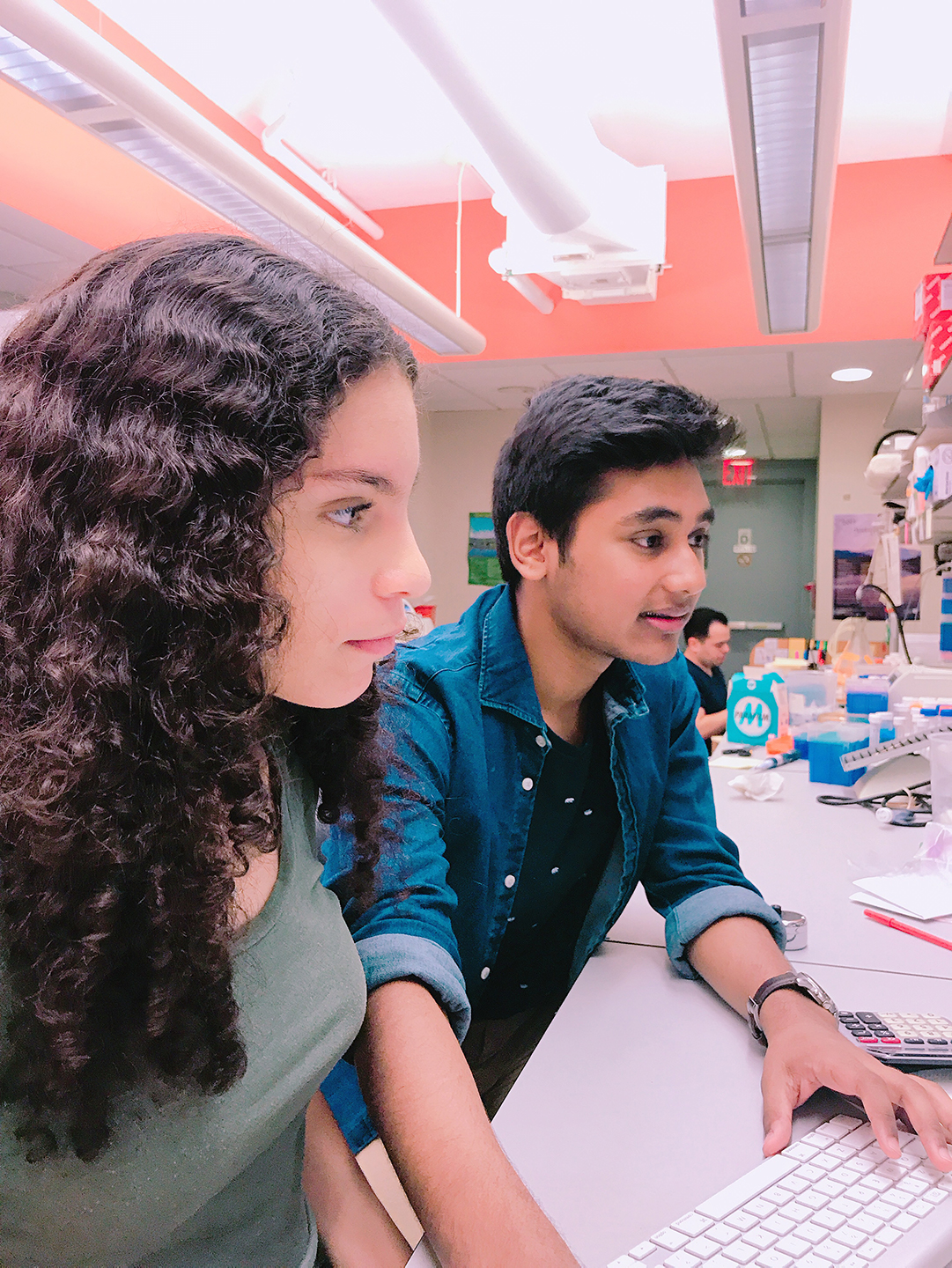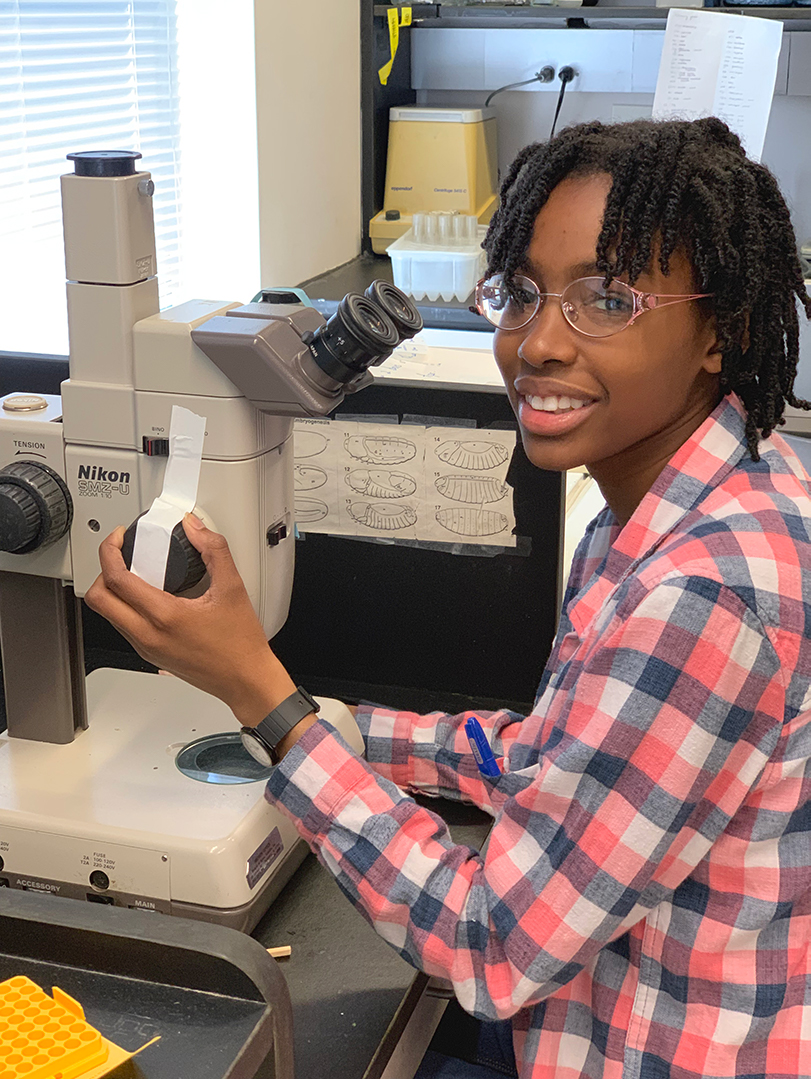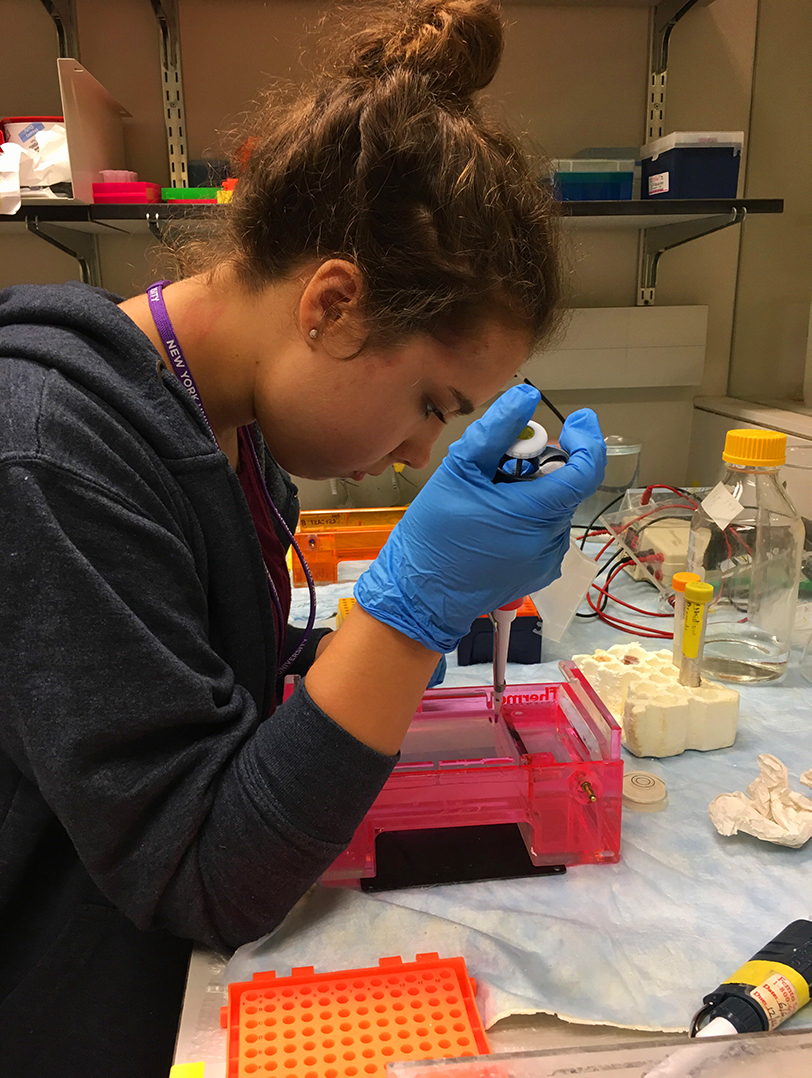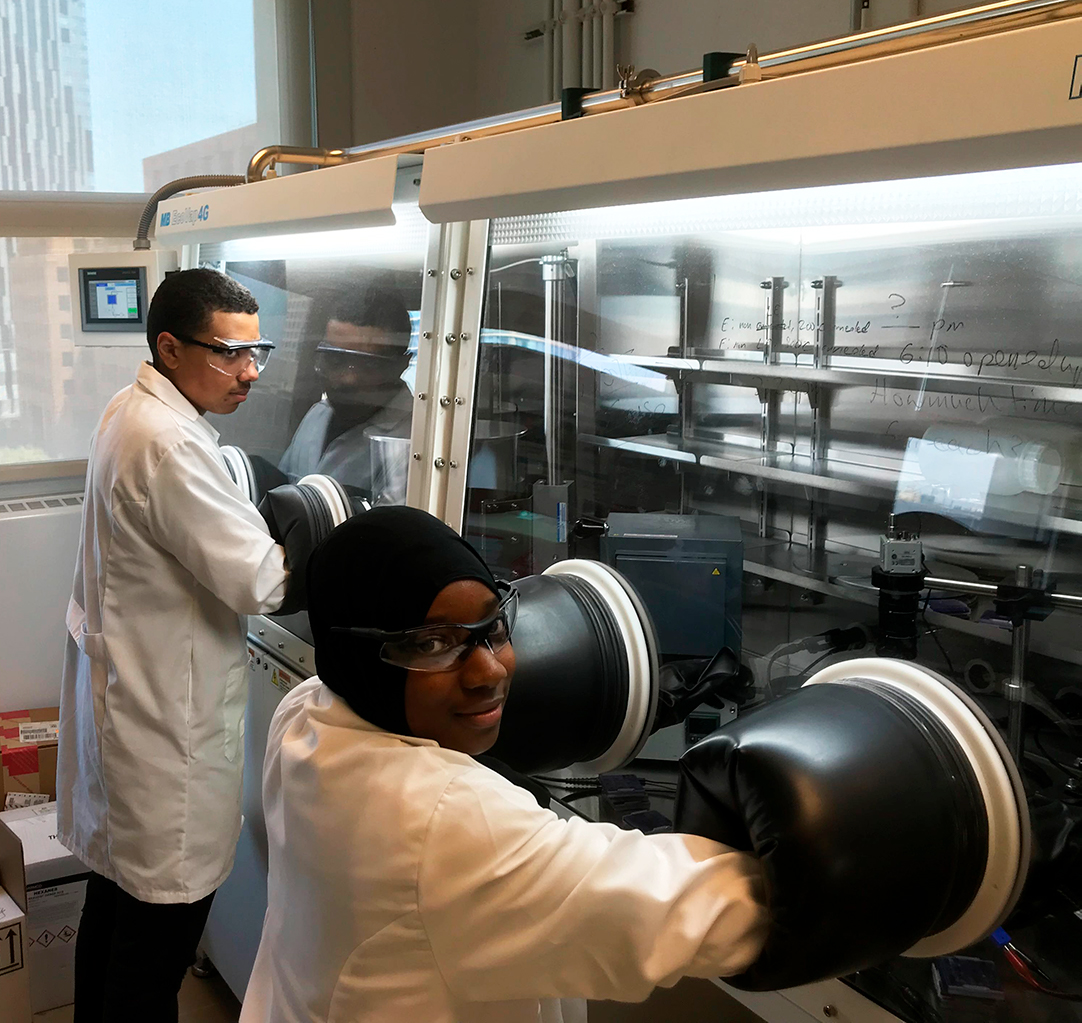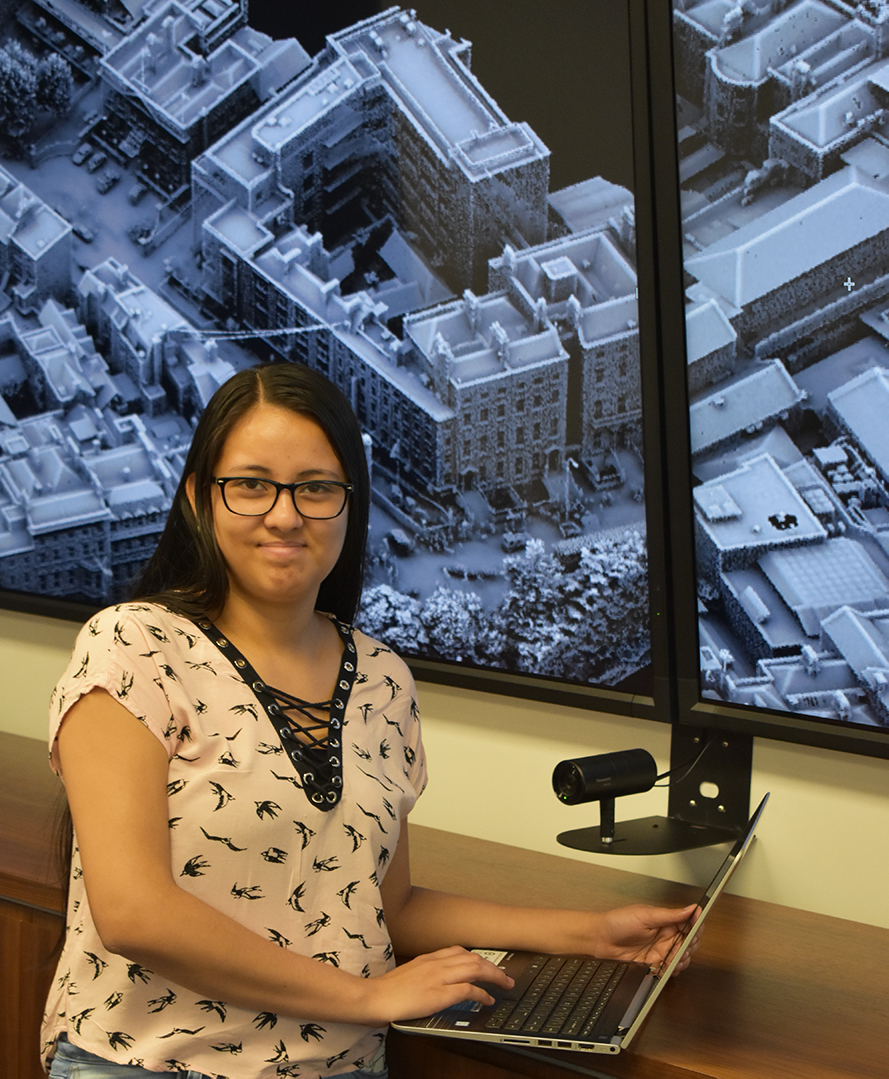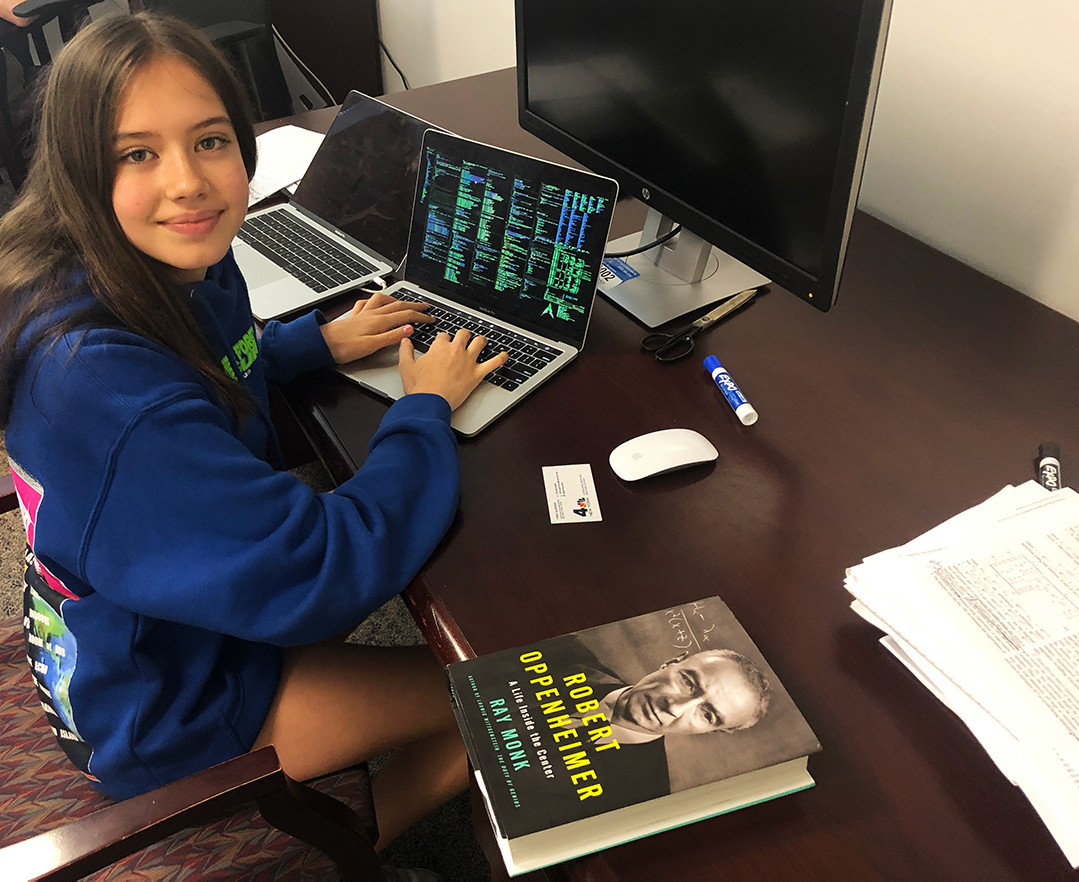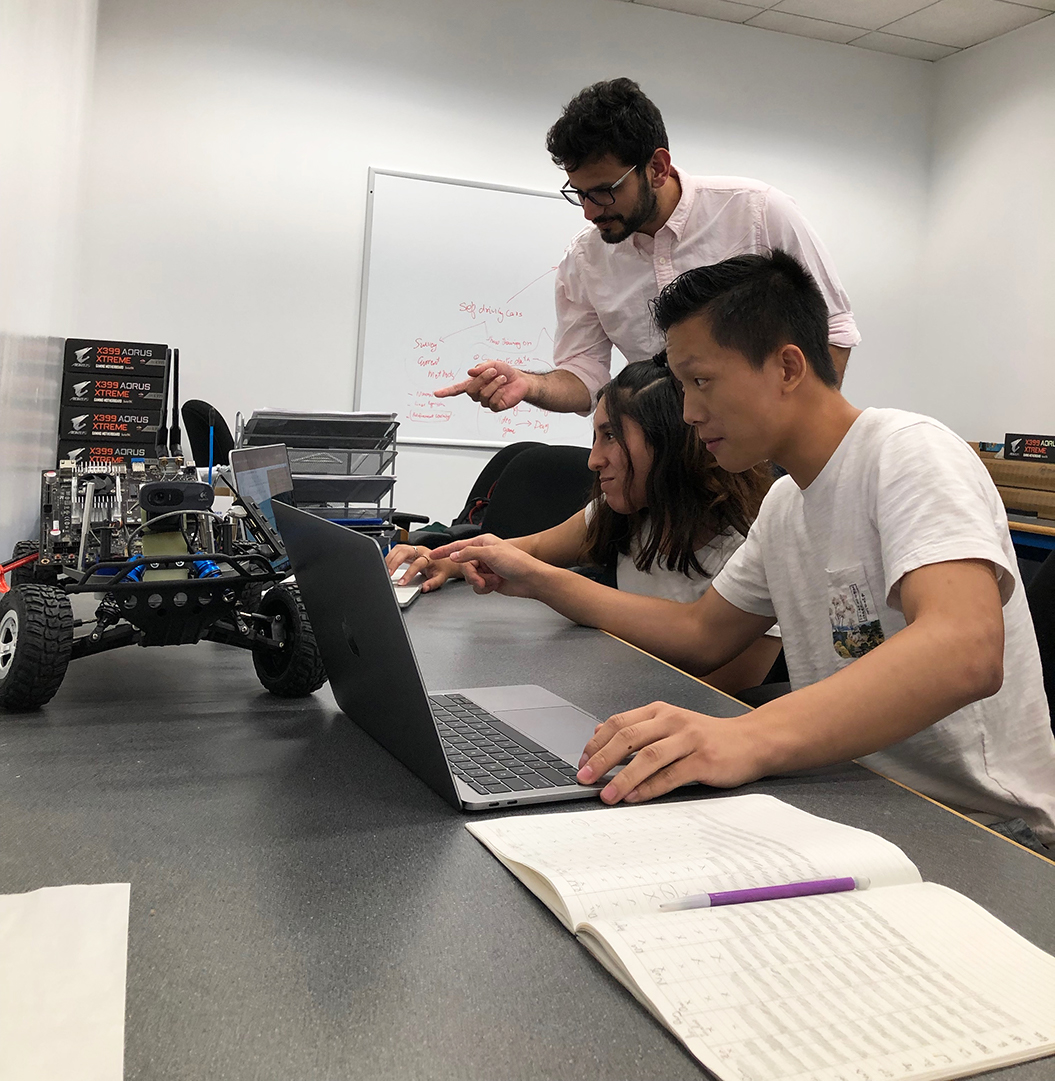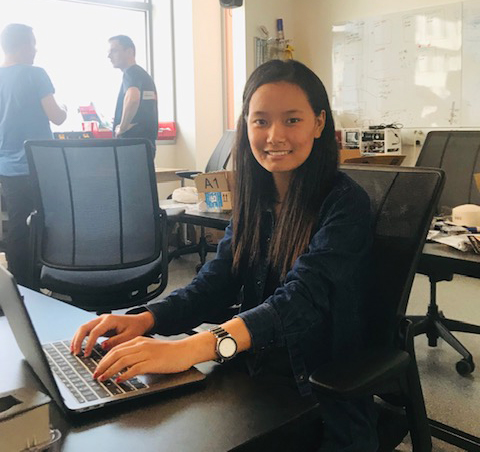ARISE Colloquium Archives
Showcasing our talented students' research within their ARISE labs.

About the Colloquium
Welcome to the ARISE Colloquium. Students representing nearly every field of engineering work intensively in their labs conducting research projects with mentors and faculty, taking full advantage of our NYU Engineering facilities. We are pleased to present the culmination of these efforts and are eager to acknowledge the hard work and dedication of our ARISE classes.
The Center for K12 STEM Education acknowledges and thanks all of the mentors and faculty from 31 labs across the NYU Tandon School of Engineering and the NYU College of Arts and Sciences for their support and engagement given to ARISE and its students. To find out more about these labs and their research, please click here.
2020
Anthropology
Yewande Adesina, Ruqaiya Mithani
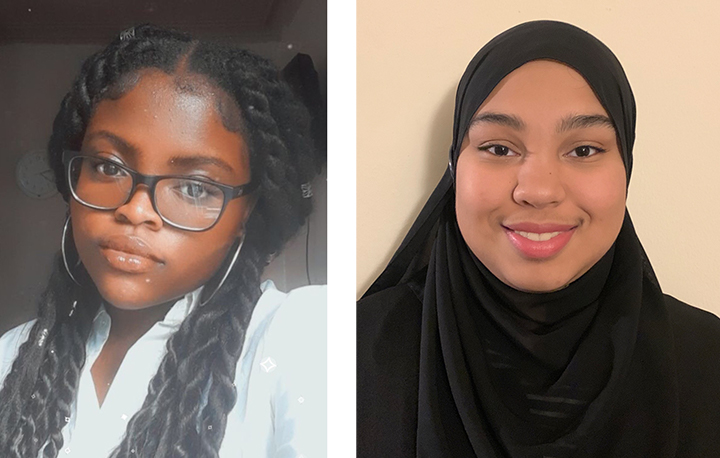
- Lab: Hominin Skeletal Morphology Lab
- Faculty: Professor Scott Williams
- Mentor(s): Jeffrey Spear
- Time: 11:40 am - 12:50 pm
Abstract: Understanding how the last common ancestor (LCA) of chimpanzees and humans moved, and thus the context from which humans’ unique bipedal locomotion evolved, is a major unanswered question in paleoanthropology. Humans’ closest relatives, chimpanzees, bonobos, and gorillas, all move using a combination of knuckle-walking (walking on all four limbs but bearing weight through the back of the middle section of the fingers rather than the fingertips or full hand), vertical climbing (such as shimmying up trunks of trees), and suspension (in which the animal hangs below branches rather than standing on a surface). But fossil evidence and behavioral observations of more distantly related primates have led many researchers to challenge the simplest explanation that the LCA moved similarly to humans’ closest living relatives, the African apes. Here, we quantify the morphology (shape) the distal radius (the part of the forearm that connects with the wrist) from digital scans of 29 living primate taxa as well as two fossil hominins closely related to humans using three-dimensional methods. We explore how the shape of the distal radius differs among primates that use different forms of locomotion, and compare these different shapes to fossil hominins using phylogenetic comparative methods (statistical methods that account for the relationship among taxa). We will use ancestral state reconstruction methods to model the morphology of the LCA. We will test whether the morphology of the distal radius corresponds with different locomotor repertoires in living taxa by comparing Brownian Motion (BM; random evolution) and Ornstein-Uhlenbeck models (OU; evolutionary models based on the assumption that taxa evolve toward a number of adaptive peaks) of evolution. Building on the best-fit evolutionary model based on living taxa, we will test how the fossil taxa and reconstructed LCA fit into the identified adaptive peaks.
Biology
Nolan Shaffer, Sehajpreet Singh

- Lab: Molecular and Cellular Biology Lab
- Faculty: Professor Fei Li
- Mentor(s): Qianhua Dong, Hyoju Ban
Abstract: Centromere is necessary for chromosome segregation during cell division. Kinetochore proteins are assembled on centromeric DNA through the fundamental histone H3 variant, CENP-A. The outer kinetochore proteins, such as Ndc80 and DASH/Dam1 complexes, interact directly with microtubules to segregate chromosomes. In our previous genome-wide visual screening, we found mutations of dad2, spc19, spc34 and dad5 which are the components of DASH/Dam1 complex that affect the distribution of CENP-A in fission yeast. However, we did not find all of the ten components of the DASH/Dam1 complex from the screening. This raises the questions whether the whole complex is required for CENP-A localization; why and how outer kinetochore proteins change the distribution of CENP-A. In this study, we will investigate the CENP-A-GFP distribution, centromere integrity in each of the DASH/Dam1 complex subunit mutants and some of the double or triple mutants. This study may help define the role of the DASH/Dam1 complex in the distribution of CENP-A. Mis-localization of CENP-A can cause severe chromosome segregation defects which results in aneuploidy or cell death. Understanding the mechanism of CENP-A distribution regulated by fungus-specific DASH/Dam1 complex might contribute to developing a potent antifungal drug.
Justin Hohn, Luisa Valdez
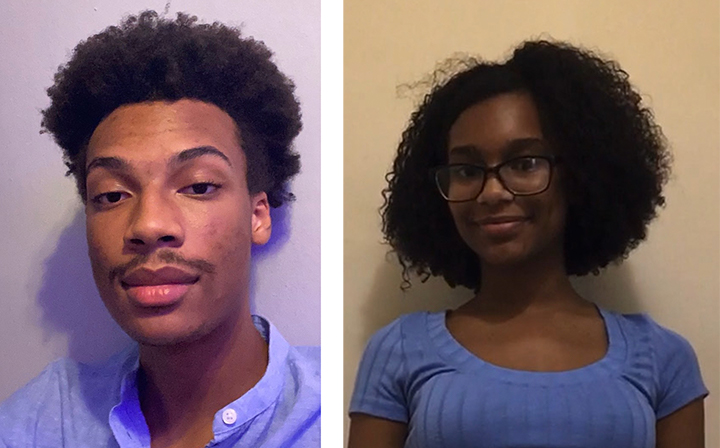
- Lab: Chromatin Genomics [Biology]
- Faculty: Professor Sevinc Ercan
- Mentor(s): David Jimenez, Bhavana Ragipani, Sevinc Ercan
Abstract: Long and linear eukaryotic DNA are packaged and organized inside the cell nucleus. This is done in part by DNA looping, a process mediated by the Structural Maintenance of Chromosomes (SMC) family of protein complexes. Condensins are SMC complexes that compact DNA in preparation for chromosome segregation during cell division. The Ercan lab aims to determine how condensins bind to DNA and function. To do this, the lab uses C. elegans, where a specialized condensin forms the dosage compensation complex (DCC). Dosage compensation is an evolutionarily conserved process that is accomplished in different ways across different species, however the outcome is the same in that it leads to similar levels of expression from X chromosomes between sexes. C. elegans DCC binds specifically to the X chromosomes in XX hermaphrodites to reduce their transcription two-fold, equalizing X expression to that of XO males. DCC is recruited to the X chromosomes at ~60 sites. Proteins that are required to recruit the DCC to these sites are also involved in repressing genes required for male development. We hypothesize that DCC recruitment sites may have evolved near male-specific genes located on the X. To test this hypothesis, we will use our existing data and publicly available databases and tools to determine if the ~60 DCC recruitment sites are found significantly closer to male-specific genes.
Biomedical Engineering
Bariat Bashiru, Maima Islam
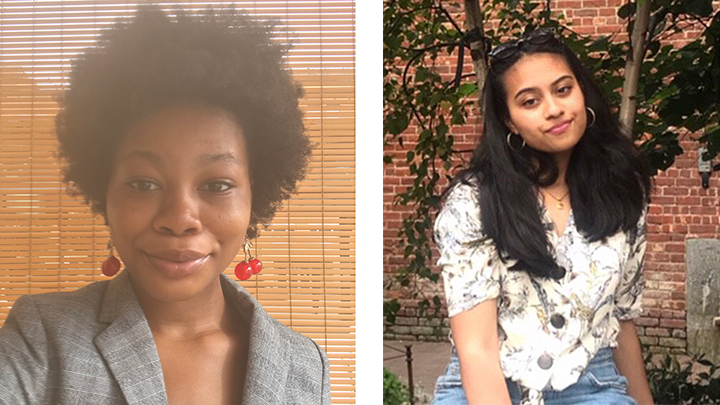
- Lab: Applied Micro-Bioengineering Lab
- Faculty: Professor Weiqiang Chen
- Mentor(s): Apratim Bajpai, Rui Li
Abstract: Mechanical force between cells and microenvironment is increasingly believed to regulate the physiological functions in vascular systems which by nature are highly asymmetrical. However, the impact of intercellular and intracellular forces on vascular asymmetric formation is not completely understood. Here, using micropatterned endothelial cells on mechanical force sensing substrates, we demonstrated that mechanical forces within in-vitro microvascular tissue regulate asymmetric vascular endothelial cell arrangement. Tuning the cell-matrix and cell-cell forces using engineered topographic geometries and pharmacological treatments regulates vascular asymmetric morphogenesis in vitro. A study using mouse diabetic aortic endothelial cells in high extracellular glucose concentrations showed that diseased endothelial cells exhibited abnormal cell alignments, intercellular and intracellular forces. We further studied this phenomenon by modeling the vascular sheets as mechanical force-propelled active particles and confirmed that mechanical force drives asymmetric endothelial cell alignments in different tissue geometry. Together, these findings demonstrate that vascular asymmetric arrangement requires mechanical force induced by both intracellular contractility and intercellular force, and indicate that tissue geometry and mechanical force may serve as the inductive cues for vascular morphogenesis.
Chemical and Biomolecular Engineering
Jibran Khan, Vanessa Lin
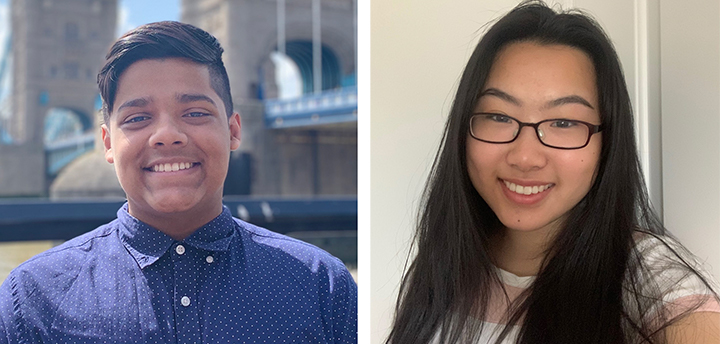
- Lab: Biointerfacial and Diagnostics Lab
- Faculty: Professor Rastislav Levicky
- Mentor(s): Vladislav Frenkel
Abstract: The electromagnetic spectrum consists of a range of light, including the kinds that aren’t visible to the human eye, such as radio waves, microwaves, infrared radiation, ultraviolet rays, and more. The small section of the electromagnetic spectrum that we can see is visible light. White light is a combination of all the colors of the visible light spectrum, with each color having a specific frequency and wavelength. Spectrometers are able to break the light from a single source into its component colors based on their wavelengths. The goal of our project is to build and iterate on a design of a simple spectrometer using household materials such as duct tape and black paper. A spectrometer has three major parts: the slit, the diffraction grating, and the viewing port. The slit allows light to enter the spectrometer, while the viewing port allows you to view the emission spectra. The diffraction grating is made up of angled grooves that produce the spectra based on the diffraction and interference of light. The household spectrometers will be used to analyze different light sources in order to understand how our eyes perceive them. We can then compare different light sources and intensities and see how these factors affect the spectrum that is produced. Furthermore, the spectrometer will be implemented into a larger range of applications, such as passing light through a solution to find the concentration by comparing the transmitted spectra.
Tenzin Choezin
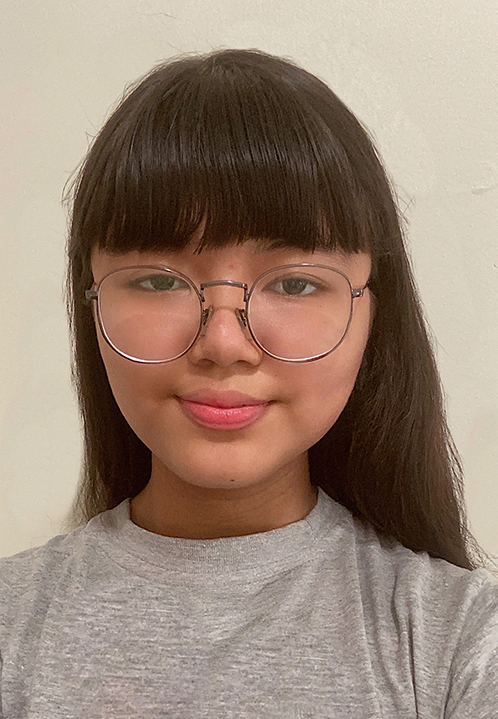
- Lab: Flow Chemistry with Microsystems Laboratory
- Faculty: Professor Ryan Hartman
- Mentor(s): Tianyi Hua
Abstract: Methane hydrate stores tremendous amount of energy which is estimated to be equivalent to twice of all the other fossil fuels combined. In the deep bottom of the ocean, where methane hydrate naturally exists, microbes and worms have established complicated nutritional symbioses. Microbes not only consume and produce methane as their energy source and metabolism waste, but also produce biosurfactants that can catalyze natural gas hydrate formation or dissociation. The stability of methane hydrate is crucial as the release of methane gas from the bottom of the ocean can cause global warming. The focus of this study is to figure out the influence of different biosurfactants on methane hydrate stability. We model the methane hydrate dissociation kinetics with the catalyzation effect offered by these microbes to predict the phase boundary behavior of methane hydrate against temperature fluctuations.
Lizbet Rodriguez, Joshua A. Senior

- Lab: Protein Engineering and Molecular Design Lab
- Faculty: Professor Jin Montclare
- Mentor(s): Jacob Kronenberg
Abstract: Organophosphates, also referred to as OPs, are toxic chemicals used as insecticides. These poisonous chemicals are utilized in both agriculture and military settings. Organophosphates pose substantially harmful effects to both nature and humans; OPs inhibit the activation of cholinesterase, causing acetylcholine to build up in the nerves, resulting in overactive interactions with fatal consequences. Phosphotriesterase (PTE) enzymes have been proven to function to mitigate the impacts of these OPs by operating as biocatalysts, breaking down present organophosphates. Using the computer software Rosetta, we aim to maximize the stability of PTE enzymes, making the protein structures more stable in order to have wider success in its industrial applications. Rosetta allows for the reengineering of PTE enzymes implementing a Monte Carlo Algorithm. This method creates random mutational alterations to PTE enzymes, generating more stable structures that deactivate organophosphates. We will then test out these new generated PTE structures in Rosetta and use PyMol, a protein-modeling interface, to visualize them.
Antara Afroz, Natasha Piedrabuena
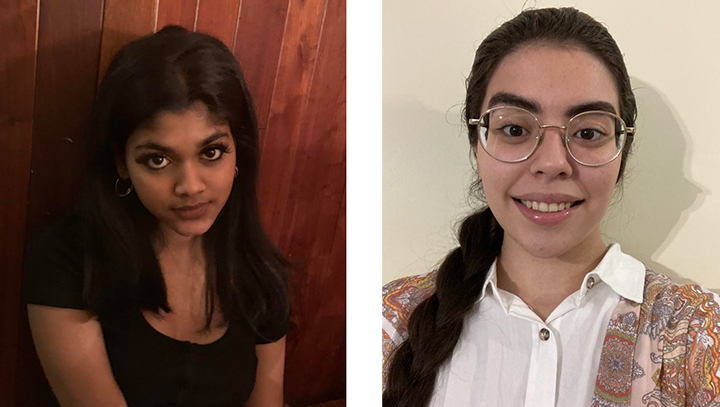
- Lab: Hybrid Nanomaterials Laboratory
- Faculty: Professor Ayaskanta Sahu
- Mentor(s): Ingrid Joylyn Paredes, Steven Farrell, Haripriya Kannan
Abstract:
Sustainable energy is one of the most pressing issues that society faces today. With traditional materials reaching their performance limits, the development of new materials will lead us to meet the global demand for energy in a clean and sustainable fashion. Hybrid materials are an emerging class of compounds that combine inorganic and organic components to produce materials with performance greater than the sum of their parts. Our lab seeks to gain fundamental understanding of the electronic and thermal properties of these hybrid systems. We will do this via the synthesis and characterization of hybrid materials, looking at the effect of composition, size, and shape on thermal and electronic properties. Once reliable methodologies for synthesis have been developed, we will implement our materials into devices including light emitting diodes, solar cells, and thermoelectric coolers.
Civil and Urban Engineering
Nyah Smith, David Ugo-Omenukwa
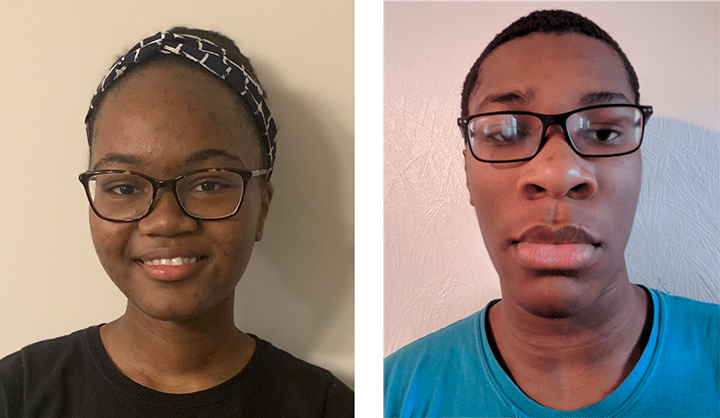
- Lab: Future Building Informatics and Visualization Lab (biLAB)
- Faculty: Professor Semiha Ergan
- Mentor(s): Zhengbo Zou, Daniel Bin Lu, Xinran Yu
Abstract: People, on average, spend 90% of their time indoors. However, our static environments do not currently have the capabilities to change and adapt themselves in order to match our emotional needs. They are not “smart” enough to recognize and respond to our changing emotional stimuli, to soothe and comfort us in times of distress, possibly harming our mental health in the long term. Despite the promising outcome from previous research efforts in obtaining physiological data from visual stimuli, there is still a fundamental gap between obtaining this physiological data and using it to predict the emotions of the user. Furthermore, there is also a lack of research in the area of using emotion detection and recognition of occupants to modify the indoor environment accordingly. This paper aims to rectify both of these gaps by first using Electroencephalography (EEG) signals to measure and infer emotions through machine learning models, and then use them to promptly modify architectural design features using adaptive VR environment setups.
Subah Mahbub, Raina Plaisir
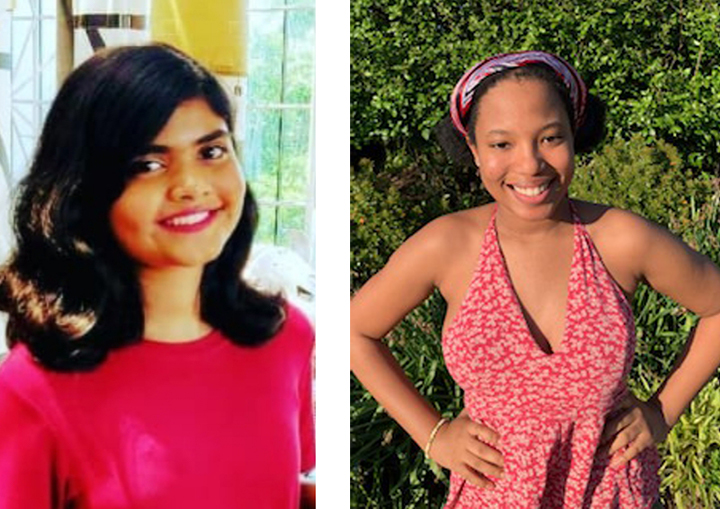
- Lab: Environmental Engineering and Water Treatment Laboratory
- Faculty: Professor Andrea Silverman
- Mentor(s): Mwale Chiyenge, Catherine Hoar
Abstract: Combined sewer systems found in cities like New York collect and convey both stormwater runoff and sewage water in a single system. During high intensity rain events, these systems may become overburdened and backlogged, resulting in street-level flooding. This floodwater often contains sewage and its contaminants, including harmful fecal-related bacteria. To explain the impact of such flooding, we are conducting a literature review on the impacts of fecal pollution on urban surfaces with the goal of designing experiments to investigate the deposition and die-off of sewage-related bacteria on flood-impacted surfaces. This literature review is essential as flooding is on the rise due to climate change. With more frequent heavy rainfall events we expect to see increased discharge of sewage-containing water directly to the environment. The literature review will help us develop a standard methodology that our lab can use to study the impacts of bacteria deposited on urban surfaces after a flood on the microbiome of these surfaces. In conclusion, the ultimate goal of this review is to raise awareness of the potential risks regarding bacteria deposition on urban surfaces from combined sewer flood water and to motivate people to understand the potential health hazards related to this issue.
Jillian Darcy
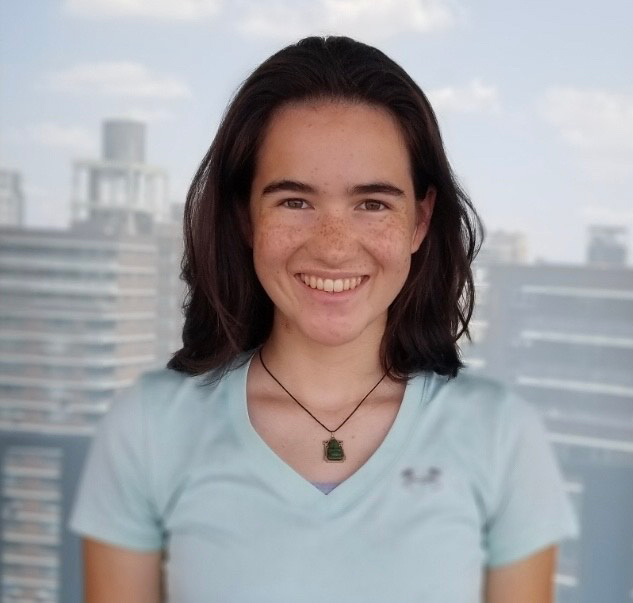
- Lab: Behavioral Urban Informatics, Logistics, and Transport (BUILT) Lab
- Faculty: Professor Joseph Chow
- Mentor(s): Srushti Rath
Abstract: The open-source Multi-Agent Transport Simulation (MATSim) Virtual Testbed developed by C2SMART simulates an 8-million-person population covering the entire New York City (NYC). The virtual testbed that integrates various transportation modes including cars, trains, bus, bikeshare, taxi, and other for-hire vehicles that can be used by policy makers for planning and decision-making purposes. There is a growing need to evaluate urban last mile deliveries and use of cargo bikes in reducing air pollution and congestion. This project aims to gather data for freight demand that can be incorporated in the simulation testbed along with emerging mobility technologies. Using the existing freight flow data (obtained by the team from NYMTC’s Best Practice Model) the objective is to collect incoming commodity flows from various Freight Analysis Framework (FAF) zones to NYC for different years. We will analyze aggregate demand data to adjust freight flows between different origin-destination pairs in NYC as per requirements of the MATSim testbed. We will be using the Quantum Geographic Information System (QGIS) tool (free and open source) for spatial analysis, studying demand patterns and for visualization purposes.
Mahia Chowdhury
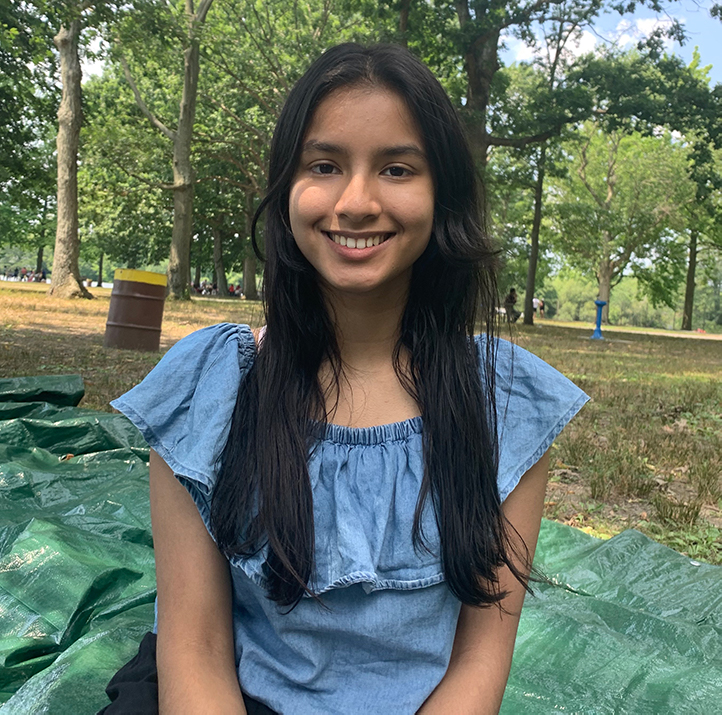
- Lab: Urban Modeling Group
- Faculty: Professor Debra Laefer
- Mentor(s): Debra Laefer, Frank Jiang
Abstract: Destination as a Predictor of Touch Behavior during NYC’s COVID-19 PAUSE Order This research investigates the touch behavior of individuals exiting hospitals based on their final destination. Specifically, this study considers the number and type of items touched for those who went to restaurants versus those who went grocery stores. Both choice of destination and specific touch behaviors are considered over a nearly two-month period from Mar. 22 - May 19, 2020 at the peak of the COVID-19 outbreak in New York City. The objects touched were split into five categories: “stationary environmental objects,” “personal objects,” “self,” and “shared objects.” Preliminary results indicate that people going to restaurants touched more objects than those going to grocery stores. This behavior was in part correlated to the time to the destination. The final analysis will consider a touch per minute score and a gender breakdown of the data.
Sakeef Kibria, Sardorbek Rahmatulloev
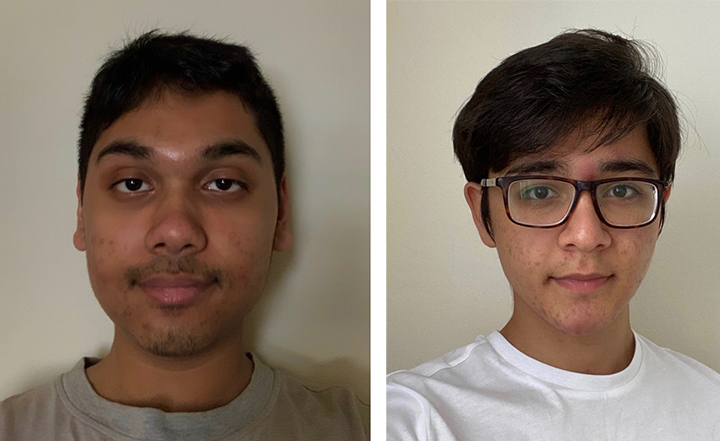
- Lab: UrbanMITS
- Faculty: Professor Kaan Ozbay
- Mentor(s): Suzana Duran Bernardes, Jingqin Gao
Abstract: The COVID-19 pandemic has disrupted transportation in New York City including: transit, private vehicles, ride-sharing, and bike-sharing. To better understand the effects of COVID-19 on a specific mode of transportation we focused on the bike-sharing system because of its growing popularity in urban cities around the world. During the early stages of COVID-19 bike-sharing in New York City had a peak in ridership. However, with the enforcement of social distancing and the stay-at-home order, the access to Citi Bike bikes had been limited, which has decreased bike usage and mobility around the city. To study this infrastructure, we hope to gather data from the Citi Bike database. We plan to use programming and data management tools, such as Python, SQL, and Pandas to depict bike usage trends prior to and throughout the pandemic. Additionally, we plan on identifying any fluctuations in bicycle “hotspots,” popular destinations, throughout the city. A possible method to locate hotspots is through the Citi Bike database and map oriented routes. We will also make use of extensive literature review to help us understand the main changes in behavior due to the pandemic. We hope this research will help contribute to our understanding of how the bike-sharing system functions and adapts to situations that impede transportation. Ultimately, our results will be used in the ongoing research on the impacts of COVID-19 on New York City’s transportation network performed by the UrbanMITS laboratory in conjunction with the C2SMART Center.
Naomi Sergew
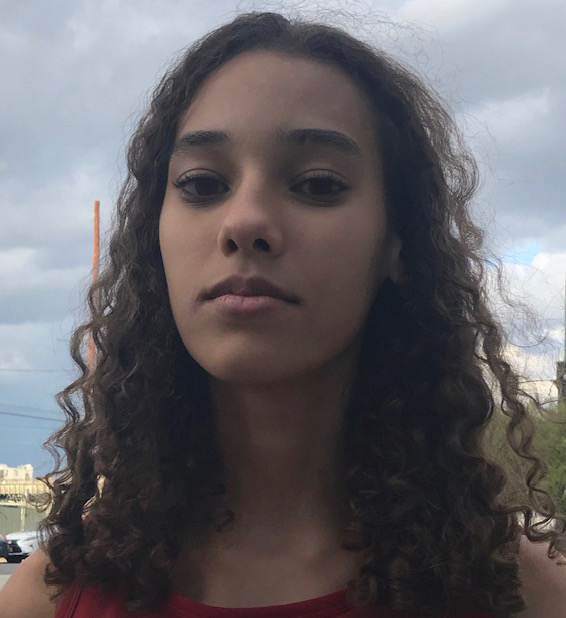
- Lab: Behavioral Urban Informatics, Logistics, and Transport (BUILT) Laboratory
- Faculty: Professor Joseph Chow
- Mentor(s): Srushti Rath
Abstract: On-demand microtransit services have the potential to complement transit services allowing cities to provide flexible and convenient transportation options. Such services can improve accessibility to stations and destinations while helping people access jobs, education, healthcare, and social activities. The performance of various microtransit operations in different cities may be influenced by the city characteristics. The project seeks to gather socio-demographic, economic, housing, commute, and employment data (on census tract level) from American Community Survey (U.S Census Bureau) databases across different cities. In addition, the city boundaries, street network and transit network geo-spatial data will be collected. We will be using the free and open source Quantum Geographic Information System (QGIS) software to visualize aggregate information. The combination of all the city-level attributes collected for multiple cities can be used to build appropriate models for studying the demand and analyzing performance of different microtransit operations in a city.
Computer Science and Engineering
Yarileldy Payano, Emma Pereira
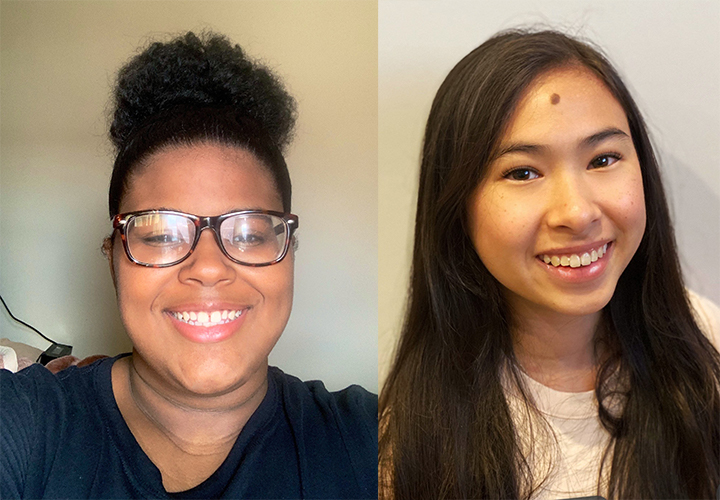
- Lab: Privacy and Security Automation Lab (PSAL)
- Faculty: Professor Rachel Greenstadt
- Mentor(s): Kejsi Take, Cameron Ballard
Abstract: With the increased use of social media platforms, misinformation has made its way into almost all aspects of society. Twitter, being one of these platforms, allows users to center their tweets around popular issues through hashtags. We focused our analysis on the use of misleading hashtags that further the spread of disinformation. In this study, we chose two prevalent topics like American politics and climate change to describe how misinformation is spread. We gathered tweets associated with common search terms for each topic and selected a subset for manual analysis. Our research proposes a method of classifying tweets with specific hashtags to measure their influence in its intended community. By identifying the content that receives the most attention we hope to illustrate what kinds of false information are most impactful across different platforms and issues.
Max Shalom
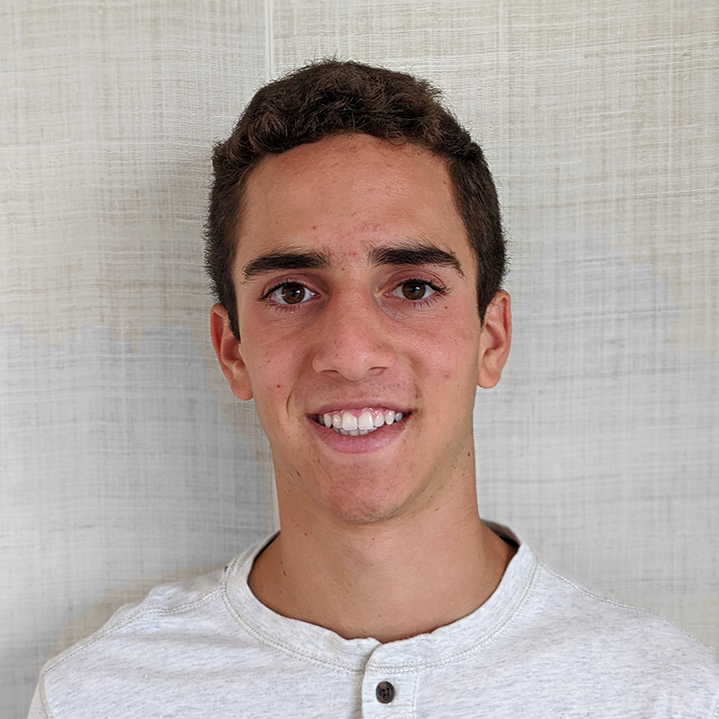
- Lab: Chunara Lab
- Faculty: Professor Rumi Chunara
- Mentor(s): Yuan Zhao, Vishwali Mhasawade
Abstract:
Populations in low socioeconomic communities and geographies usually have a higher burden of cardiovascular diseases (CVD). Using data from the national representative surveys we can disentangle the clustering effect of social determinants within individuals and their association with CVD outcomes. Additionally, we can pinpoint at which factors such as education level, poverty, and malnutrition, are most vital to improving upon urgently to have early prevention and reduce the burden of CVDs in the population. The aim, specifically, is to use data provided by the National Health Interview Survey (NHIS) to assess the association between individual and community-level social determinants and CVD, including heart disease and stroke, and use regression and machine learning methods to predict CVD using social determinants. To do this we will become familiar with Python coding, such as Pandas, NumPy and svm in scikit-learn packages to effectively make a summary of the data, such as getting the percentage of categorical variables (ethnicity, marital status), mean for continuous variables (age, income, etc.), plotting the data and make predictions.
Nina Piesanen

- Lab: Visualization and Data Analytics
- Faculty: Professor Enrico Bertini
- Mentor(s): Daniel Kerrigan
Abstract:
One common machine learning task is to train a model to classify a data point. The model users may want to know why a model made the prediction that it did. That is, they want to be able to interpret the model or see explanations for its predictions. One particular kind of explanation is a counterfactual, which shows how a data point can be changed in order for the model to assign it a different label. Often with counterfactuals, we are interested in what the smallest change is in order to cause the model to change its prediction. In this project, we will develop a tool that lets users explore counterfactual explanations for a given dataset and ML model. We want this tool to allow the user to select an instance from their dataset, generate counterfactuals for that instance, and visually compare the instance with the counterfactuals.
Sydney Ho
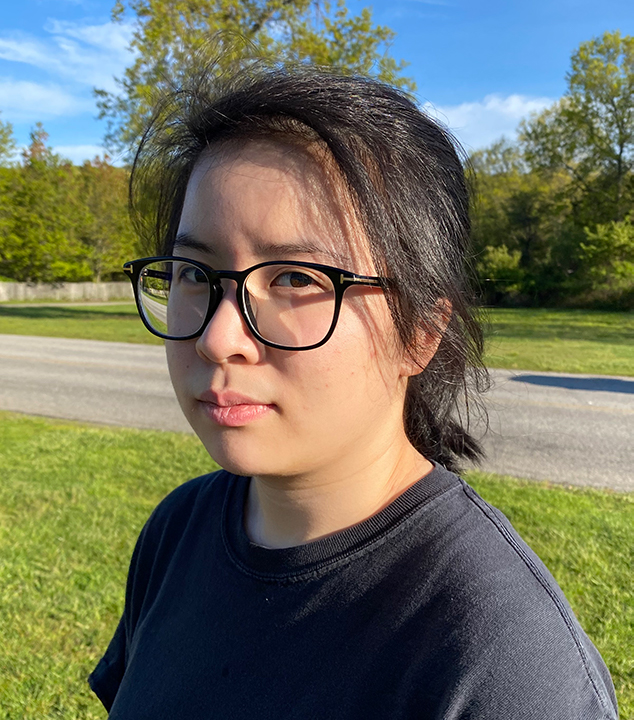
- Lab: Visualization and Data Analytics
- Faculty: Professor Enrico Bertini
- Mentor(s): Jun Yuan
Abstract: The analysis of text data remains a challenge for their intrinsic high dimensionality and the difficulty of providing context and semantics. With the help of visualization and machine learning models, analysts can understand a collection of documents more effectively and more efficiently. By conducting exploratory data analysis (EDA) on a set of documents, especially text grouping and comparison, analysts can generate a lot of insights to support further research on the text data. In this research, we focus on a collection of abstracts from IEEE Visualization publications and apply clustering algorithms to the text data. Then we construct a few visualizations to analyze how the publication content evolves over time, and how the research topics in different tracks are different from each other.
Electrical Engineering
Jessica McDonald
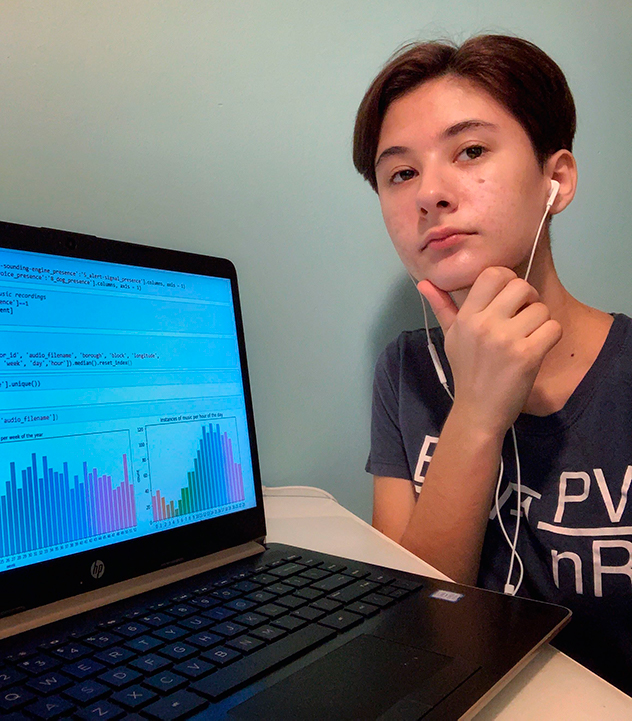
- Lab: MARL
- Faculty: Professor Juan Bello
- Mentor(s): Magdalena Fuentes, Charlie Mydlarz
Abstract: The Sounds of New York City (SONYC) project has recorded more than 50 years' worth of audio data from around New York City. Microphones throughout the city have picked up audio in order to better understand the frequency, volume, and specific types of noise, and to apply that knowledge to relevant projects dealing with traffic, noise complaints, and more. Once they are recorded, the ten-second audio clips are annotated by volunteers through the Zooniverse platform, who label the sounds they hear. The audio data tells us a lot about the dynamics of the city, including when people are the loudest, traffic, and music played on the streets of the city. However, the music aspect of the SONYC dataset has not been previously explored. This research focuses on creating a curated dataset of music played throughout the city using the SONYC dataset. To do this, we sorted the audio using the volunteer annotations and filtered out irrelevant audio clips (i.e., ones with no music present), and analyzed temporal trends in the data. The goal of this project is to make a useful dataset that can be used for further research and/or machine learning surrounding music in New York City.
Uchechukwu Uwanaka

- Lab: Machines in Motion Laboratory
- Faculty: Professor Ludovic Righetti
- Mentor(s): Sebastien Kleff, Avadesh Meduri
Abstract: As several advancements in technology appear everyday, scientists and engineers are constantly looking for ways to employ these new systems in the most efficient way possible. The rise in autonomy for robots is one instance. With increased autonomy, robots can be used in transportation, power supply, and fault recognition/recovery. The emerging method of multi-agent systems (MAS), with the potential for maximum autonomy, became an option against the previous object-oriented programming. Many articles have delved into this idea, accurately describing the architecture, software, and comparisons that arose. However, some articles fail to provide a sufficient review of MAS without bias and conflicts of interest. This is seen with the article, “A decentralized multi-agent control approach for robust robot plan execution” by Li P, Yang S and Wang S.” that we evaluated in this poster. This article fails to provide a good comparison between MAS and object-oriented systems, by focusing less on the challenges of MAS and variations in its software. This oversight is attributed to a conflict of interest on the part of one of the researchers. In this poster through examining other works on the topic, we provide an effective review of MAS and a corrected comparison with object-oriented systems.
Daisy Roberts
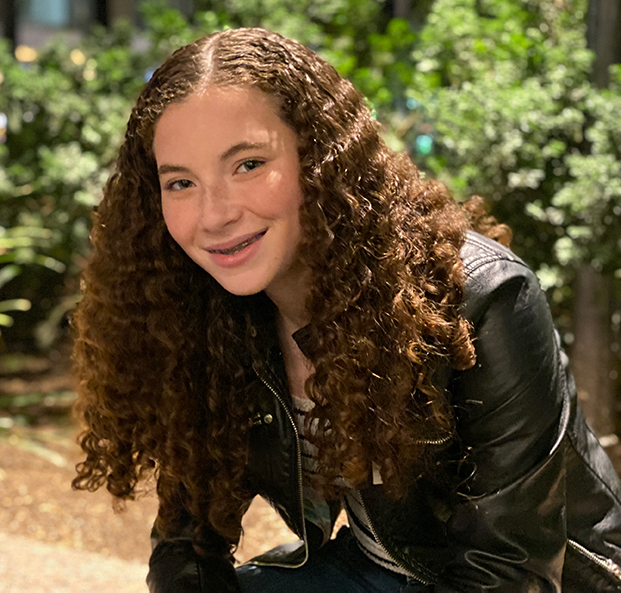
- Lab: Center for Advanced Technology in Telecommunications (CATT)
- Faculty: Prof. Shivendra Panwar
- Mentor(s): Fraida Fund, Ashutosh Srivastava
Abstract: COVID-19 has made home network performance especially critical, as people now rely more on Internet access to carry out their day-to-day activities. However, many people in the United States do not have access to high-quality networks, and especially to networks with low delay. A variety of techniques have been proposed by researchers to reduce network delay, which could potentially improve the quality of experience for Internet users who lack access to high-quality home broadband. One such protocol, called Copa, has shown promise in improving network performance for users with the "worst" connections, in preliminary tests by Facebook. I will build on those results, and investigate the extent to which Copa helps improve network performance for users who do not have access to high-quality home broadband, and whether it has potential to narrow the digital divide.
Ilona Lameka, Eileen Ye
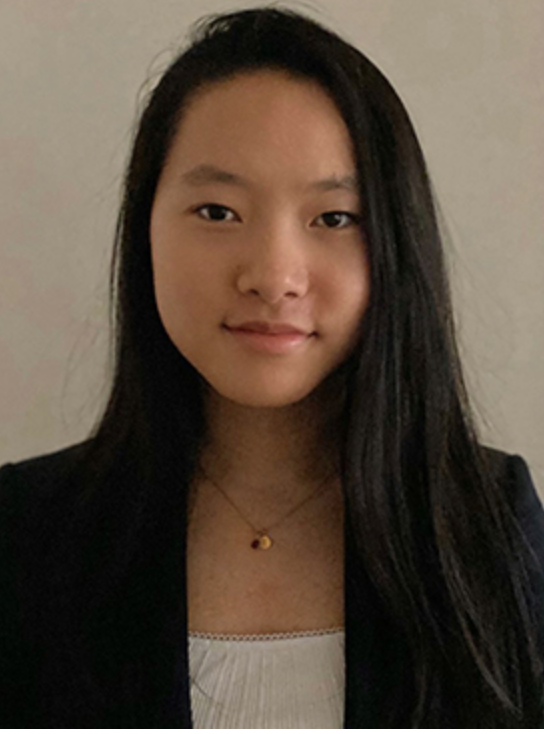
- Lab: Smart Energy Research (SEARCH) Group
- Faculty: Professor Yury Dvorkin
- Mentor(s): Yury Dvorkin, Jip Kim, Anwar Khan
Abstract: Power outages in energy systems are unavoidable, despite the best effort of electric power utilities, and pose many risks to people living in cities. Those with certain medical or living conditions, especially heat-related problems like hypothermia, are affected by the inability to turn on an AC unit and will be hurt the most during a power outage. These electricity vulnerable people need their loss of electricity to be attended to first in the case of a widespread failure of electricity supply. To research and address this issue, we will use socio-demographic data to identify electricity vulnerable population groups and overlay these groups with Con-Edison’s power outage map in real-time. More specifically, we will identify the factors to determine electricity vulnerable people and find, refine, and use available data streams about New York City to categorize and rank various groups of vulnerabilities across all parts of the city. Using these factors, we will design and implement a ranking algorithm for repair crews to use when there is limited repair staff, as is the case during the COVID-19 pandemic. This ranking in combination with live power outage data in New York City will create a tool that can be used in real-time by Con-Edison and various city’s agencies to assist electricity vulnerable people across the city.
Ayan Cooper
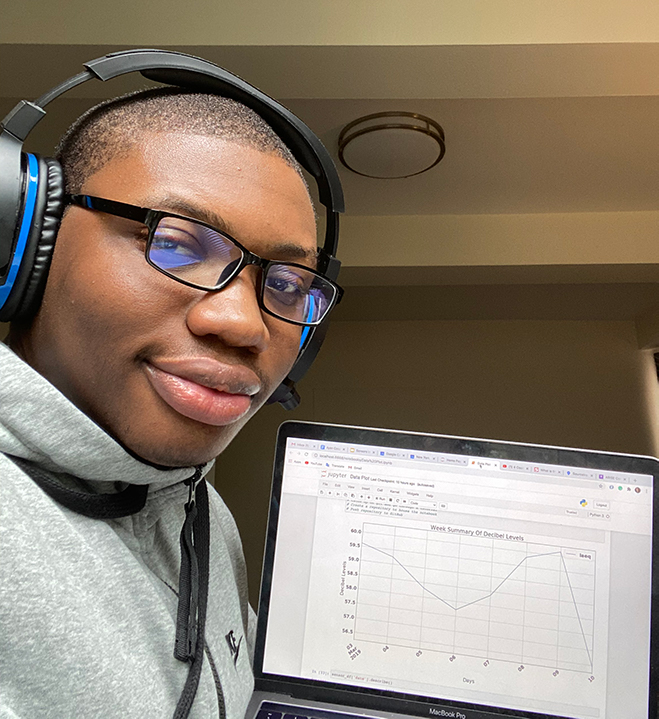
- Lab: MARL
- Faculty: Professor Juan Bello
- Mentor(s): Charlie Mydlarz, Magdalena Fuentes
Abstract:
Noise pollution, which is widespread harmful noise levels, is a significant problem in urban areas across the United States. Estimates show that 9 out of 10 adults in New York City are exposed to immoderate noise levels, which extends across NYC’s 8.7 million residents. The Music And Audio Research Lab (MARL) and the Sounds Of New York City (SONYC)’s research is focused on tracking noise levels throughout NYC with the use of multiple sensors. Starting in March of 2017, SONYC’s goal is to identify what makes the city so loud, and how to use research to help those with noise issues understand their environment in terms of sound. In this project, we want to design a pipeline for the summarization and visualization of urban sound data in a way that helps residents of the city and city agencies better understand noise to enforce better NYC health policies. To do so, we examine hundreds of thousands of data points containing the measurement of Sound Pressure Level (SPL) and study its evolution over time at different temporal scales and locations.
Tammy Li, Stephan McGlashan
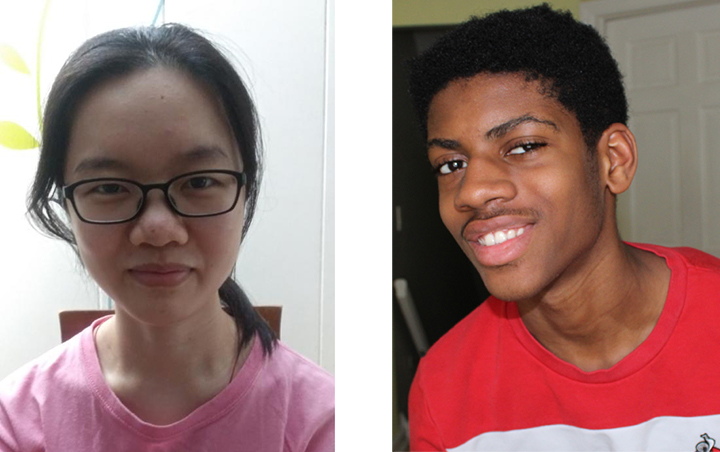
- Lab: ECE Machine Learning Lab
- Faculty: Professor Anna Choromanska
- Mentor(s): Apoorva Nandini Saridena
Abstract: The field of self driving cars is being widely explored by researchers and companies, and much has been accomplished in this area already, of which Machine Learning is a huge part. We call our project “Training to Drive”. This project aims to understand the power of advanced Machine Learning algorithms such as Deep Learning, Supervised Learning by training a deep neural network to learn mapping from sensor data such as input images of road ahead of car to the car control commands such as steering wheel angle. We see rapid changes in the automobile industry especially in the last decade with the advancement of the Machine Learning field, new approaches are being developed to develop the driverless-cars to fix problems in existing approaches, in Training to Drive project, we hope to study one such approach that is popular widely i.e., end-to-end Deep Learning and Supervised Learning class of approaches and understand their limitations. The study is going to be empirical, so we collect data using an open-source driving simulator called Carla, which is a great software that allows us to collect driving data in realistic looking driving environments such as cities, different weather conditions, different road types, etc., and allow us to validate the developed models by deploying it in real-time simulation where we control the navigation of autonomous driving cars.
Edrick Torres

- Lab: Machines in Motion
- Faculty: Professor Ludovic Righetti
- Mentor(s): Sebastien Kleff, Avadesh Meduri
Abstract: In today's world technology has gone through many advancements and scientists all over the world spend night and day trying to make the world an easier and better place to live. With the rising advancements of autonomous robots, the dream of a better world is slowly becoming a reality. But some scientists in this community have abused the system to push studies that are not ready yet. This is seen in the Peer review scandal of the “Journal of Vibration and Control”. In this Scandal, 60 scientific research papers were retracted because of a flawed peer review system where the authors of these studies had used fake identities to review their work and have them published without going through actual peer review. This was a major blow to members of the scientific community and demonstrated that only a few flawed individuals can give the scientific community a bad reputation. The 60 retracted papers show a big regression in the field of robotics and had the publication be legitimate, The scientific community and the world would be that much closer to a better world. This project will show the flaws in what these authors did and will demonstrate the correct and detailed way in which peer review should take place.
Mechanical Engineering
Andy Huang
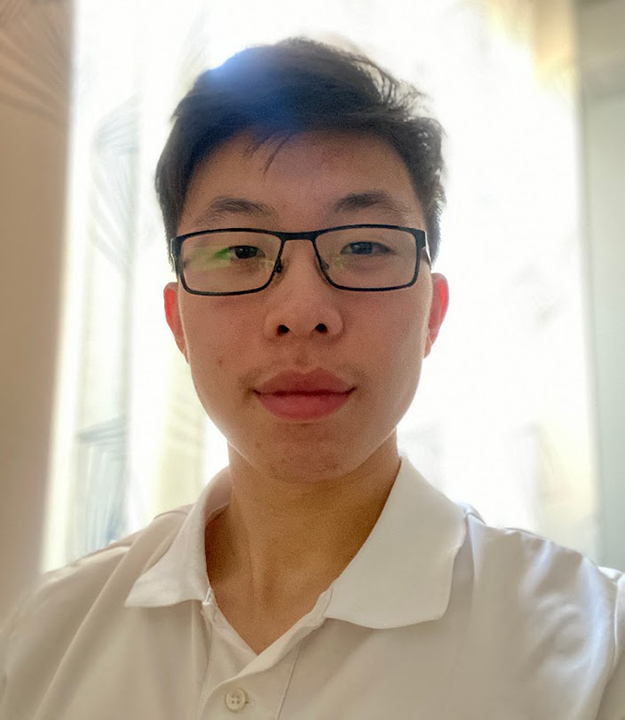
- Lab: Composite Materials and Mechanics Lab
- Faculty: Professor Nikhil Gupta
- Mentor(s): Gary Mac
Abstract: The advancements in 3D printing technology have revolutionized the additive manufacturing industry and the process has been adopted across all aspects of the industry. The 3D printing process involves converting a Computer-Aided Design (CAD) file to a format readable by the printer and the printer will build the part layer by layer. Fused deposition modeling (FDM) printers is the most common method of 3D printing and it is widely used by both consumer-oriented product designers and hobbyists. The unique characteristic of being a cyber-physical system and layer by layer build method allows malicious actors to embed hidden defects into the design without detection. Along with hidden defects, other risks exist that may cause harm to the cyber-physical environment. To examine the potential risks, the mechanical testing of objects with controlled internal defects, such as depositing filler material instead of modeling material at the defect site, were used and printing orientation was altered: printed in the x-direction, z-direction and 45°-direction. The potential for lower strength and detection evasion was measured with finite element analysis and ultrasonic inspection. Additionally, cyber-security breaches also pose as another threat. Statistical methods are able to approximate security breach possibilities but recent HACK3D hackathons have proved that skilled hackers are able to launch innovative cyber and physical attacks. A series of HACK3D challenges were given to participants as a form of crowdsourcing, and were used to investigate the attacks and study the pathway in threat taxonomy. In the end, the results confirm that securing 3D-printing cyber-physical systems is an extremely difficult task.
Edwil Philippe
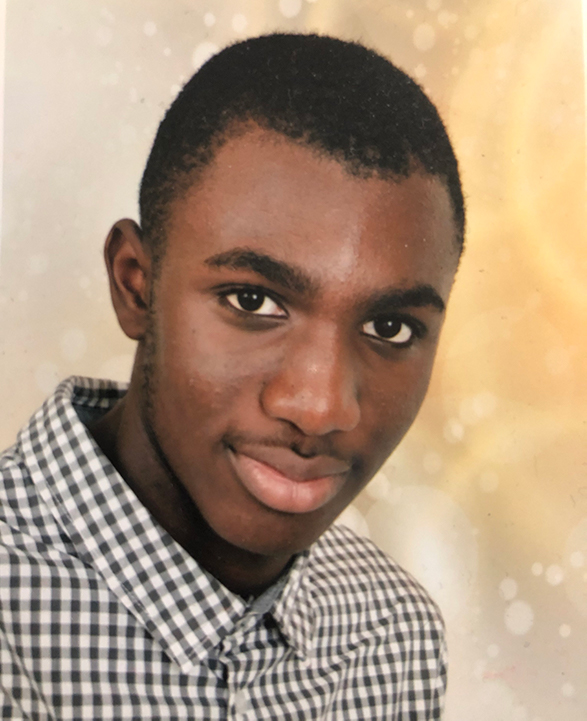
- Lab: Dynamical Systems Laboratory
- Faculty: Professor Maurizio Porfiri
- Mentor(s): Mert Karakaya, Roni Barak Ventura
Abstract: Electronic waste (E-waste) represents more than 70% of the overall toxic waste in the United States. Even though a large amount of E-waste consists of reusable working electronic parts, E-waste is typically not recycled for the production of new technological devices. In this project, we salvage E-waste parts and build a robotic fish. The robot’s movement is controlled with an interactive phone application, connected via bluetooth. The robot will be used for educational purposes, demonstrating to the public the ubiquity of engineering and innovation, and robotics in particular.
Anaya Bussey
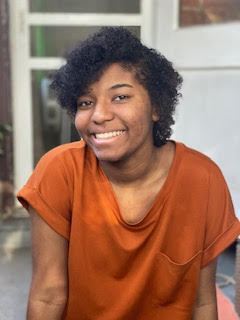
- Lab: Mechatronics, Controls, and Robotics Lab
- Faculty: Professor Vikram Kapila
- Mentor(s): Hassam Khan Wazir
Abstract: Cerebrospinal Fluid (CSF) is a clear, colorless, watery fluid that is found between the brain and spinal cord. CSF is used to help the brain with protection, nourishment, and waste removal. CSF has two different kinds such as, interleukin-6(IL-6) and interleukin-8(IL-8) which are found in all people. However, information regarding the geriatric population (ages 70 and up) and their levels of CSF IL-6 and IL-8 is sparse. In this retracted study, the researchers show an association between CSF IL-6 and IL-8 and depression in a geriatric population-based sample. Originally, the authors found that women with ongoing major or minor depression had lower levels of CSF IL-6 and IL-8 compared to women without depression. However, the paper was retracted upon the authors’ request because two spreadsheets with mismatching ID codes were merged by mistake and the conclusion was drawn based on the results of that data. The paper was republished after the researchers rectified the mistakes. The new conclusion was that women with ongoing major or minor depression had higher levels of CSF IL-6 and IL-8 compared to women without depression. Nine other women developed depression during follow-ups, but there was no correlation between their depression and their CSF IL-6 and IL-8 levels. The results demonstrate that if a female member of the geriatric population has higher levels of CSF IL-6 and IL-8 as compared to an average female member with no depression, there is a possibility that they may have ongoing minor or major depression. However, if the depression is recently developed, it will not automatically show in their CSF levels. This experiment is a starting point to analyze the CSF levels in members of the geriatric population and the researchers concluded that CSF IL-6 and IL-8 may play a role in depression later in life.
Nancy Khosla
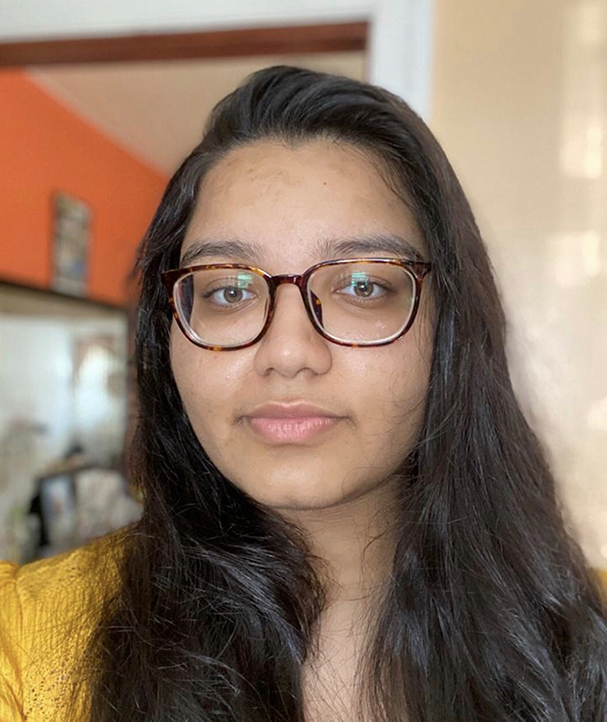
- Lab: Mechatronics, Controls, and Robotics Lab
- Faculty: Professor Vikram Kapila
- Mentor(s): Hassam Khan Wazir
Abstract: Walking is a very challenging task for robots and the problem of foot placement in particular, has been studied extensively. The retracted study considered for this project, proposed a novel control algorithm for finding the optimal step time and location for the robot to achieve a suitable walking gait from a viable location. In this study, the robot dynamics were estimated with a 3D linear inverted pendulum model and the constraint equations were analytically solved to determine the step time and step location of the robot. These equations were then simulated and based on the results obtained, it was concluded that it would take a finite number of steps for the proposed control algorithm to get to a desired gait cycle. Although the results obtained were very interesting and informative, the reason for the retraction of this study was that majority of the text and equations were plagiarized from a doctoral thesis and no credit or reference was given. Plagiarism is an unacceptable and unprincipled behavior because it is theft of someone else’s intellectual property for one’s own benefit. This paper, therefore, failed to meet the scientific standards set by the rest of the scientific community and therefore, it is very important that such activities are identified and reprimanded so that the integrity of the work done by other researchers can be kept intact.
Diego Daza, Victor Ghosh
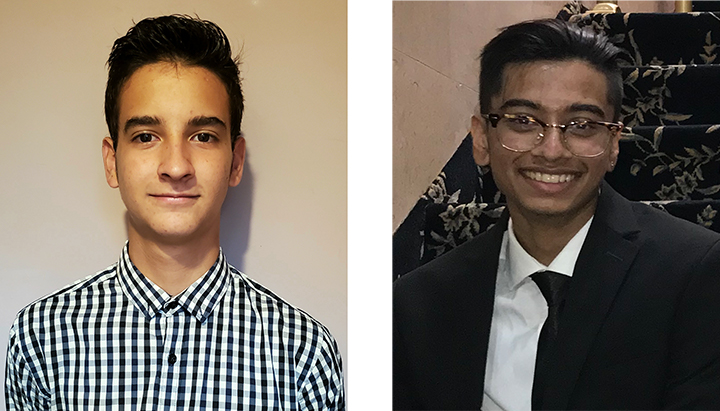
- Lab: Transformative Materials and Devices Laboratory
- Faculty: Professor Andre Taylor
- Mentor(s): Jason Lipton, Jason Alexander Rohr
Abstract: On October 2012, an article titled “Efficient Bulk Heterojunction Solar Cells using Tetrasubstituted Pyrene Derivatives as Donors” was published in the journal, Organic Electronics [Thomas, et al., 13 (10), 2201-2209, 2012]. The researchers behind the study claimed to have found an improved procedure for the fabrication of solution-processed bulk heterojunction solar cells, by using tetrasubstituted pyrene derivatives as electron donors and a solubilised version of the buckminsterfullerene, C60 as electron acceptor. They affirmed that when using this solar cell a Power Conversion Efficiency (PCE) of 3.63% could be achieved. While likely scientifically correct, the scientific community advocated for its retraction due to alarming concerns of plagiarism. The authors violated the professional ethical codes of the scientific community not only by making false claims of authorship of content already published in an article by the same journal [Dutta, et al., 13 (2), 273-282, 2012], but also by evading citing material taken from several different sources. In order to ensure that no papers are plagiarized, authors should be actively involved in the editing and reviewing of the articles, and Journals themselves should have stricter review and evaluation processes. By either executing the methods used in the original article or correctly replicating and citing the experiments previously performed, the authors could have reached the same results while still being able to follow the ethical principles laid out by the scientific community.
2019
Anthropology
Anya Shvarts, Hunter Milles
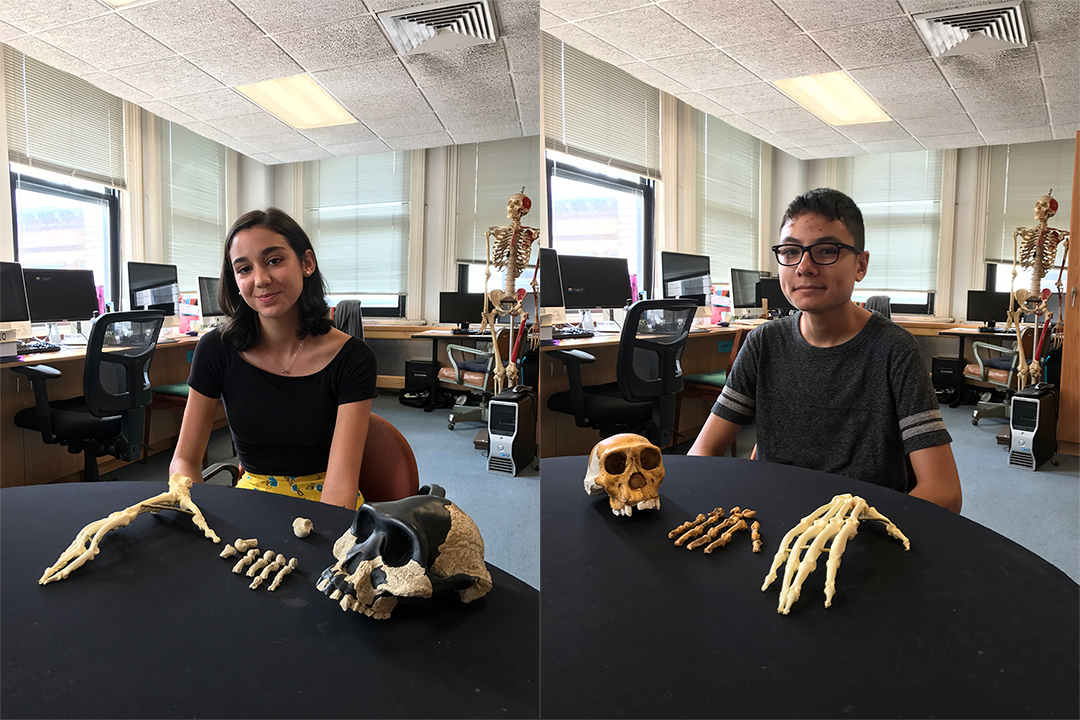
- Lab: Evolutionary Morphology Lab [Anthropology]
- Faculty: Scott Williams
- Mentor(s): Thomas Cody Prang
- Time: 11:20 - 11:40 am
Abstract: Reconstructing how human upright walking (bipedalism) evolved is a major focus of paleoanthropology. In quadrupedal primates, the upper and lower limbs share functional roles in forms of movement (locomotion) usually involving life in the trees (arboreality). The emergence of terrestrial bipedalism freed the human hand from its functional role in arboreal locomotor behavior and allowed for the evolution of increased manual dexterity and manipulative capabilities. The functional differentiation of hominin (humans and our fossil relatives) limbs is therefore closely connected to our unique form of bipedal locomotion. The morphology (shape) of hand and foot phalanges reflects locomotor diversity among primates, including bipedalism in hominins. Most studies of phalangeal morphology have focused on univariate metrics such as longitudinal curvature in either the hand or the foot. However, few studies have quantified phalangeal shape and covariation using more detailed quantitative methods. The purpose of this study is to test the hypothesis that modern humans have lower magnitudes of hand and foot phalangeal shape covariation compared to quadrupedal primates. We plan to quantify the multivariate shape of hand and foot phalanges in humans, fossil hominins, apes, and monkeys using a two-dimensional coordinate method. The covariance of hand and foot phalanges will be quantified using two-block partial-least squares (2B-PLS) and compared between locomotor groups (bipedal vs. quadrupedal). The evolutionary origins of the functional differentiation of limbs will be evaluated by quantifying phalangeal shape in the earliest fossil hominins such as Ardipithecus (4.4 million years old) and Australopithecus (3.2 million years old). Our results will have implications for understanding the timing and pattern of limb functional differentiation in the human lineage as well as the range of possible locomotor behaviors of the human-chimpanzee last common ancestor (LCA).
Gabrielle Piña, Yovanna Smith
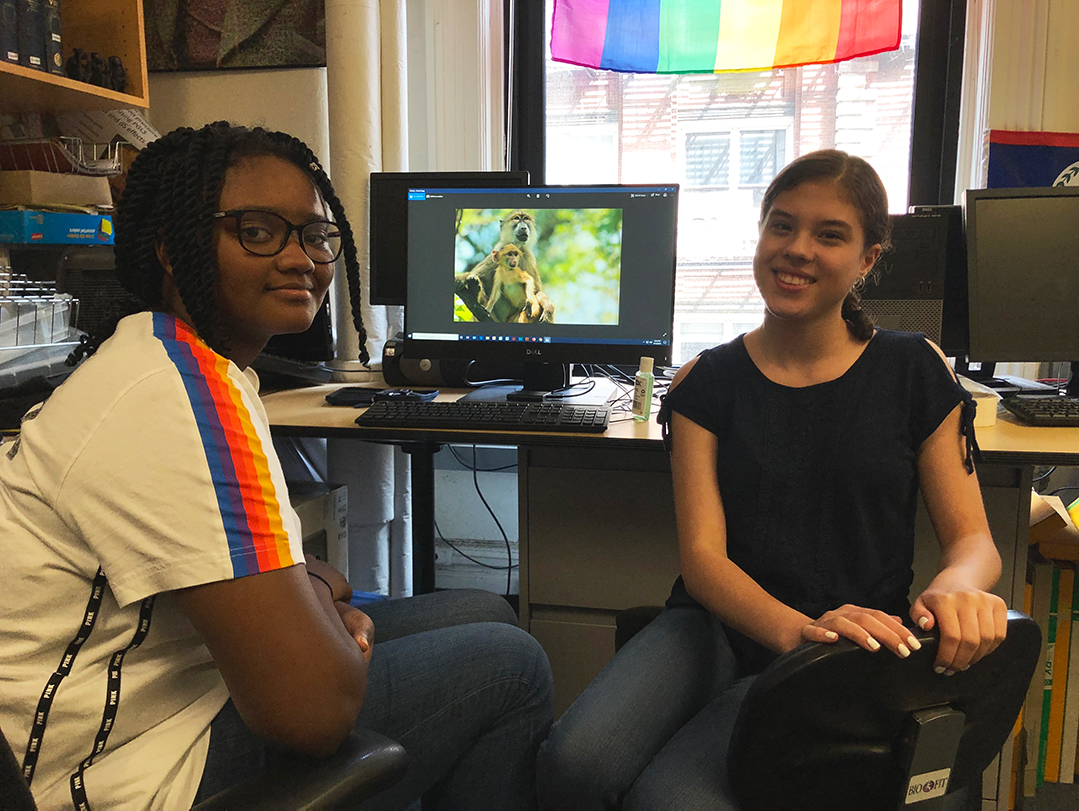
- Lab: Primate Hormones and Behavior [Anthropology]
- Faculty: James Higham
- Mentor(s): Megan Petersdorf, Clare Kimock
- Time: 10:20 - 10:40 am
Abstract: Baboons (genus Papio) include a variety of well-studied species, but less is known about the Kinda baboon (P. kindae). Baboon females exhibit a variety of sexual signals, which in most species accurately indicate fertility. Kinda baboon sexual signals, however, might not accurately indicate fertility because Kinda baboons display different reproductive patterns than other baboon species. We will investigate how accurately the female sexual signals of wild Kinda baboons represent fertility. We will analyze multimodal signals such as swelling sizes, copulation calls, and behaviors in relation to hormonally-determined fertile phases. Through studying these signals we hope to understand the Kinda baboon’s unique mating system and the differences between them and other baboon species.
Biology
Nusrat Aishi, Zahniya Thousand
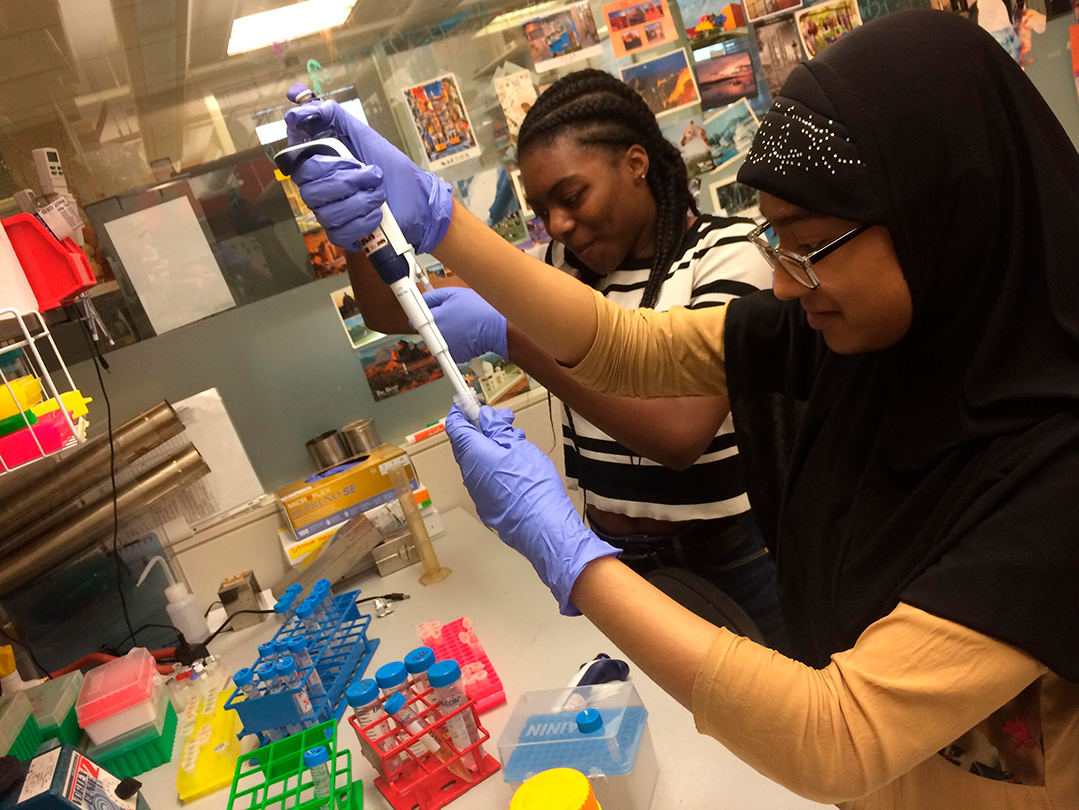
- Lab: Chromosome Inheritance Lab [Biology]
- Faculty: Andreas Hockwagen
- Mentor(s): Jonna Heldrich
- Time: 10:30 - 10:50 am
Abstract: Meiosis is a specialized type of cell division that is required for sexual reproduction and generates genetic diversity. During this process, the DNA undergoes programmed breakage and repair to exchange genetic information and ensure proper segregation of the DNA during cell division. Mistakes in this process can result in infertility or birth defects. Our research aims to better understand the break and repair of the DNA. We are using a mutagenesis screen to identify the genes that are involved and how they function. Our lab utilizes yeast because of its rapid growth and simple genome. Additionally, meiosis is conserved from yeast to humans so our research will improve understanding of how this complex process occurs in humans.
Roxanna Alvarado

- Lab: Molecular and Cellular Biology [Biology]
- Faculty: Fei Li
- Mentor: Hyoju Ban
- Time: 11:10 - 11:20 am
Abstract: In eukaryotic genomes, there are two different types of chromosomes. Chromosomes are DNA strands which are wrapped around histones. The two types of chromosomes in a eukaryotic genome are heterochromatins and euchromatin. Heterochromatins are densely packed making it less accessible for transcription whereas euchromatins are lightly packed and are often actively transcribed. Heterochromatins are located in the pericentromeric regions of the chromosome, which surrounds the centromere, a site where sister chromatids bind. A crucial function of heterochromatins is to prevent repetitive DNA sequences from causing genetic instability. The heterochromatin “silences” repetitive sequences preventing them from being expressed. Heterochromatins have a spreading property to neighboring genes. Consequently, this results in multiple neighboring genes being silenced. We plan to use yeast pombe for our experiment because pombe has well conserved and defined heterochromatins. In order to find a novel factor that spreads heterochromatins we will over express our candidate genes. We will observe the silencing of a neighboring gene to the pericentromere, adenine6 by growing the cell in media – adenine. With the research of our novel factor we can contribute to our understanding of the mechanism behind heterochromatin spreading, which is associated with pathological conditions such as cancer and aging.
Isabel Betances, Syed Tajrian
- Lab: Chromatin Genomics - Ercan Lab [Biology]
- Faculty: Sevinc Ercan
- Mentor(s): David Jimenez, Bhavana Ragipani
- Time: 11:50 - 12:10 pm
Abstract: Condensins are multisubunit protein complexes that are involved in the organization of chromosomes in all species. In humans, there are two types of condensins required for chromosome condensation during mitosis and meiosis. In C. elegans, there is an additional complex called the dosage compensation complex (DCC), a protein which is recruited to motifs on the two X-chromosomes of the hermaphrodite worm and downregulates the transcription of genes on each X-chromosome by half. In C. elegans we observed that when an X-chromosome is fused to an autosome, the worm seems to be phenotypically longer, however we do not know how the DCC contributes to the change in length. It is possible that the deleted ends of the chromosomes decreased the length of the worms, but it is also possible that the DCC represses the transcription of other genes that also decrease worm body length. We will use RNAi to target the DCC, and we will image four fusion strains to measure worm length. We hypothesize that spreading of the DCC is inhibiting the transcription of certain genes, causing the worms to be longer in length. This will help broaden our understanding of the mechanisms of DCC, chromatin condensation, and how they affect C. elegans and other species.
Tonia Curdas
- Lab: Developmental Genomics [Biology]
- Faculty: Christine Rushlow
- Mentor(s): Shawn Huang, Peter Whitney
- Time: 10:50 - 11:00 am
Abstract: Zelda is a key transcription factor that is known to activate hundreds of genes in the early embryo. The Zelda protein contains six zinc finger (ZNF) domains. ZNF 3-6 bind to CAGGTAG motifs, while ZNF2 binds a GGG motif. The CAGGTAG site has been well characterized in hundreds of target enhancers, however, little is known about the GGG site because GGGoccurs too frequently in the genome to pinpoint. Therefore, we will take a genetic approach and test whether the expression of Zelda targets is affected in embryos that contain Zelda proteins that contain mutations in ZNF2 but not ZNF3-6. We will use in situ hybridization to assay RNA expression of a handful of known Zelda target genes in ZNF2 mutants. Any changes in the expression pattern of a gene in these mutants will indicate that ZNF2 is required for normal expression.
Eva Das, Oliver Kleinmann
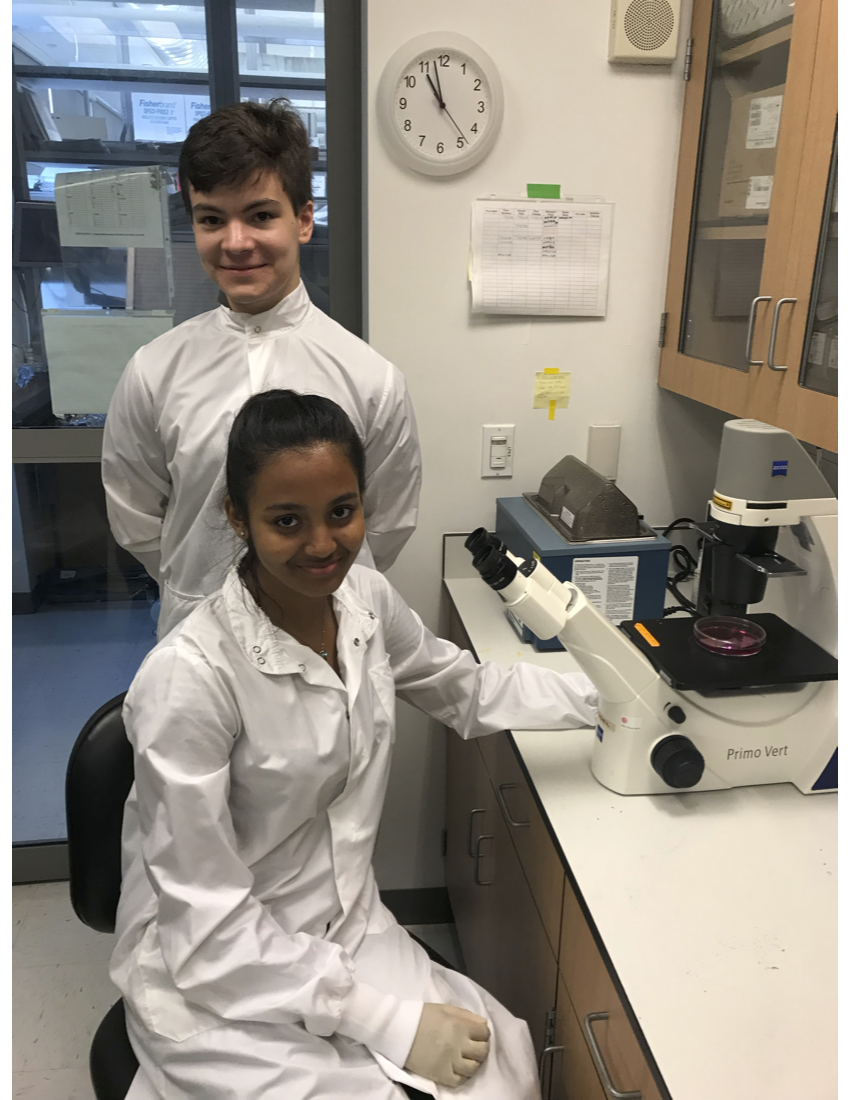
- Lab: System Proteomics [Biology]
- Faculty: Christine Vogel
- Mentor(s): Shuvadeep Maity, Justin Rendleman
- Time: 10:10 - 10:30 am
Abstract: The Endoplasmic reticulum (ER) is the primary site of protein production inside the cell. Proteins get folded inside the ER to become functional. Any conditions that affect protein folding can cause the accumulation of misfolded proteins inside ER and lead to ER stress. ER stress is the cause of several diseases like Parkinson's, Alzheimer's, diabetes, and cancer. Upon ER stress cells activate a response pathway called the Unfolded Protein Response (UPR) to take care of the misfolded proteins and maintain cellular health. If the UPR fails to remove all the misfolded proteins, it can cause cell death. A protein kinase, PERK is one of the key players for the activation of the UPR. Since previous research points to PERK being located within ER-mitochondrial associated membranes, we suspect PERK has an effect on mitochondrial structure and function during ER stress. In this project, utilizing an imaging and molecular biology approach, we will check the impact of ER stress over mitochondria in the presence and absence of PERK.
Samantha Lydon
- Lab: Molecular and Cellular Biology [Biology]
- Faculty: Fei Li
- Mentor: Qianhua Dong
- Time: 10:00 - 10:10 am
Abstract: The centromere is a condensed region of chromatin which binds to microtubules to facilitate chromosome segregation during cell division. Each chromosome only has one centromere. The formation of each centromere is based on the location of a specific histone H3 variant called the CENP-A protein, an epigenetic factor, as opposed to nucleotide sequence, which is a genetic factor. CENP-A binding is antagonized by another protein, known as Ccp1, in the single-cell eukaryotic organism S.pombe, in areas where chromatin is not intended to form the centromere. This prevents multiple centromeres from forming on one chromosome, which would interfere with chromosome segregation in the cell cycle. This, in turn, would result in daughter cells that are aneuploid, which is the hallmark of cancer. Ccp1 localizes to the centromeric region in a cell-cycle dependent manner. However, the manner by which Ccp1 localizes to the centromeric region is not clear. The goal of this project is to investigate which candidate proteins and defined region of the protein is required for Ccp1 to load to the centromere. CRISPR technology will be used to delete some codons from the candidate genes in vivo to see the effect of Ccp1 localization by GFP tagging. Mis-localization of CENP-A can cause severe defects, such as aneuploidy, cancer, or cell death. Understanding the mechanism of Ccp1 prevent excessive CENP-A from loading in centromeric region will likely open the door for the development of new strategies for cancer diagnosis and therapy.
Ciro Salcedo
- Lab: Developmental Genomics [Biology]
- Faculty: Christine Rushlow
- Mentor(s): Shawn Huang, Peter Whiteny
- Time: 11:30 - 11:40 am
Abstract: Transcription factors can activate target genes by binding to specific binding site in their regulatory elements. Zelda is a key transcription factor that is distributed uniformly throughout the embryo and binds to CAGGTAG motifs to activate downstream target genes. Zelda is referred to as the zygotic genome activator because it activates many of the genes transcribed in the early embryo. There are two types of Zelda target genes. Class I genes are transcribed uniformly throughout the embryo like Zelda. Class II genes are transcribed in specific spatial domains established by the patterning morphogens. In this study we will characterize a set of putative Class I genes. Previous work has established that they are highly down-regulated in the absence of Zelda, however, the timing of expression – when they are turned on and when they are turned off - has not yet been characterized. Using in situ hybridization techniques, we will analyze when and where they are expressed in early embryos. In addition, using genome-wide data of RNA Pol II binding and chromatin accessibility we will compare genomic features of Class I and II genes to better understand these different types of Zelda target genes, which will lead to a greater understanding of how Zelda, and other genome activators, function in early development.
Biomedical Engineering
Gideon Asumeng, Aliyan Malik
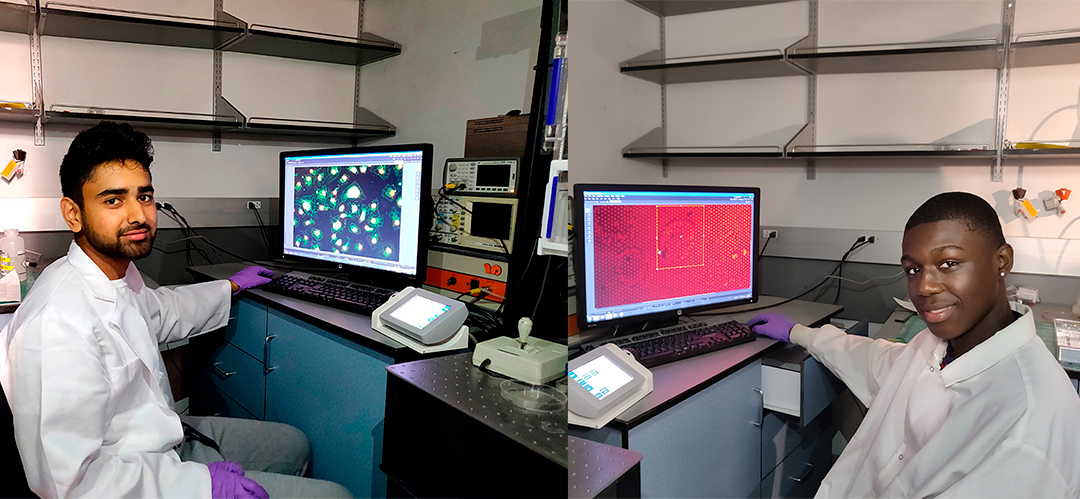
- Lab: Applied Micro-Bioengineering Lab [BioMedical Engineering]
- Faculty: Weiqiang Chen
- Mentor(s): Apratim Bajpai
- Time: 11:10 - 11:30 am
Abstract: Macrophages, B- Cells, and T-Cells form the backbone of the human bodies immune system, performing a myriad of functions including phagocytosis, wound healing, antigen presentation and cytokine production. The plasticity of immune cells plays an important role in their ability to perform their intended and often unintended functions, and physical forces are an important regulatory mechanism in altering the behavior of immune cells. Here, we use polydimethylsiloxane (PDMS) based micropillar devices called Micropost Array Detectors (mPADs), and Traction Force Microscopy (TFM) to study the physical regulation of immune cells and their responses. We regulate the immune cells using drugs and physical cues i.e, ultrasound tweezers, and measure the forces that they exert using mPADs and TFM, to determine the mechanisms involved in mechanosensing and the role that physical forces may play in immune cell functions. This research will shed light on the mechanotransduction of immune cells and may help in understanding the progression and treatment of diseases such as atherosclerosis, leukemia, and many more.
Chemical and Biomolecular Engineering
Zainab Adula, Zachary Dulemba
- Lab: Nanostructured Hybrid Materials [Chemical and Biomolecular Engineering]
- Faculty: Ayaskanta Sahu
- Mentor(s): Haripriya Kannan, Michael Scimeca, Steve Farrell, Ingrid Paredes
- Time: 11:40 - 12:00 pm
Abstract: Sustainable energy is one of the most pressing issues that society faces today. With traditional materials reaching their performance limits, the development of new materials will lead us to meet the global demand for energy in a clean and sustainable fashion. Hybrid materials are an emerging class of compounds that combine inorganic and organic components to produce materials with performance greater than the sum of their parts. Our lab seeks to gain fundamental understanding of the electronic and thermal properties of these hybrid systems. We will do this via the synthesis and characterization of hybrid materials, looking at the effect of composition, size, and shape on thermal and electronic properties. Once reliable methodologies for synthesis have been developed, we will implement our materials into devices including light emitting diodes, solar cells, and thermoelectric coolers.
Naima Akter, Nusrat Islam
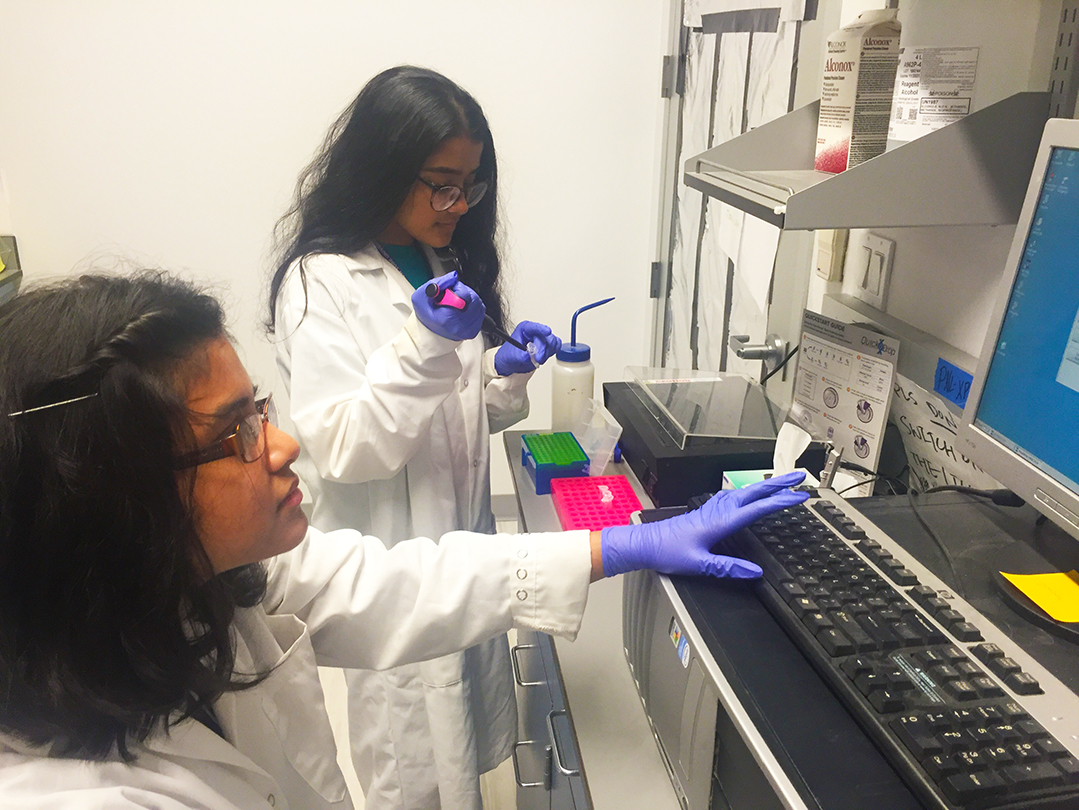
- Lab: Biomolecular Engineering Lab [Chemical and Biomolecular Engineering]
- Faculty: Jin Ryoun Kim
- Mentor(s): Edward Chau
- Time: 10:00 - 10:20am
Abstract: Amyloidogenic diseases are characterized by the abnormal aggregation and mis-folding of proteins. α-Synuclein, a presynaptic neuronal protein, has genetic and neuropathological links to one of the most common age-related neurodegenerative diseases, Parkinson’s disease (PD). α-Synuclein follows an aggregation pathway that forms toxic oligomer and fibrillar structures, affecting an important section of the brain, the substantia nigra, and causing patients to experience memory loss and/or the loss of motor functions. We investigated natural chemical compounds that may be an effective solution to PD, by disrupting the abnormal aggregation pathway of this amyloidogenic protein. Results from this study could contribute to uncovering the process behind amyloid protein aggregation, leading to potential therapeutic treatments and diagnostic tools for such neurodegenerative diseases.
Mahmoud Elghayesh, Kazi Islam

- Lab: Hartman Lab [Chemical and Biomolecular Engineering]
- Faculty: Ryan Hartman
- Mentor: Filip Popovic
- Time: 10:40 - 11:00 am
Abstract: Microfluidics has matured as a field over the course of the last three decades. It is now finding widespread application in disparate fields (such as microbiology, flow chemistry etc.). However, a certain level of expertise is required for the proper use of microfluidic devices. Improper use leads to critical experimental errors which arise from the possible incorrect assumption of flow regime. These errors can unknowingly propagate and lead research to arrive to false conclusions illegitimating their experiment. Microfluidic devices tend to make use of certain topological arrangements of microfluidic channels. These channels are used for the transport of material. The efficacy, efficiency, pressure drop, and homogeneity of constituent concentration of this transport depends on fluid flow characteristics, such as flow rate and flow regime, as well geometric factors of the channel: tortuosity, characteristic length(s) and others. Studies on different flow reactors to uncover conditions where the assumption of plug flow becomes invalid were conducted. This should provide a foundation where the results can be utilized to drive industry, medicine, and other fields where microfluidic flow technology is being rapidly adopted.
Christian Hernandez, Myrna Khalil
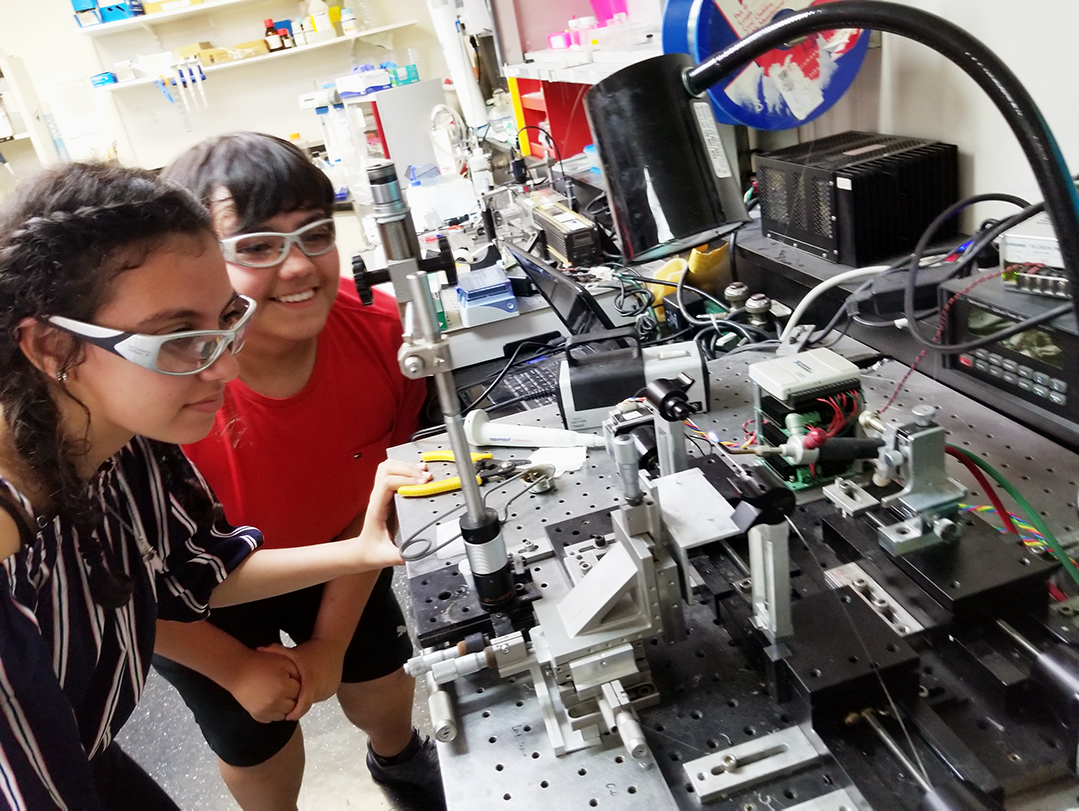
- Lab: Bio-Interfacial Engineering and Diagnostic Group [Chemical and Biomolecular Engineering]
- Faculty: Rastislav Levicky
- Mentor(s): Vladislav Frenkel
- Time: 11:50 - 12:10 pm
Abstract: Biosensors are devices that are most commonly used for the detection of chemical or biological substances with high specificity. Biosensors have profound use in a large variety of fields and applications ranging from food safety and quality control all the way to the testing glucose levels in the blood of diabetics. We are aiming to improve the machinery used to fabricate whispering gallery mode (WGM) biosensors. These biosensors consist of a tapered glass fiber which couples light into a glass microsphere in which the light resonates. These biosensors are very sensitive, detecting molecules as small as single virus particles without the use of any labeling, and have a large variety of applications. Multiplexing these sensors would allow each sensor to detect multiple different molecules. One possible way to multiplex WGM biosensors would be by functionalizing with a light sensitive chemical group which could be selectively altered with light to create distinctive sensing regions. A lot of light needs to couple from the tapered fiber into the sphere in order to break the bonds in the chemical group. Currently the tapered fibers are made by pulling the glass fiber over an open flame. Current tapered fibers are slightly misaligned from the equator of the microspheres resulting in some loss. Improving the design of the fiber pulling mechanism would improve the alignment of the tapered fiber which will increase the amount of light able to enter the sphere and will result in future experiments becoming more reliable. Through the use of 3D printing it will be possible to quickly create and iterate on an improved design.
Julian E. Morales, Sandhya Sethuraman
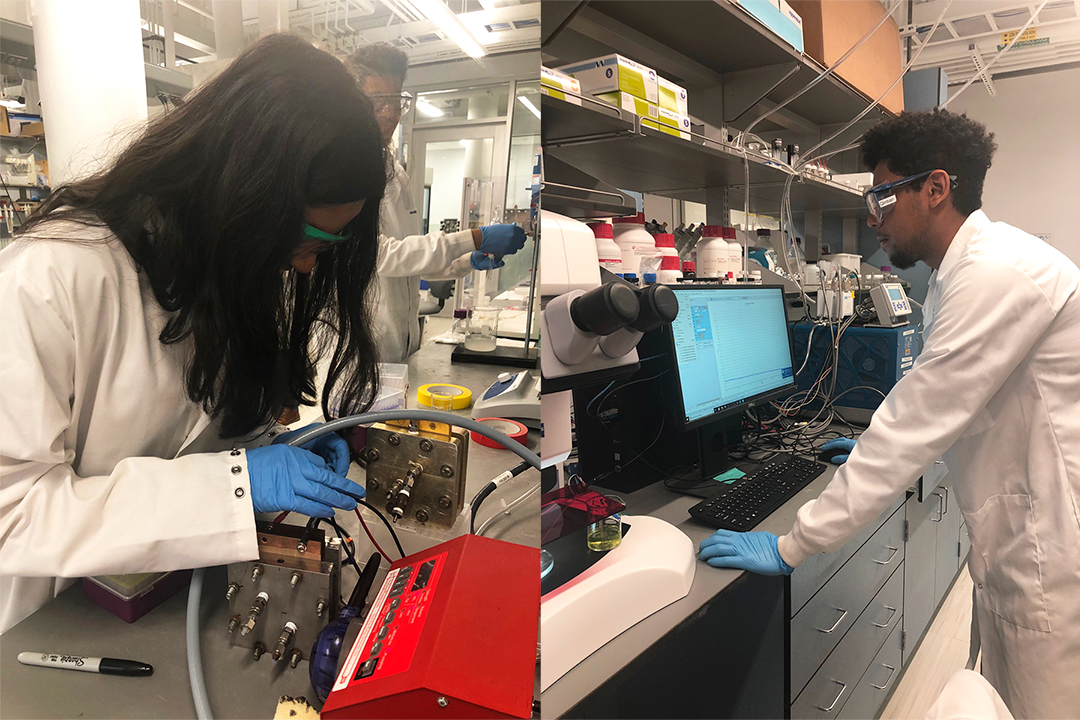
- Lab: Multifunctional Material Systems Laboratory [Chemical and Biomolecular Engineering]
- Faculty: Miguel Modestino
- Mentor(s): Daniela E. Blanco
- Time: 10:30 - 10:50 am
Abstract: Solar textiles is a project focused on improving the efficiency and sustainability of Nylon 6,6, and this study targets the first chemical step to make Nylon. On this step, adiponitrile (ADN) is made electrochemically from a molecule called acrylonitrile (AN) in a redox reaction. The electrolyte used in the process consists of TAA salts for improved selectivity, phosphate salts for charge transport, and EDTA as a chelating agent. Prior research (using sodium phosphate) measured the effect of the TAA ion size and concentration, AN concentration, pH, and temperature on electrochemical conversion. This study focuses on the phosphate salts, investigating the effect of the cation size (sodium, potassium, cesium, and rubidium), current density and concentration on the interface interactions and subsequently the efficiency of the pathway to electrochemical conversion. Results from the study could translate into improvements for the process of Nylon manufacturing.
Shanya Sam
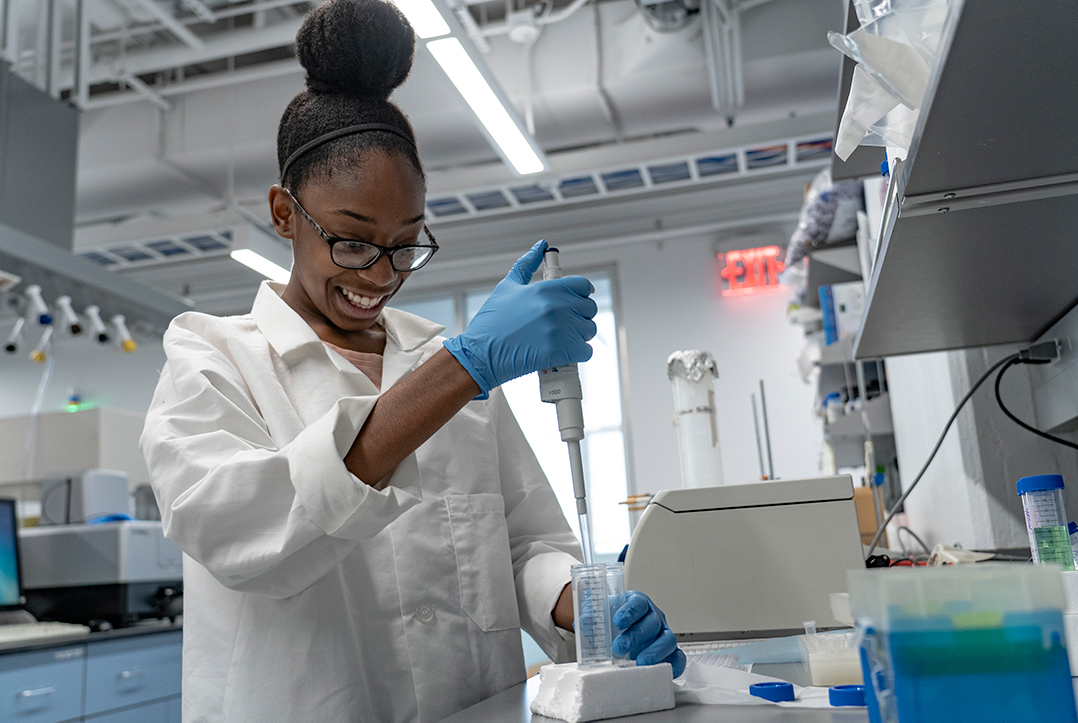
- Lab: Protein Engineering & Molecular Design Lab [Chemical and Biomolecular Engineering]
- Faculty: Jin Montclare
- Mentor(s): Aparajita Bhattacharya
- Time: 12:00-12:10 pm
Abstract: Theranostic agents are being developed for their ability to diagnose disease and improve therapeutic delivery. Traditional drug delivery has been inefficient due to factors such as drug insolubility, tissue indiscriminate cytotoxicity, their inability to stimulate release and their lack of direct monitoring. Recently, we have engineered a protein-based theranostic agent, fluorinated thermo-responsive assembled protein (F-TRAP) bearing fluorinated amino acids. F-TRAP self-assembles into micellar structures and consists of hydrophobic pores capable of encapsulating the chemotherapeutic drug molecule, doxorubicin. Moreover, F-TRAP is traceable via 19F magnetic resonance imaging (MRI). To increase the sensitivity for imaging, we are developing a positron emission tomography (PET) visible agent, 18F-TRAP. In this project, we will employ residue-specific incorporation of an azide-bearing methionine analog, azidohomoalanine to give rise to clickable azide-functionalized TRAP that can be subsequently conjugated to 18F-BODIPY alkyne (boron-dipyrromethene alkyne), imparting it an ability to be used as a dual modality PET probe.
Civil and Urban Engineering
Zoë Cappella Cooper, Modupe Oridota
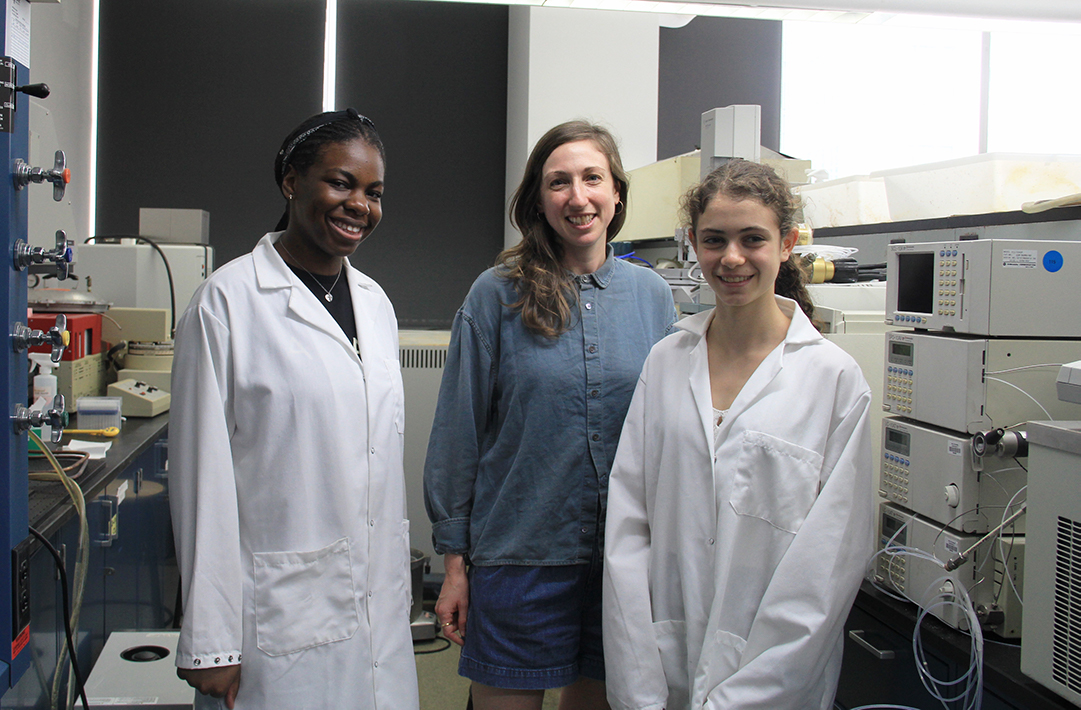
- Lab: Environmental Engineering and Water Treatment Laboratory [Civil Engineering]
- Faculty: Andrea Silverman
- Mentor(s): Mwale Chiyenge
- Time: 10:40 - 11:00 am
Abstract: Flooding in urban centers may change the microbial composition of the flooded surfaces. There is a need to understand this change, particularly in cities like New York City that have combined sewage systems. These systems channel a mixture of sewage and storm water overflow to outfalls located along the coastline during rainfall events. Some of this combined sewage floods streets due to backlog in the system. It is critical to identify if and how these flood waters come in contact with NYC residents. This is especially important as flood events grow more frequent due to higher intensity rainfall as a result of climate change. The ultimate goal of the research is to study the impact of flooding on the microbiome of urban surfaces in NYC by collecting and sequencing DNA from these surfaces before and after flooding. To do this, a baseline measure of the microbial composition of these surfaces is necessary. This particular research is a preliminary stage which aims to establish the baseline by optimizing the DNA collection and extraction procedures. The procedures determined to produce the highest DNA yield will be used to measure and characterize the baseline microbiome of NYC urban surfaces. This baseline will then be used in the next phase of the project by comparing it with the microbiome of recently flooded surfaces. Overall, this research will raise awareness of the possible effects of flooding on the city’s microbiome, which can help motivate interventions to protect the health of NYC residents.
Ines Villegas Costa, Lauren Pehlivanian
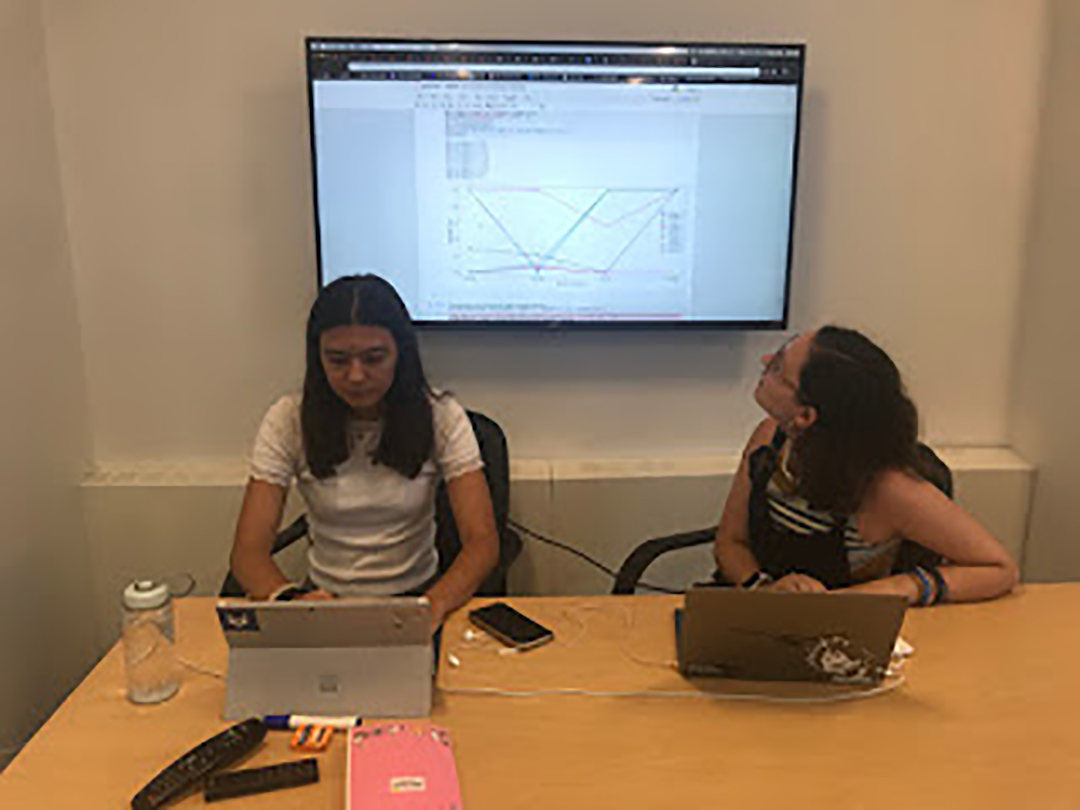
- Lab: BiLab [Civil Engineering]
- Faculty: Semiha Ergan
- Mentor(s):Zhengbo Zou, Xinran Yu
- Time: 10:40 - 11:00 am
Abstract: Buildings account for more than 70% of the energy consumed in the United States. With the increasing demand for energy, it becomes crucial that we develop ways for energy conservation. Therefore, generating a model to accurately predict energy consumption in buildings is necessary for buildings to reduce their energy consumption. The current models used to predict energy consumption of buildings, however, are not accurate, due to the lack of data of building characteristics. This project aims to solve this problem by extracting more data on building characteristics from pictures through computer vision and deep neural networks. We will then use machine learning to make a model to predict the energy consumption of buildings based on their characteristics.
Abhinav Garg
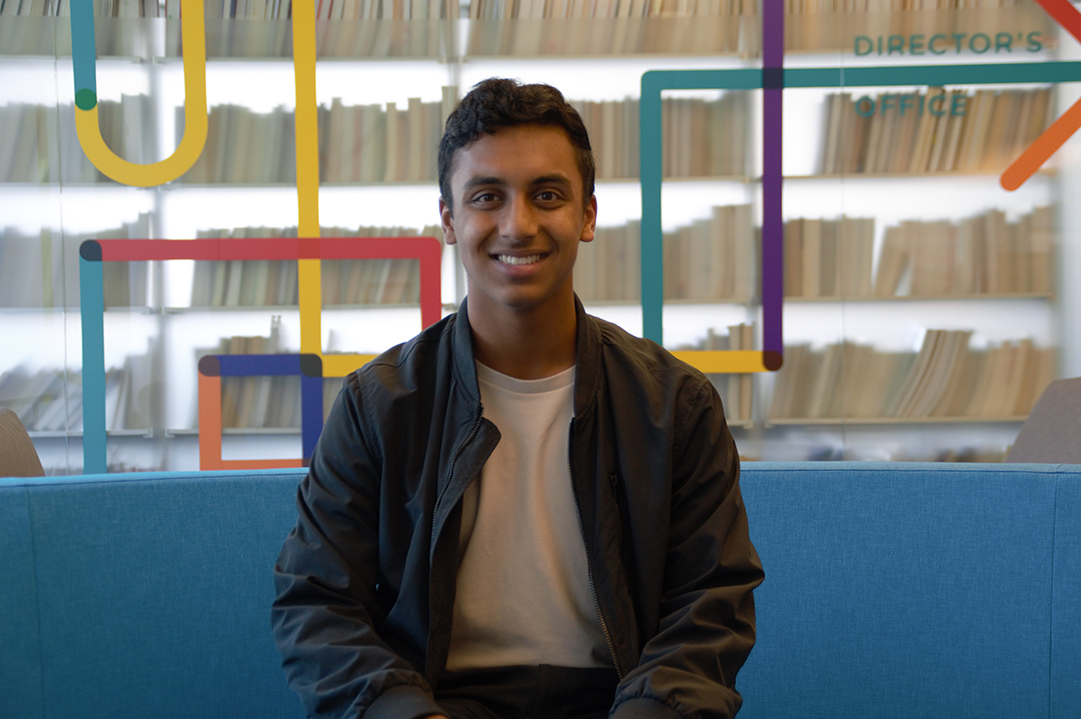
- Lab: CUITS: Behavioral Urban Informatics, Logistics, and Transport (BUILT) [Civil Engineering]
- Faculty: Joseph Chow
- Mentor(s): Reuben Juster
- Time: 11:10 - 11:20 am
Abstract: Safety concerns that arise from congestion-related incidents are a prevalent issue, especially in an urban environment. New York City has witnessed a 30% increase in traffic fatalities in 2019 as compared to 2018 with a multitude of possible factors attributed to the surge. This study focuses on the change in speed prompted by the addition of speed humps and its effect on traffic. Vision Zero geospatial data is utilized in relation to areas of vehicle congestion and collision rates using PostgreSQL in order to analyze possible correlation. Visualization tools including Tableau and geographic information system (GIS) will be fundamental in the understanding of traffic patterns and long-term reduction in casualties.
Isabelle Greene
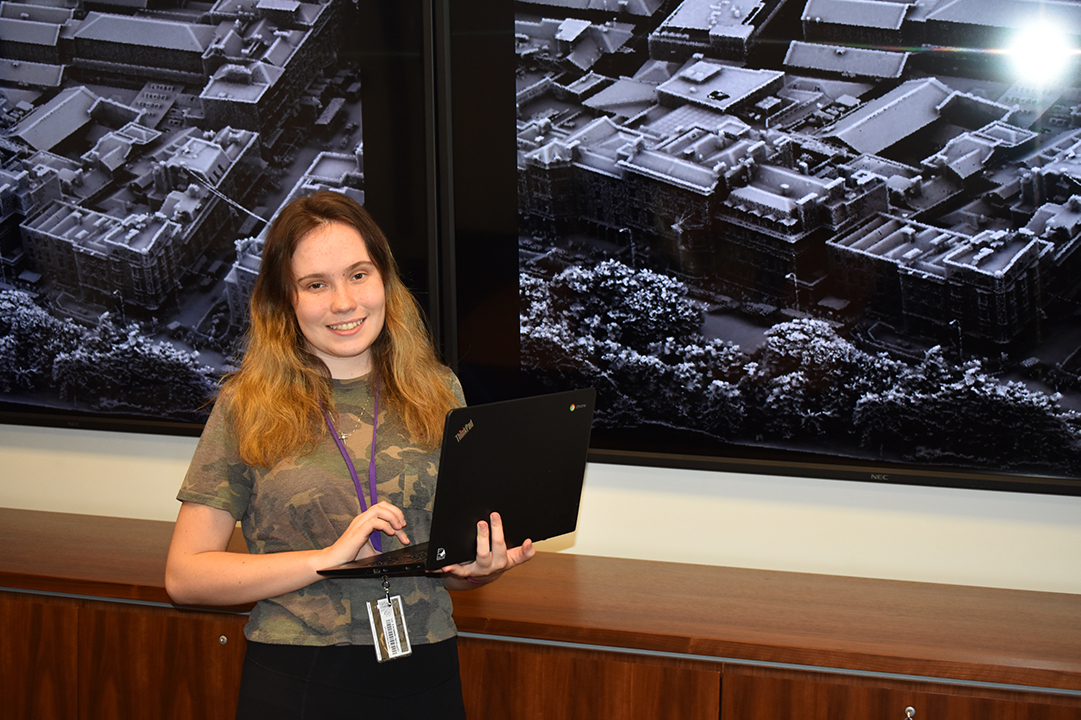
- Lab: Urban Modeling Group [Civil Engineering]
- Faculty: Debra Laefer
- Mentor(s): Anh Vu Vo, Debra Laefer
- Time: 10:20 - 10:30 am
Abstract: Overhead utility lines provide the electricity needed to supply homes and businesses across the country. However, these lines often come into conflict with trees, which can lead to power supply interruptions for customers, reduced lifespans for the trees, and hazardous conditions for residents and utility workers when lines are damaged or broken. This project aims to develop a software application for automatic detection of trees and above ground utility lines from high-resolution, three-dimensional airborne laser scanning datasets collected in Sunset Park in NYC. This will be a step towards a fully automatic software system for predicting when a tree is likely to come in contact with a line, thereby minimizing manual inspection and enabling a more systematic approach to intervention against vegetation incursion.
Megan Gupta-She

- Lab: CUITS: Behavioral Urban Informatics, Logistics, and Transport (BUILT) [Civil Engineering]
- Faculty: Joseph Chow
- Mentor: Reuben Juster
- Time: 10:30 - 10:40 am
Abstract: With the rise of big data and data science, many different processes in transportation can be studied in-depth and be made more efficient. In urban areas, a substantial part of transportation is provided by the For-Hire Vehicle (FHV) industry, especially government licensed for-hire vehicles. This study aims to determine the effects of different atmospheric conditions on the concentration and distribution of both yellow and green taxi trips in New York City using Taxi Limousine Commision (TLC) public data, historical meteorological data, geospatial data, and open-source PostgreSQL database. Results will be displayed visually using Tableau and Geographic Information System (GIS) software.
Jessica Katzman, Awestaa Zia
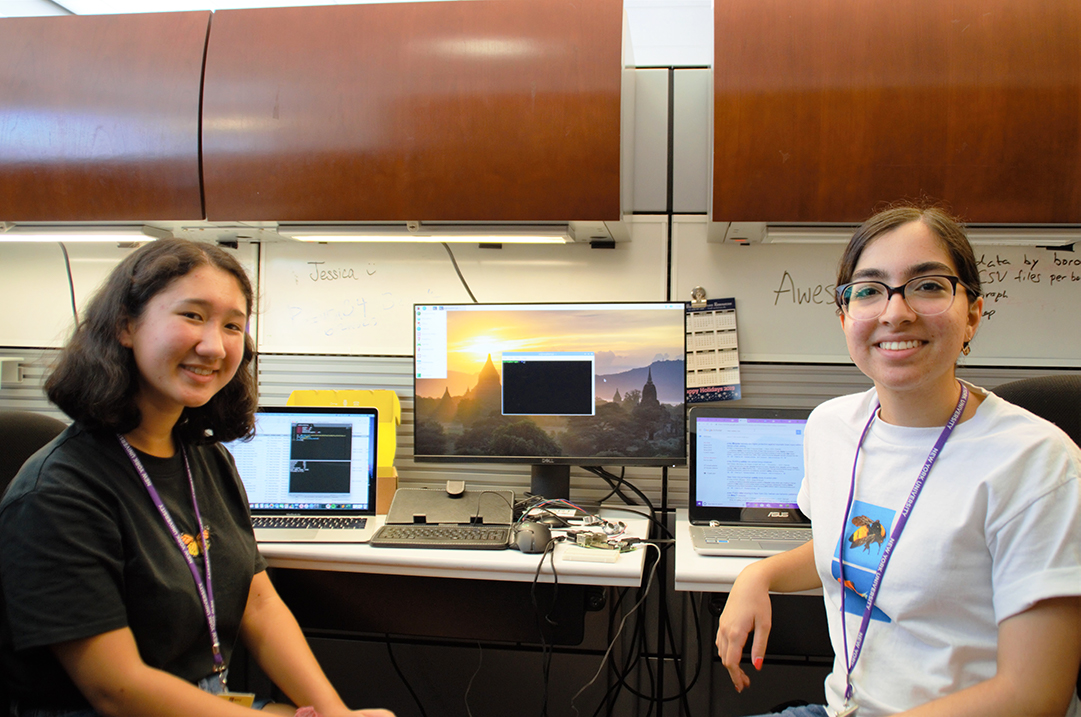
- Lab: UrbanMITS [Civil Engineering]
- Faculty: Kaan Ozbay
- Mentor: Suzana Duran Bernardes
- Time: 11:20 - 11:40 am
Abstract: In New York City, cyclist fatalities are becoming an increasing concern. According to reports released by the Department of Transportation, fifteen fatalities have already been reported this year, surpassing the total number of deaths reported in the previous year. The growing concern for bike safety has discouraged many New Yorkers from utilizing bicycle lanes throughout the city. This study hopes to understand the effect of car proximity on the stress levels of cyclists. We believe that increased car proximity will contribute to high levels of stress in cyclists. We will measure changes in distance between cars and bicycles using ultrasonic sensors, a Global Positioning System (GPS) receiver, and a real-time clock (RTC) connected to a Raspberry Pi mounted on a bicycle. Additionally, we will monitor cyclists’ level of stress throughout their ride. We will implement Python algorithms to analyze data collected by the sensors. We hope our findings contribute to the ongoing research to improve cyclist experiences by eventually mapping high-risk bike routes and developing an app to provide cyclists with relevant information for them to make safer decisions when cycling.
Emely Lopez
- Lab: Urban Modeling Group [Civil Engineering]
- Faculty: Debra Laefer
- Mentor(s): Anh Vu Vo, Debra Laefer
- Time: 11:30 - 11:40 am
Abstract: The federal government mandates that utility companies maintain their above ground lines free of interference from local vegetation. This mostly consists of trimming trees to prevent them from coming into contact with above ground electrical wires. Current practice involves manual inspection, which is time consuming, expensive, and subjective. This project seeks to streamline the maintenance process by gathering data of trees and utility lines from public databases and identifying appropriate tree growth models for a site-specific locale in order to predict localized incursion. The project will be a step towards an automatic and efficient system for predicting tree and utility line interference.
Eleni Retzepis, Yaseen Saleh
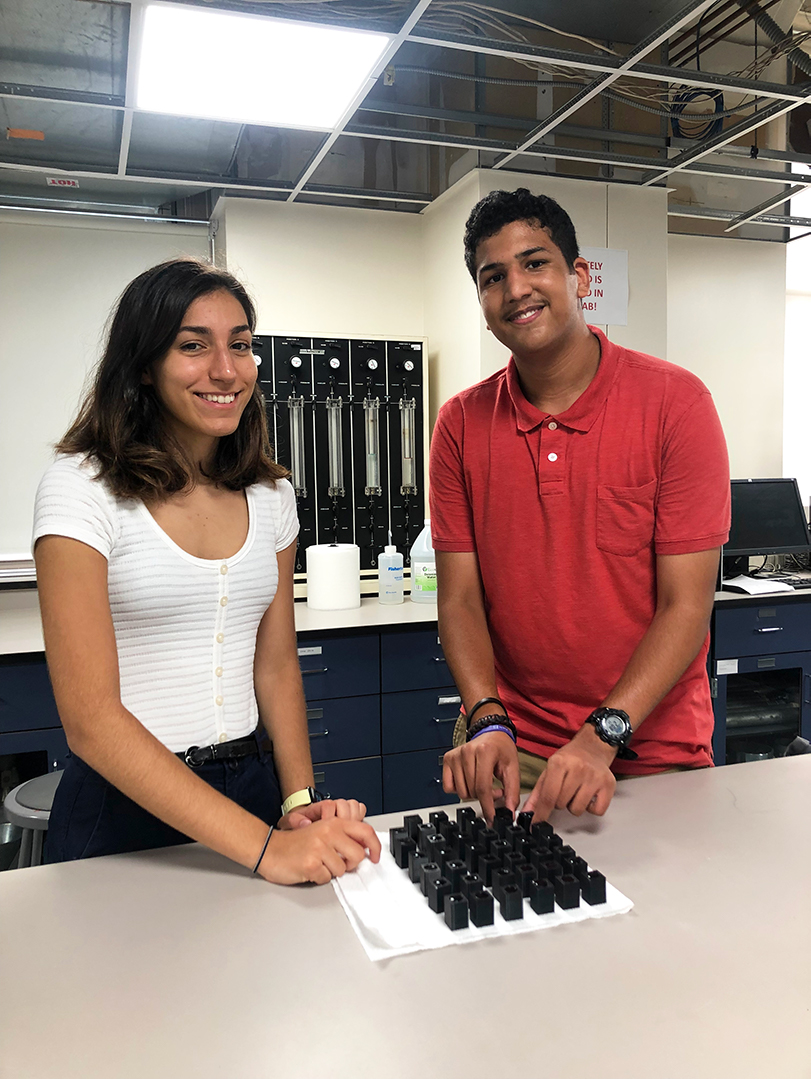
- Lab: Soil Mechanics [Civil Engineering]
- Faculty: Magued Iskander
- Mentor(s): Linzhu Li, Abdelaziz Ads, Antonio Kodsy
- Time: 10:00-10:20 am
Abstract: The advanced analysis of flow through porous media is of interest to many geotechnical engineers because it works as an essential ingredient for filter and drain design, internal erosion and piping, among others. In this study, an innovative method is introduced to examine the components of fluid flow through the pores of a saturated synthetic transparent granular media. Materials and methods such as a dynamic image analyzer and 3D printing allowed for manufacturing 2D hydrogel modelled Ottawa sand. Three representative Ottawa sand images were selected and magnified to ensure the particles have the same area. Forty hydrogel modelled Ottawa sand were made with three different particle shapes and the number of particles were 13, 13 and 14 for each particle shape. The pore fluid was imbedded with silver-coated hollow microspheres that allowed for illumination within the model when shone on by a laser light source. High-resolution images were captured from the model. This, along with particle image velocimetry (PIV) provided for the effective capture of fluid flow movements. This procedure made possible the analysis of soil-fluid contact when flowing through homogeneous porosity controlled Ottawa sand with three particle shapes. The results can be compared for analyzing the effect of particle shape on fluid flow and used in development of numerical models of coupled flow for future research.
Computer Science and Engineering
Jonathan Chen
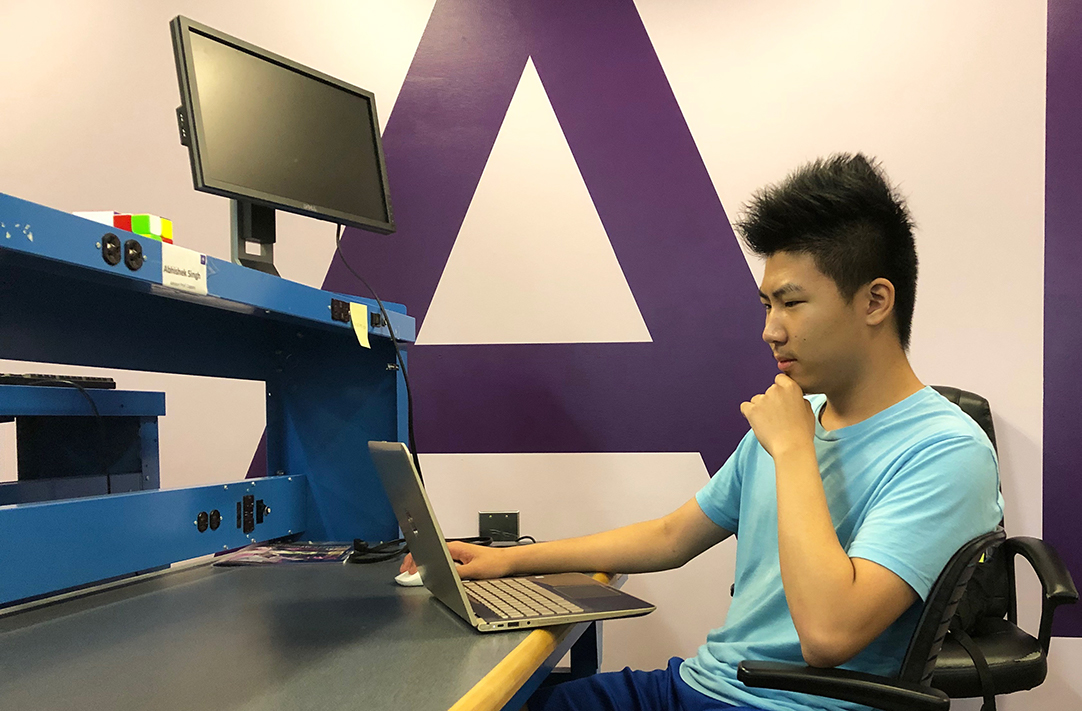
- Lab: Privacy and Security Automation Lab (PSAL) [Computer Science]
- Faculty: Rachel Greenstadt
- Mentor(s): Kejsi Take, Brian Timmerman
- Time: 11:40 - 11:50 am
Abstract: In this day and age, a sizeable portion of all of the world’s code is written and contributed in an anonymous fashion. Privacy and Security Automation Lab(PSAL) is studying the ways in which automated programs can decipher the identity of a programmer by detecting his or her unique coding style within the code that they wrote. This research stress the threat that machine learning poses to the privacy and anonymity of programmers. In their previous work, PSAL proved that machine learning algorithms were able to effectively determine the author(s) of anonymous code, and that these machines will become increasingly accurate as technology advances.
Kennan Grumbs, Heeyun Kim
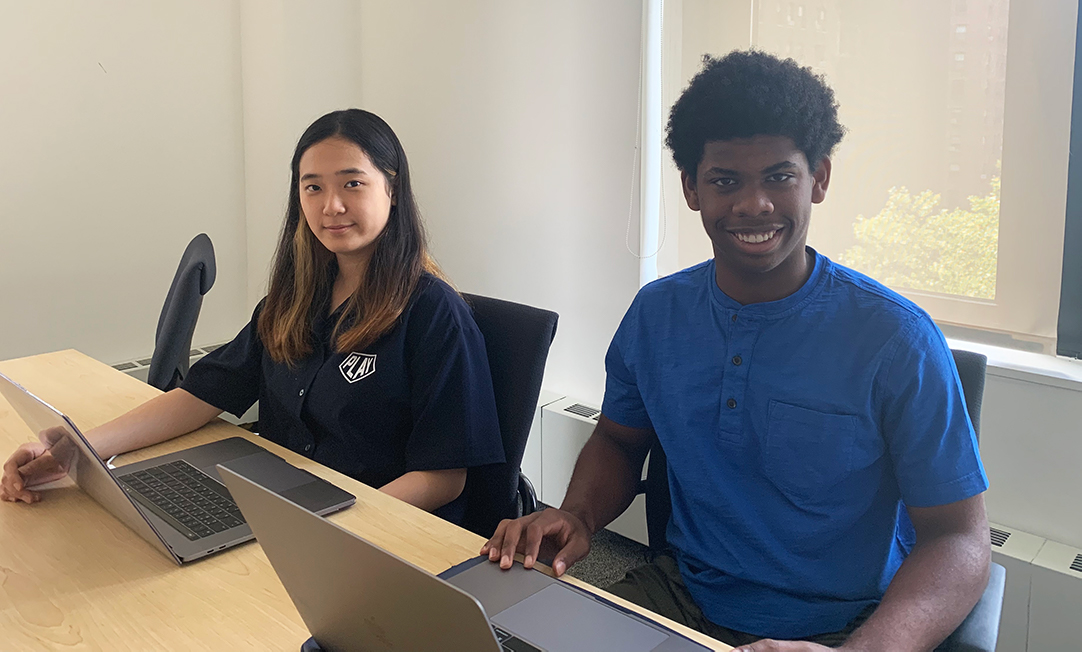
- Lab: Responsible data Science Lab [Computer Science]
- Faculty: Julia Stoyanovich
- Mentor(s): Kunal Relia, Théo Delemazure
- Time: 11:40 - 12:00 pm
Abstract: Computational social choice is an interdisciplinary area of research and practice that combines insights from mathematics, logic, economics and computer science to aggregate preferences of individuals to arrive at a society-wide consensus. In a standard election, selecting a winner is trivial: simply pick the candidate with the majority of votes. However, as the number of candidates increases and different voting rules are used, it becomes increasingly difficult to determine the outcome. More specifically, dealing with incompleteness and uncertainty, an inherent characteristic of polling is a serious challenge confronted in this field of research. While initial computational social choice researchers focused on formulating algorithms to determine winners given partial preferences, currently work is being done to carry this forward to implement and optimize such algorithms. Despite the importance of the problem, there is no comprehensive, public dataset of partial preferences of real-world elections. To address this, we mine datasets of recommender systems and rating websites to develop a comprehensive dataset of partial preferences, where each voter (e.g., viewers on Netflix) gives their preferences over a subset of candidates (e.g., movies on Netflix). We plan to use this dataset to validate our optimizations of the algorithms we are developing, and to eventually make this dataset public.
Rohan Saha, Lara Thain

- Lab: Chunara Lab [Computer Science]
- Faculty: Rumi Chunara
- Mentor: Vishwali Mhasawade, Harvineet Singh, Rumi Chunara
- Time: 10:10 - 10:30 am
Abstract: Online sources, such as social media activity, provide us with a way to monitor and analyze individuals’ health behavior in unprecedented detail. Combining rich behavioral data from online sources with more traditional sources such as community-level surveys provides a way to understand the factors affecting health disparities in communities. Our research will center on the food consumption behavior, as shared on social media platforms, and its relationship with the built environment of individuals. The built environment is taken to be the individuals’ physical neighborhoods as well as their online network. The aim is to determine whether this expanded notion of built environment explains the variation in the individuals’ food consumption patterns and to understand the associated mechanisms. We will gather and annotate data from the social media platform Instagram. Different measures of food consumption patterns such as frequency and timing of eating-out will be analyzed. Statistical analyses will be conducted to infer the relationship among individual’s built environment, social network and consumption patterns. The findings from the analyses will be visualized and summarized in a report.
Electrical Engineering
Farrukh Abdinov
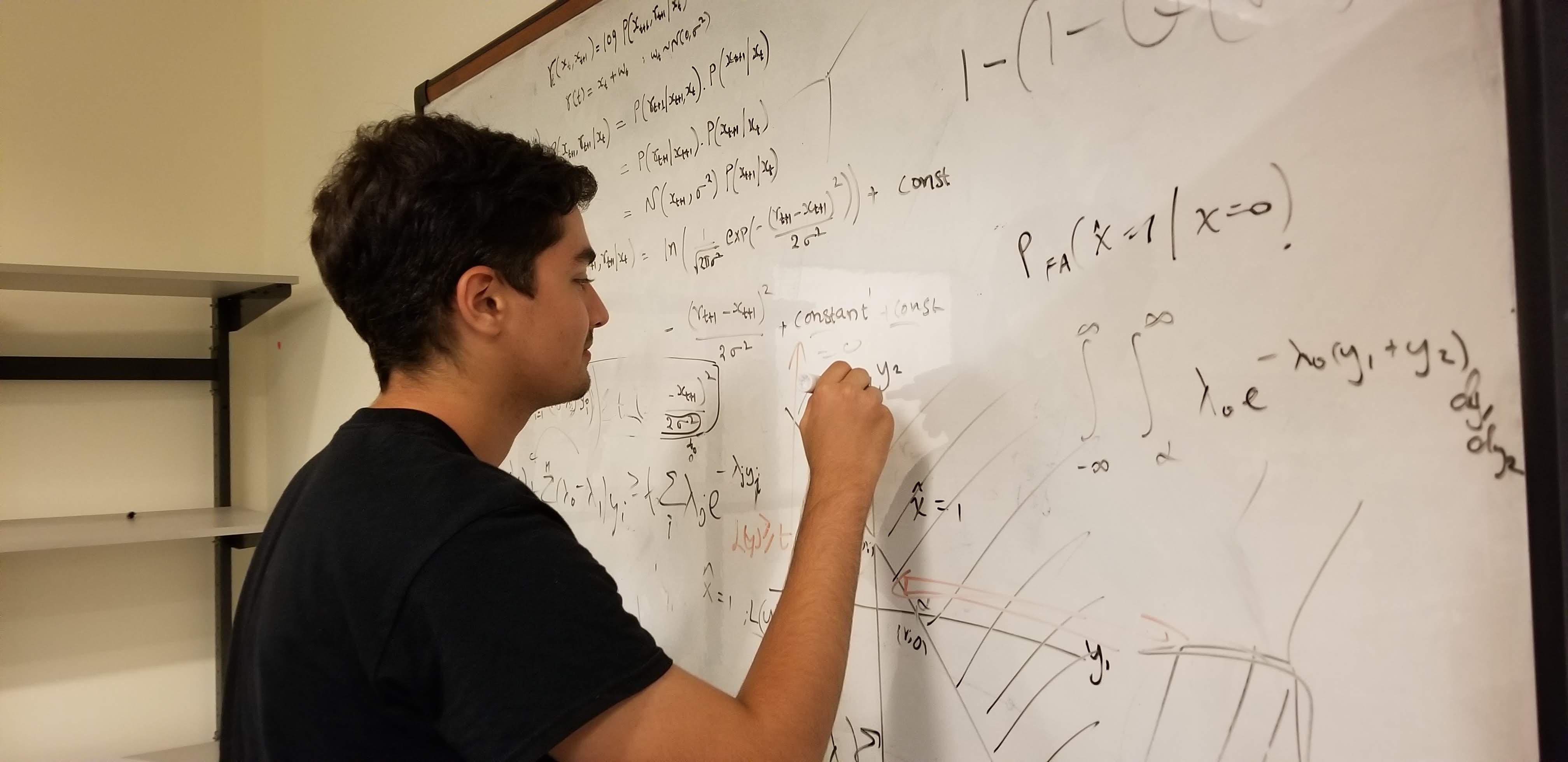
- Lab: CATT (Center for Advanced Technology in Telecommunications) [Electrical Engineering]
- Faculty: Shivendra Panwar
- Mentor(s): Fraida Fund, Mustafa Ozkoc
- Time: 10:20- 10:30am
Abstract: Cellular service providers hope that by deploying 5G, they will be able to offer new profitable services, such as support for connected vehicles. Users are interested in connected vehicle technology, which can improve accident avoidance and traffic efficiency. But, to invest in 5G networks at a level that will support this use case, the benefit of deployment due to revenue from the new services must outweigh the cost of deployment. It is not clear, however, what density of 5G base stations will be required to satisfy the capacity, delay, and reliability requirements of this technology. To address this issue, we will conduct simulations and experiments to determine the level of deployment necessary to support specific connected vehicles applications. This research can help us identify remaining barriers to the widespread deployment of connected vehicles so that we can begin to tackle these barriers.
Alex Holland
- Lab: Smart Energy Research (SEARCH) Group [Electrical Engineering]
- Faculty: Yury Dvorkin
- Mentor(s): Samrat Acharya, Matt Roveto, and Yury Dvorkin
- Time: 10:00 - 10:10 am
Abstract: Cybersecurity is an emerging field addressing the increasing emergence of cyberattacks. Many industries currently in their infancy are even more vulnerable to hacks due to lack of consensus regarding regulations. An arising field with these susceptibilities is power grids with renewable energy resources, possessing a multitude of viable vectors that can facilitate cyberattacks. Some of these vectors include electric vehicles and their corresponding charging stations, as well as smart home appliances such as WiFi enabled air conditioning systems. To research and observe this issue, I will model data-driven cyberattacks with altered model parameters and analyze these attacks and their effects on the powergrid, as well as the circumstances through which they are able to occur. Using such observations, I will work to conclude the extent to which cyberattackers are enabled or stunted by the various model parameters, while also accounting for inaccuracies in data and the cyberattack model. The research can be further extended to design security measures based on the assessed vulnerabilities.
Marin Hyatt
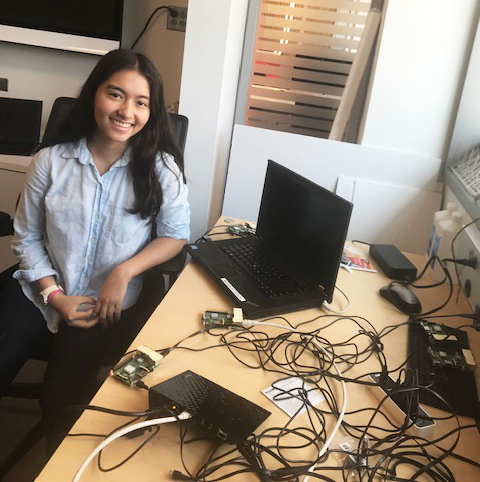
- Lab: Music and Audio Research Lab [Electrical Engineering]
- Faculty: Juan Bello
- Mentor(s):Mark Cartwright, Juan Pablo Bello
- Time: 10:50 - 11:00 am
Abstract: Noise pollution is a phenomenon that significantly decreases the quality of life for many residents in New York City and other urban environments. The Sounds of New York City (SONYC) project aims to mitigate urban noise pollution using a data-driven approach. By combining machine listening with an acoustic sensor network deployed throughout the city, the project is working toward mapping the spatiotemporal patterns of the sources of noise pollution in New York City. In this work, we focus on investigating the causes of noise pollution in Red Hook in particular—the residents of Red Hook believe that the excessive number of trucks passing through their neighborhood is the chief cause of noise pollution in the area. To investigate this hypothesis, we have stationed multiple acoustic sensors in the neighborhood and are building models and tools to quantify and visualize the acoustic patterns related to trucking activity in the area. With such tools, we can then investigate how the implementation of different trucking routes affects the level of noise pollution, in order to implement a route that minimizes the noise heard by the residents of Red Hook and improves their quality of life.
Minuk Kim

- Lab: CATT (Center for Advanced Technology in Telecommunications) [Electrical Engineering]
- Faculty: Shivendra Panwar
- Mentor: Fraida Fund, Mustafa Ozkoc
- Time: 11:40 - 11:50 am
Abstract: Emerging 5G networks comprise multiple novel technologies. It remains unclear what combinations of these are necessary to support new applications in entertainment such as virtual and augmented reality (VR & AR), 3D holographics, and haptics. These applications have various capacity, delay, and reliability requirements. If these are not met, the entertainment experience can be very poor. To address this issue, we will quantify the specific requirements associated with these new entertainment technologies in various scenarios. As a result of this work, we will know more specifically what it will take for future networks to support better media platforms and new, immersive entertainment experiences.
Kaylee Paucar, Bryan Zen
- Lab: Machine Learning Lab [Electrical Engineering]
- Faculty: Anna Choromanska
- Mentor(s): Devansh Bisla
- Time: 11:20 - 11:40 am
Abstract: As the frontier of the age to information, artificial intelligence has time and time again proved to be a powerful tool in terms of human technological advancement. One such advancement is autonomous vehicles; these machines achieve autonomy through harnessing enormous amounts of data and computing calculated weights through the usage of an advanced neural network. The data gathered however proves to be quite tricky to compile. For example, let’s say you want to teach your AI how to avoid crashing vehicles. By conventional means, you would achieve this by crashing vehicles in a testing area. However, proven to be full of inconsistencies and costly to replicate, companies such as NVIDIA explores other vectors to achieve similar data. Through the use of synthetic mediums such as computer simulations, large amounts of data can be produced with high replicability. This synthetic data can then be applied to real life vehicles for further testing. In conducting this research, our team aspires to train an efficient AI using data collected from the car simulation with minimal errors; in turn, proving the viability of synthetic data.
Phincho Sherpa
- Lab: Music and Audio Research Lab [Electrical Engineering]
- Faculty: Juan Bello
- Mentor(s): Vincent Lostanlen, Juan Pablo Bello
- Time: 12:00 - 12:10 pm
Abstract: Understanding the sounds of wildlife is paramount to the conservation of ecosystems. To this end, researchers in bioacoustics deploy recording devices on the field, thus resulting in massive amounts of digital audio data. The goal of this internship is to develop a new method for making sense of long audio files, lasting an entire day or more, without need to actually listen to them in full. In the case of short recordings, a convenient way to visualize sounds is the spectrogram, which represents the vocalizations of animals as bursts of acoustic energy in the time-frequency domain. For bird sounds, this method cannot be directly scaled up to long recordings, because the duration of a bird call (about one tenth of a second) is too short in comparison with the size of a long-term spectrogram pixel (about one minute). Phincho Sherpa will address this problem by modifying the representation of visual intensity in the time-frequency domain. In addition to energy, as is done in the conventional spectrogram, Phincho will explore other indices of acoustic complexity, such as entropy, flux, phase deviation, and per-channel energy normalization magnitude; and assign them to a multidimensional color map.
Albert Wan
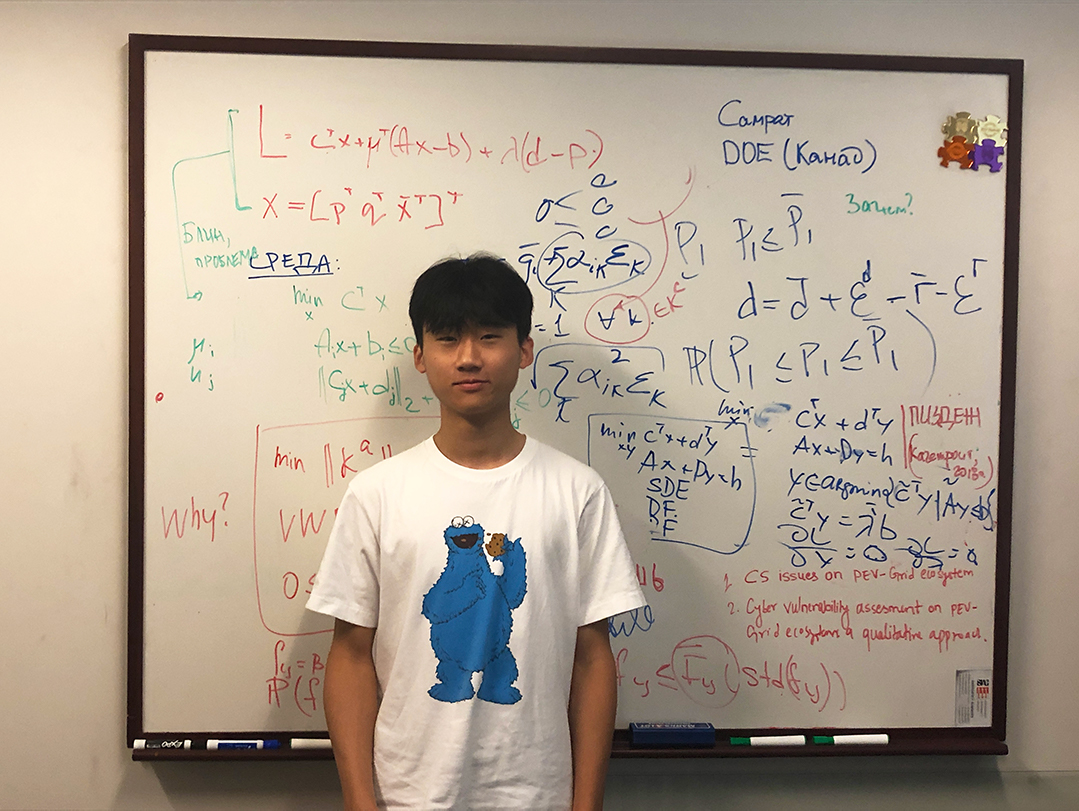
- Lab: Smart Energy Research (SEARCH) Group [Electrical Engineering]
- Faculty: Yury Dvorkin
- Mentor(s): Matt Roveto, Samrat Acharya, and Yury Dvorkin
- Time: 11:10 - 11:20 am
Abstract: Electric power distribution systems are rapidly undergoing considerable changes to their daily operation due to the increased proliferation of smaller-scale distributed energy resources (DERs). While the benefits of such small scale generation are immense and well-documented (e.g. more efficient market and grid operation, lower environmental impact, providing additional means of control to system operators etc.), many technical challenges, such as unpredictable nodal power injections or unacceptably large, system-wide voltage fluctuations, can arise from improperly incorporating DERs into the existing grid. Furthermore, the majority of DERs will be independently owned, which allows the possibility of participants with appropriately sized DERs to undergo strategic decision making in order to exercise a form of market power. In light of this, more work is needed to efficiently and fairly allow for peers in control of a DER to interact with both each other and other participants in the market while ensuring that the network is operated under a given level of security, and will not suffer severely adverse effects from potential individual decision making. In order to investigate this, I will perform a sensitivity analysis of various factors to gain further insight into the effects of strategic behavior in a distribution network, as well as the effects on a distribution network with many peers who are able to bilaterally buy and sell directly to one another.
Mechanical Engineering
Kevin Cheng, Cara Mulrooney

- Lab: Applied Dynamics and Optimization Lab [Mechanical Engineering]
- Faculty: Joo H. Kim
- Mentor: William Z. Peng, Hyun Seok Shin, Jordan Benjamin Birnbaum
- Time: 11:50 - 12:10 pm
Abstract: Currently, there is a lack of accurate models for energy expenditure within the field of robotics. In this work, the energetic properties of the MX-28 servo motor are characterized for the purpose of developing an energy expenditure model for the gait of the DARwIN-OP, a biped walking robot. This research builds on existing modeling work for the Cornell Ranger, a passive dynamic walking robot developed for low power usage. In brushed DC motors, such as the one within the MX-28 servo motor, a voltage drop exists between the brushes and the commutator due to inherent resistance at the contact interface. While the motor torque-speed performance curve is known from previous studies and manufacturer data, this contact voltage drop has not been previously characterized. Using a cantilever setup with a load cell, where the MX-28 test motor is connected to a brake motor, an external torque is applied to stall the test motor. The motor current and voltage are measured with an INA169 Sensor under a specified set of stall torques in order to determine the contact voltage drop at the brushes. The results of these experiments will be employed towards the optimal motion planning of walking robots based on their energy expenditure.
Haqq Coulibaly, Islam McDowell
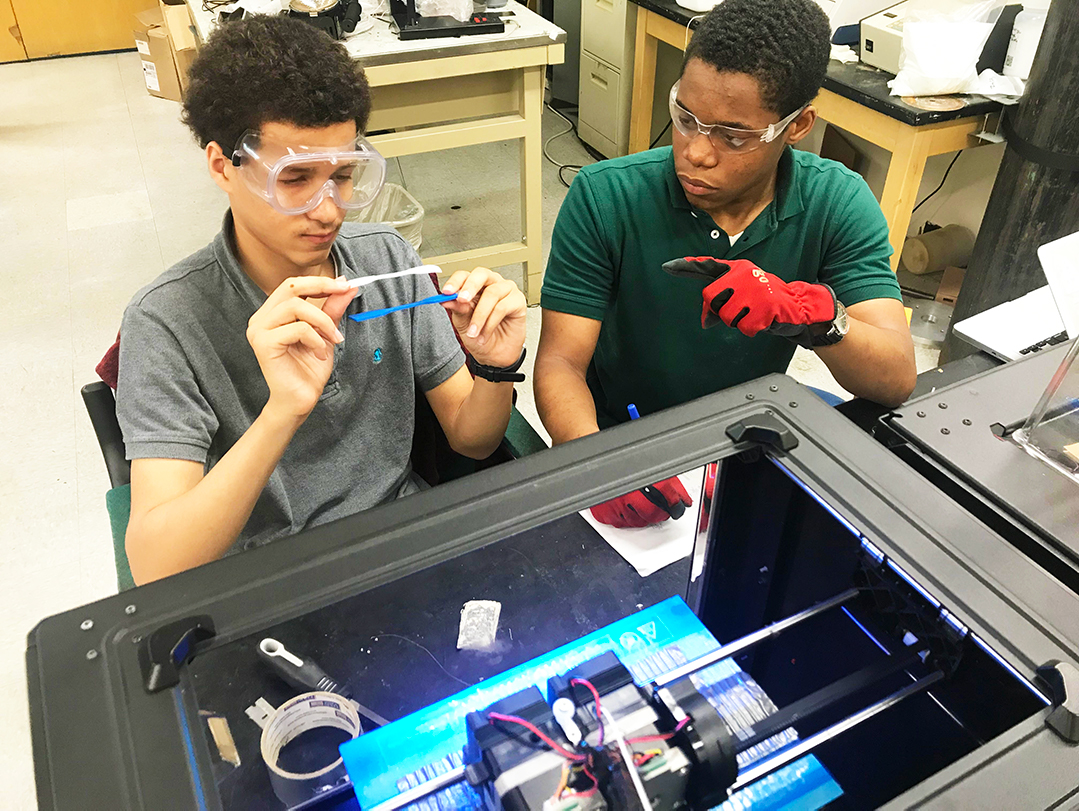
- Lab: CMML [Mechanical Engineering]
- Faculty: Nikhil Gupta
- Mentor(s): Xu, Xianbo
- Time: 11:10 - 11:30 am
Abstract: As a revolutionary technology, 3d printing provides greater design freedom for developing highly customized components. It has already revolutionized design and manufacturing in multiple fields including aerospace, automotive, and medical. The main goal of his project is to develop new composite filament for marine application. Due to its lower density and high specific compressive properties, syntactic foams is widely used in submarine application. In this work, the high-density polyethylene based syntactic foam filaments with various volume percentages are developed. The filament is applied to print testing samples with commercial 3d printer. Then the tensile and high speed properties of the printed materials are investigated. Results will show the strength and modulus of several syntactic foam compositions comparable to those of the neat matrix resin.
Jada Jefferson
- Lab: Dynamical Systems Lab [Mechanical Engineering]
- Faculty: Maurizio Porfiri
- Mentor(s):Roni Barak Ventura, Chiara Spinello, Raghu Ram Sattanapalle
- Time: 10:30 - 10:40 am
Abstract: Approximately 8 out of 10 stroke patients are affected by hemiparesis. Hemiparesis is characterized by muscle weakness on one side of the body, which is associated with a loss of mobility and independence. Rehabilitation can help patients with hemiparesis regain motor function, however the process is arduous and involves repetitive exercises. The aim of this project is to build a platform that will help stroke patients to participate in a citizen science project while undergoing rehabilitation. To this end, a lightweight dowel is turned into a controller by utilizing micro-controllers, an inertial measurement unit (IMU) sensor, and a Bluetooth module. Data is collected from the platform to map human movement and score motor performance toward a remote assessment by a practitioner.
Adrian Kuka, Ithzel Toscano
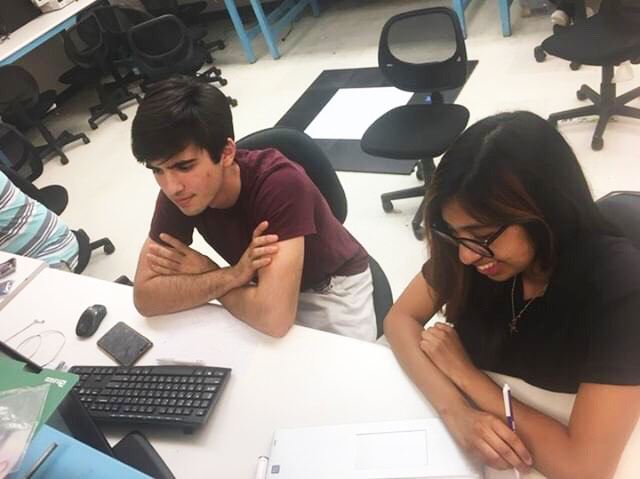
- Lab: Mechatronics, Controls, and Robotics Lab [Mechanical Engineering]
- Faculty: Vikram Kapila
- Mentor(s): Sai Prasanth Krishnamoorthy
- Time: 10:00 - 10:20 am
Abstract: Reinforcement learning is a type of machine learning where an agent is put into an environment only knowing the possible actions it can take. Over time, the agent will learn the most optimal choice to make in each state because each decision has a cost or a reward. Using Reinforcement learning, we will program a robot to find two resources in a five by five map and return them to a drop-off location, and we will create a pendulum that will learn how to balance itself upright with only control of its velocity and angle. We aim to create software to observe and understand these two experiments digitally. Then, we will create physical models to represent them in the real world.
Matias Fernandez Sasso

- Lab: Dynamical Systems Lab [Mechanical Engineering]
- Faculty: Maurizio Porfiri
- Mentor(s): Chiara Spinello, Roni Barak Ventura, Raghu Ram Sattanapalle
- Time: 11:40 - 11:50 am
Abstract: Preclinical research involving laboratory animals traditionally entails the use of live stimuli to study a wide range of behavioral domains, such as social behavior or fear and anxiety related behaviors. Recently, many efforts have been made to replace live stimuli with robotic stimuli. The latter are now frequently integrated in laboratory studies to yield repeatable, customizable, and controllable experimental conditions. In our lab we have been building robotic platforms capable of maneuvering bio-inspired fish replicas in a tank while in interaction with a real fish. In this work, the functionality of our robotic platform will be improved through the implementation of a new microprocessor (Teensy) that will replace the Arduino micro-controller to increase the processing power and reduce the latency of the platform. We will adjust the code to the new micro-controller, and will test the functionality of the platform. The improvement in the platform’s functionality will increase the smoothness and the controllability of the stimuli’s movements in the tank.
2018
Anthropology
Yan Huang, Arika Ahamed
-
Lab: Molecular Anthropology Lab
-
Faculty: Dr. Todd Distotell
- Mentors: Dr. Andrew Burrell, Amber Trujillo
Abstract
Environmental DNA (eDNA) consists of tiny fragments left behind by all organisms that inhabit various environments. NYC is being actively colonized by invasive species and recolonized by endemic ones driven to local extinction in the past 200 years. Many of these newly arriving city residents are cryptic. To explore what species are present in the city, we will be utilizing eDNA to identify vertebrates along a transect of Manhattan from Central Park down to Greenwich Village as well as in several other localities in the metro area. We are sampling soil, extracting and amplifying all the vertebrate DNA present in such samples. We will use high-throughput sequencing techniques to generate hundreds of millions of individual DNA sequences. Using several bioinformatic approaches and analytical pipelines, we will then identify all of the known sequences and place the unknown ones onto the nearest branches of the Tree of Life to give us a more thorough understanding of the biodiversity present in New York City.
Djemila Compaore
-
Lab: Primate Hormones and Behavior
-
Faculty: Prof. James Higham
- Mentor: Laura Newman, Megan Petersdorf
Abstract
The origins of human speech have long been debated. One hypothesis suggests that the foundations of speech, particularly the rhythm of speech, evolved from rhythmic non-vocal facial movements called lip-smacking. Lip-smacking has been observed in multiple primate species and is often considered a form of affiliative communication. However, a large comparative analysis of lip-smacking in primates has not been completed. In this study, we will construct and distribute a survey that asks primatologists from a variety of institutions to document the primate species they study and whether that species exhibits lip-smacking behavior. We will combine the data collected from the survey with published data to conduct a comparative analysis. More specifically, we will investigate the origins of lip-smacking in primates and the patterns of its emergence and disappearance.
Madison Mushnick
-
Lab: Primate Hormones and Behavior
-
Faculty: Prof. James Higham
- Mentors: Megan Petersdorf, Laura Newman
Abstract
Baboons (genus Papio) are a well-studied group of primates, however, relatively little is known about the Kinda baboon (P. kindae). Previous research suggests that their patterns of social grooming differ from other closely-related baboon species. Whereas the majority of social grooming between adults in other species is between females, female Kinda baboons appear to spend more time exchanging grooming with males than other females in their group. When females do groom with other females, with whom are they investing their social time? This project will sequence DNA from fecal samples from a wild population of Kinda baboons to look at genetic relatedness among adult females. We will combine these data with behavioral observations to determine how kinship is related to grooming patterns among females in the population.
Laura Rosas, Anna Shi
-
Lab: Hominin Skeletal Morphology Lab
-
Faculty: Dr. Scott Williams
- Mentor: Cody Prang
Abstract
Reconstructing how human upright walking (bipedalism) evolved depends on an understanding of the appearance of the human-chimpanzee last common ancestor. Whether humans evolved from an ancestor with ground-living, knuckle-walking adaptations as observed in chimpanzees and gorillas (African apes), or a more generalized tree-living one, has been a source of debate in paleoanthropology. Humans and African apes are distinguished from all other primates by the presence of a heel-strike at the beginning of the stance phase of the gait cycle, which results in a plantigrade (heel down) foot posture. The adaptive significance of heel-strike plantigrady has implications for understanding the locomotor behavior of the human-chimpanzee last common ancestor. Currently, plantigrady is thought to reflect a ground-living locomotor adaptation, but most terrestrial animals use different, non-plantigrade (elevated heel) foot postures. Furthermore, several primates that habitually engage in below-branch suspensory behavior have been observed to use occasional heel contact. Here, we evaluate the hypothesis that there is a functional and evolutionary link between plantigrade foot postures and suspensory adaptations in primates. Suspensory New World monkeys and Asian apes (orangutans and gibbons) are expected to have foot bones that are more similar in shape to plantigrade African apes than to generalized arboreal and terrestrial monkeys. We test our morphometric predictions by quantitatively comparing the three-dimensional shapes of foot bones in a representative sample of humans, apes, and monkeys. This study will clarify the evolutionary backdrop for the emergence of bipedal locomotion by testing hypotheses regarding the roles of climbing, suspension, and terrestriality throughout ape and human evolution.
Biology
Alexander Dorfman, Betsy Balbuena
-
Lab: Chromatin Genomics Lab
-
Faculty: Dr. Sevinc Ercan
- Mentors: Matthew Paul, Lena Street
Abstract:
At the Chromatin Genomics Lab, we will deepen our understanding of the relationship between chromatin and transcription. We will do this by studying the protein complex DCC (dosage compensation complex) in Caenorhabditis. elegans worms; the DCC regulates gene expression levels on the X chromosome. We will investigate another protein complex called “Mediator”, which acts as a bridge to help enhancers. This will help us test to see if there is a relationship between DCC and Mediator by using RNAi. In diseases such as cancer, the relationship between chromatin and transcription malfunctions. Our findings will improve our understanding of this relationship, and what goes wrong in disease.
Erica Ayisi-Boahene
-
Lab: Developmental Genomics Lab
-
Faculty: Dr. Christine Rushlow
- Mentors: Shawn Huang, Christine Rushlow
Abstract:
Identification of Zelda target genes in the Drosophila embryo Transcription factors can activate target genes by binding to specific binding site in their regulatory elements. Zelda is a key transcription factor that is distributed uniformly throughout the embryo and binds to CAGGTAG motifs to activate downstream target genes. Zelda is referred to as the zygotic genome activator because it activates many of the genes transcribed in the early embryo. There are two types of Zelda target genes. Class I genes are transcribed uniformly throughout the embryo like Zelda. Class II genes are transcribed in specific spatial domains established by the patterning morphogens. In this study we will characterize a set of putative Class I genes. Previous work has established that they are highly down-regulated in the absence of Zelda, however, the timing of expression – when they are turned on and when they are turned off – has not yet been characterized. Using in situ hybridization techniques, we will analyze when and where they are expressed in early embryos. In addition, using genome-wide data of RNA Pol II binding and chromatin accessibility we will compare genomic features of Class I and II genes to better understand these different types of Zelda target genes, which will lead to a greater understanding of how Zelda, and other genome activators, function in early development.
Daniel Borovskiy
-
Lab: Molecular and Cellular Biology Lab
-
Faculty: Dr. Fei Li
- Mentor: Jinpu Yang
Abstract:
Cells in all living organisms are constantly dividing. During these divisions, it is vital to preserve genetic information (which is stored in chromosomes) by faithful duplication and proper segregation of the sister chromatids. How the sister chromatids get split equally between the daughter cells is largely dependent on the centromere, a chromosomal region where both chromatids intersect to form the X-shape. The centromere, which contains the histone variant CENP-A, provides the foundation for the attachment of the kinetochore and spindle fibers, which segregate chromatids into daughter cells. It is essential for cells to ensure that there is one and only one centromere on each chromosome, because ectopic centromeres lead to multiple attachment of microtubules and unequal chromosome segregation. Mph1 is a kinase that checkpoints the proper establishment of kinetochore before allowing cell division to proceed. Preliminary data suggest that Mph1 physically interacts with the histone H2A.Z. H2A.Z has been previously reported to counteract the establishment of ectopic centromeres. We hypothesize that Mph1 may cooperate with H2A.Z to “checkpoint” the removal of ectopic centromeres. To this end, we study Mph1’s effect on chromosome segregation and its interaction with H2A.Z using the model organism of fission yeast. This project will advance the understanding of how ectopic centromeres are prevented to ensure genetic information is accurately preserved through cell division.
Zirong Chen
-
Lab: Molecular and Cellular Biology Lab
-
Faculty: Dr. Fei Li
- Mentor: Jinpu Yang
Abstract:
In eukaryotic cells, DNA is packaged into different arrangements and structures. How the genome and chromosomes are organized and spaced out is critical for diverse cell functions including DNA replication and gene expression. One such organization is the centromere, a specialized region of a chromosome that drives mitosis by mediating the attachment of spindle fibers, essential in proper chromosome segregation. Since centromeres play such a key role in cell division, understanding what proteins influence the centromere provides insights to diseases such as cancer. Intriguingly, in fission yeast (Schizosaccharomyces pombe) during the interphase of mitosis, the centromeres are clustered together and attached to the nuclear membrane near spindle pole bodies (SPB). Then, these SPBs enter the nuclear envelope and mediate the alignment and segregation of the chromosomes. The mechanisms involved and the functional consequences of this phenomenon remains sparsely studied. Through a genetic screening, we identified a nucleoporin protein, Nup132, that plays a role in clustering of centromere. To gain a better understanding of its function, we use a combination of approaches, including genetics, biochemistry, and imagining, to determine if and how Nup132 plays a role in the arrangement of the centromeres. These data will uncover novel factors and mechanisms that are important for proper chromosome segregation and cell division.
Kaiya Idlett, Zhiheng (Mina) Mai
-
Lab: Chromosome Inheritance Lab
-
Faculty: Dr. Andreas Hockwagen
- Mentor: Jonna Heldrich
Abstract:
Meiosis is a specialized type of cell division that is essential for sexually reproducing organisms and generates genetic diversity. Programmed break and repair of DNA are necessary during meiosis to allow for the proper separation of DNA into daughter cells, but mistakes in this process lead to infertility and birth defects. Our research aims to better understand how DNA breaks are repaired by screening for mutations that affect essential genes and protein functions involved in the repair process. We utilize the rapid growth and simple genome of budding yeast to study meiosis, and since meiosis is conserved from yeast to humans, this work will help us understand more about how meiosis occurs in human cells.
Caitlin O'Neil
-
Lab: Developmental Genomics Lab
-
Faculty: Dr. Christine Rushlow
- Mentors: Peter Whitney, Christine Rushlow
Abstract:
The sog gene is expressed in a lateral stripe in the early embryo, the region that gives rise to the nervous system. This early expression is directed by two enhancers – one located in the first intron of sog termed the primary enhancer and another located 20 Kb upstream of the transcription start site known as the shadow enhancer. Shadow enhancers are presumptively redundant, and thought to act as an evolutionary buffer. However, the impact on transcription is not known if any of these enhancers is lost. To better understand the regulatory logic of multiple enhancers, we generated a sog enhancer deletion using the CRISPR-Cas9 system with two guide RNAs that flank the ~500bp region the enhancer occupies. These animals are viable, however they may display cryptic patterning defects during embryogenesis. To test this, we will perform in situ hybridization staining on early staged embryos when sog is expressed. In development, sog opposes the activity of dpp in the dorsal region of the embryo, therefore in addition to staining for sog activity, we will be evaluating targets of dpp as there may be an expansion in the domain of these genes if sog expression is affected. Performing these experiments will help us better understand how shadow enhancers function in a developmental context, and identify potential compensatory mechanisms that exist in the dorsal-ventral patterning program.
Youssef El Mosalami, Penina Schlesinger
-
Lab: The Systems Proteomics Lab
-
Faculty: Dr.Christine Vogel
- Mentors: Justin Rendleman, Funda Mujgan Kar
Abstract:
Much like humans, cells have ways of reacting to environmental stressors. The 5’ UTR (untranslated region) of stress response messenger RNAs inform the cell when to produce proteins to regulate levels of stress. The rules behind this regulation are not well understood. This experiment uses the method CRISPR/Cas9 to edit the genome of mammalian cells in order to delete a hypothesized translation regulatory element, ZORF (Zero Open Reading Frame). This short six nucleotide sequence may control the expression of the stress response gene ATF4. When the cell is under stress ATF4 translation increases, resulting in escalation of ATF4 protein levels. Upon deleting the ZORF, we believe that the cell will not be able to respond to stress properly due to unmanageable ATF4 production.
Biomedical Engineering
Rubiel Aquino
-
Lab: Applied MicroBioengineering
-
Faculty: Dr. Weiqiang Chen
- Mentors: Apratim Bajpai, Weiyi Qian
Abstract:
Cells affect and are affected by the forces in their milieu. The microscopic size of cells is a challenge when it comes to quantification of these forces. We calculate and visualize these forces using fabricated silicon micropillar arrays dubbed, micropost Array detectors (mPADs). As cells exert tractions they bend silicon micro-pillars which can be tracked visually to demonstrate the displacements being exerted by the cell. These forces are then quantified using Euler–Bernoulli beam theory which states that displacement of a deformation is directly proportional to the deforming force. Substrate stiffness is a mediator of cellular behavior. Here, we use the micropillar system to determine the behavior of HeLa cells on micropillar arrays of length 7 µm, 9 µm and 14 µm, to determine the effect of substrate stiffness on cellular traction and growth.
Fariha Hanif
-
Lab: Applied MicroBioengineering
-
Faculty: Dr. Weiqiang Chen
- Mentor: Renee-Tyler Tan Morales
Abstract:
Current preclinical drug screenings modeled in vivo and in vitro are limited by their inability to have both physiological accuracy and high-throughput. Although in vivo mouse models are the gold standard for testing new therapeutics, it is difficult to extrapolate findings to human patients due to the genetic and physiological disparities between the two. Microfluidics-based in vitro models, however, provide a cost-effective, rapid, and customizable solution to model human diseases (leukemia, glioblastoma, or stroke) by controlling three-dimensional organotypic interactions among human-derived cells. Yet, these static tissue microenvironments fail to recreate both the dynamic oxygen and fluid pressure signatures for disease-specific organs, which may also impact patient responses to therapy. To develop an integrated microphysiological system, microfluidic devices and 3-D printed inserts can be fitted onto a 6-well plate to allow for real-time cell imaging and spatiotemporal control over oxygen and fluid pressure levels for high-throughput drug screenings.
Chemical and Biomolecular Engineering
Elaine Tanel, Matzary Candia
-
Lab: Protein Engineering & Molecular Design Lab
-
Faculty: Dr. Jin Montclare
- Mentors: Andrew J. Olsen, Shamim Reza
Abstract
Organophosphorus agents (OPs) are a class of compounds that comprise many commercial pesticides and military-grade nerve gas agents. OPs inactivate acetylcholinesterase, an enzyme in the nervous system, by binding to their active sites, which leads to accumulation of acetylcholine and subsequent hyper-stimulation of nerve synapses. It has been demonstrated that phosphotriesterase (PTE) enzymes are capable of neutralizing these chemicals. In this project we will synthesize and characterize new PTE enzymes that can protect human bodies and the environment from OPs. These PTE variants have been computationally designed for the detoxification of common chemical threat agents by our collaborators at the NYU Center for Genomics and Systems Biology using Rosetta, a protein-modeling suite maintained by a worldwide consortium of 22 academic labs that make up the Rosetta Commons. Several of the computationally designed PTE variants have been constructed and tested using a model pesticide in house as well as tested using chemical threat agents (VX, VR, and VM) by collaborators at the United States Army Medical Research Institute for Chemical Defense (USAMRICD).
Angella Baigorria, Nathaniel Downes
-
Lab: Multifunctional Material Systems Lab
-
Faculty: Dr. Miguel Modestino
- Mentors: Daniela Blanco, Daniel Frey
Abstract:
An electrochemical cell is a device capable of generating electrical energy from chemical reactions or using electrical energy to power chemical transformations. In an electrochemical cell, an electrode is where the solution and electricity meet for a chemical reaction. The membrane is an important part of an electrochemical cell because it separates the reactants and products to avoid undesired mixing while allowing protons to flow through it. Ideally, the membrane is placed very close to the catalysts to decrease resistance and provide a better flow of electricity. Efficiency of electrochemical cells can be increased with the use of catalyst layers, which ensure close proximity between the membrane and the catalyst particles. This will help the electrical flow of protons, reducing energy input requirements. The project is focused on the development of a protocol to make catalyst inks and screen-print them onto commercially available membranes.
James Zou, Rajaa Elhassan
-
Lab: Bio-Interfacial Engineering and Diagnostics Group
-
Faculty: Dr. Rastislav Levicky
- Mentors: Eshan Treasurer, Vladislav Frenkel, Gao Yuxiang
Abstract:
Synthetic DNA analogs known as Morpholino (MO) have proven to be beneficial for applications in genetics and medical diagnostics/therapeutics due to their uncharged backbone. Specifically, MO has been shown to be effective in gene knockout by hybridizing with specific segments of RNA to prevent it from expressing. This experiment will explore the effects of varying salt and oligomer concentrations on the melting temperature of RNA-Morpholino hybridization. Currently there is not enough data to calculate the melting points of Morpholinos with varying salt and oligomer concentrations; contributing to the library of information about Morpholinos is the main goal of this experiment. UV-vis spectrometry will be used to measure the absorbance of RNA-MO hybridization which will be analyzed to determine melting curves.
Keying Wang, Aaliyah James
-
Lab: Biomolecular Engineering Lab
-
Faculty: Dr. Jin Ryoun Kim
- Mentor: Edward Chau
Abstract:
The misfolding and aggregation of amyloidogenic proteins have been linked to several neurodegenerative diseases such as Alzheimer’s and Parkinson’s Disease. Amyloids typically follow an aggregation pathway where unstructured monomeric units misfold and self-assemble to form neurotoxic oligomeric and fibrillar structures. Studies have shown that the aggregation of α-Synuclein plays a major role in initiating Parkinson’s disease. In our experiment, we want to investigate ionophoric polyphenols compounds that may disrupt and modulate these amyloidogenic aggregation pathways and inhibit α-Synuclein aggregation. Results from the study will contribute towards uncovering the mechanisms behind amyloid protein aggregation, leading to possible therapeutic treatments and the discovery of new diagnostic tools.
Marianne Lee
- Lab: Flow Chemistry with Microsystems Laboratory
-
Faculty: Dr. Ryan Hartman
- Mentor: Tianyi Hua
Abstract:
Nucleation form solution is the first step in crystallization and an essential tool for purification and control crystal structure in pharmaceutical industry. Supersaturation as the driving force is critical to the nucleation kinetics study. Microfluidic devices provide convenience for real-time in situ characterization of nucleation and crystal growth. However, the measurement of supersaturation from microliters of fluid is tedious and challenging. Physical properties change with an increasing solution concentration, one of them being conductivity. In this present work, we designed a microfluidic conductivity meter for supersaturated solution. The device is incorporated with a thermoelectric cooler that controls the supersaturation simultaneously. Measuring the conductivity of the solution as it is flowing through the reactor is feasible with this microfluidic device, which makes it a perfect add-on part to other microfluidics devices. We plan to work out the temperature-supersaturation relationship of potassium chloride solution in the near ambient condition. The results of this work will be presented the colloquium.
Grace Lin
-
Lab: Flow Chemistry with Microsystems Laboratory
-
Faculty: Dr. Ryan Hartman
- Mentor: Tianyi Hua
Abstract:
Nucleation form solution is the first step in crystallization and an essential tool for purification and control crystal structure in pharmaceutical industry. Supersaturation as the driving force is critical to the nucleation kinetics study. Microfluidic devices provide convenience for real-time in situ characterization of nucleation and crystal growth. However, the measurement of supersaturation from microliters of fluid is tedious and challenging. Physical properties change with an increasing solution concentration, one of them being viscosity. In this present work, we designed a microfluidic viscosity meter for supersaturated solution. The device is incorporated with a thermoelectric cooler that controls the supersaturation simultaneously. Measuring the conductivity of the solution as it is flowing through the reactor is feasible with this microfluidic device, which makes it a perfect add-on part to other microfluidics devices. We plan to work out the temperature-supersaturation relationship of potassium chloride solution in the near ambient condition. The results of this work will be presented the colloquium.
Mohammad Nasir
-
Lab: Nanostructured Hybrid Materials
-
Faculty: Dr. Ayaskanta Sahu
- Mentors: Ingrid Joylyn Paredes, Michael Scimeca, Haripriya Kannan
Abstract:
Sustainable energy is one of the most pressing issues that society faces today. With traditional materials reaching their performance limits, the development of new materials will lead us to meet the global demand for energy in a clean and sustainable fashion. Hybrid materials are an emerging class of compounds that combine inorganic and organic components to produce materials with performance greater than the sum of their parts. Our lab seeks to gain fundamental understanding of the electronic and thermal properties of these hybrid systems. We will do this via the synthesis and characterization of hybrid materials, looking at the effect of composition, size, and shape on thermal and electronic properties. Once reliable methodologies for synthesis have been developed, we will implement our materials into devices including light emitting diodes, solar cells, and thermoelectric coolers.
Civil and Urban Engineering
Evolone Layne, Swan Yee Aung
-
Lab: Urban Modeling Group Lab
-
Faculty: Dr. Debra Laefer
- Mentor: Debra Laefer
Abstract
The federal government mandates that utility companies maintain their above ground lines free of interference from local vegetation. This mostly consists of trimming trees to prevent them coming into contact with above ground electrical wires. Current practice involves manual inspection which is time consuming, expensive, and subjective. This project seeks to streamline the maintenance process by developing an automatic system to predict when a tree is likely to come in contact with a line, thereby minimizing manual inspection and enabling a more systematic approach to intervention against vegetation incursion. This will involve automatically identifying both above ground utility lines and trees in high density laser scanning data, determining the current distance between a tree and a utility line, identifying and employing appropriate tree growth models for a site specific locale, and combining these processes into a single software tool for localized incursion prediction.
Tabassum Fabiha, Doris Chen
-
Lab: CUITS: Urban Mobility and Intelligent Transportation Systems (UrbanMITS) Laboratory
-
Faculty: Dr. Kaan Ozbay
- Mentors: Abdullah Kurkcu, Jingqin Gao, Kaan Ozbay
Abstract
In densely populated urban areas, a large contributing factor to traffic congestion and travel delays is parking. This study aims to improve parking efficiency on the streets by developing laser based portable sensors that can be attached to vehicles or bicycles and collect information about the roadside. Algorithms will be implemented using Python and R to automatically detect empty spaces. The collected points are then mapped through a geographic information system (GIS). Simulations will be run before the deployment of the sensors and will be used to check the accuracy and precision of the data collected. In addition to detecting roadside parking spaces, this proposed system will also identify instances of double parking, information on bike lanes and other roadside data.
Annie Eng
-
Lab: CUITS: Behavioral Urban Informatics, Logistics, and Transport (BUILT)
-
Faculty: Dr. Joseph Chow
-
Mentors: Yueshuai He, Assel Dmitriyeva
Abstract
Big data has transformed the transportation industry to make daily commuting efficient with its advances in sensors, telecommunications, safety and etc. As the visualization of big data in transportation becomes increasingly significant and prominent nowadays, it effectively analyzes challenges and setbacks such as traffic volume and congestion, road infrastructure, asset management, and logistics and supply chain management. With the contribution of the free and open source Quantum Geographic Information System (QGIS) software, this allows users to analyze and edit spatial information, as well as formatting and exporting graphical maps. We’ll be specifically examining data drawn from Wuhan, China where Global Positioning System (GPS) trajectory data can be determined from locations of low and high traffic and monitoring geospatial data. This research will help us gain descriptive stats on Wuhan’s taxi data and observe the route selection behaviors of taxi drivers.
Chengyuan Wang
-
Lab: CUITS: Behavioral Urban Informatics, Logistics, and Transport (BUILT)
-
Faculty: Dr. Joseph Chow
- Mentors: Yueshuai He, Assel Dmitriyeva
Abstract
In the era of smart city, data sharing between private operators and public agencies is becoming more important than ever before. New York City takes a lead in data sharing, for example, the NYC Open Data shared lots of useful data to public. However, it is still not enough. Due to privacy concerns, private operators are reluctant to share their data, which leads to an obstacle to smart cities. To overcome this obstacle, we are trying to seek a way to preserve the privacy of data and at the same time provide enough data accuracy. My project deals with operator privacy by proposing a method, involving diffusion of the data objects to mimic the anonymity objective. The method can provide messy or biased data that lessens the risk of the data being inferred. Through the research, the method will be applied to a real dataset to evaluate whether it will be successful.
Daniel Gomez, Tina Wong
-
Lab: Future Building Informatics and Visualization Lab (biLAB)
-
Faculty: Dr. Semiha Ergan
- Mentors: Zhengbo Zou, Celia Yu, Zhuoya Shi
Interior design and architecture have been known to cause effects on human experience. Previous projects, investigating these relationships, have found strong correlations between specific design features and their impact on the four main sensations. These sensations include sense of stress and anxiety, restorativeness, sense of aesthetics/pleasure, and sense of approach motivation. Data from past trials has been recorded from electroencephalogram headsets (EEGs), electrocardiograms (ECGs), electromyography units (EMGs), facial expression emotion recognition technology, and eye tracking technology. In this project, we use Unity models to create a virtual environment to simulate interior design features for a human subject. The subject’s biometric data is recorded prior to beginning the test in order to establish a baseline data set. Once the test has begun, the changes in their responses, such as an increase in stress levels, are noticed by a script and recorded. The recorded data is then used, along with previously discovered correlations between certain design features and human reactions, to positively modify the virtual environment. As specific relationships have already been recorded, such as an increase of natural light decreasing stress, these relationships are used by the script in order to procedurally generate different architectural properties in order to improve human experience. The primary objectives are to minimize stress and general unhappiness in the subject, while maximizing restorativeness and motivation to perform tasks in the virtual environment. This can be applied to better physical design spaces and boost real world productivity.
Noor Al Muzahidz, Manting Yu
-
Lab: Soil Mechanics Lab
-
Faculty: Dr. Magued Iskander
- Mentors: Abdelaziz Ads , Linzhu li
Abstract:
Terzaghi’s Bearing Capacity Theory (1943) has been used by engineers for years to determine the ultimate bearing capacity of soil under the footing. Footing shape, footing depth, and soil shear parameters are the main factors that control the bearing capacity of soil. Footing shape has an important effect on the soil capacity, as it can control the shear failure model. In this study, we will investigate the stresses that occur inside the soil due to different shape ratios – shape ratio is the ratio between the length and the width of the footing. There will be three different shape ratios and two different types of transparent soil utilized in this investigation. Laponite will be used to represent soft clay and fused quartz will be used to represent sand. All the footings used in this study will have the same contact area with soil. The material of the footing will be plastic for the soft clay Laponite to reduce the weight and the steel for the footing used in fused quartz to reduce footing deformation. Using transparent soil and digital image correlation (DIC) results will enable us to determine the soil particles displacement, vertical and horizontal, under the footing, as well as estimate shear strain and the volumetric strain. Loading tests will be performed to determine the maximum load and this load will be compared to Terzaghi’s equation selected value. From the analysis, we can establish the best shape for footing in the case of soft clay and fused quartz and shear failure model.
Computer Science and Engineering
Efecan Balci
-
Lab: Visualization and Data Analytics
-
Faculty: Dr. Enrico Bertini
-
Mentors: Cristian Felix
Abstract:
With the increasing number of text data being produced, text analysts have used text summarization techniques as a way to understand the contents of a text collection without reading all of it. One such method is topic modeling; topic modeling uses statistical inference to automatically extract a set of topics that convey what the central themes described in the data is. For each document, it assigns one or more topics, of which each is represented by a list of keywords that the analyst has to interpret and often assign an actual label to it. For example, the method may output a topic represented by the words “school”, “student”, “college” and “university“ and the analyst may assign the label “education” to it. Many methods have been proposed to automate the label assignment step; these methods often rely on using the keywords to query a general knowledge dataset like Wikipedia and using the title of the articles as labels. These methods restrict the possible labels only to the different titles in the dataset where the query was executed, and also, relies solely on the keywords extracted by the topic modeling algorithm, ignoring the content of the documents associated to the given topic. In this project, we propose the use of text generation neural networks as a way to label topics based not only on the keywords but also using the content of the documents associated with the topic. We use an encoder-decoder architecture where first the encoder receives as input the keywords and a sample of the documents and outputs a context vector that will be an intermediate representation of the “meaning” for the topic. The decoder receives this context vector and generates a label for the topic one word at a time. The model is trained using a mix of datasets including Wikipedia and news datasets, where the goal is to generate the title of the article given the article content and a set of keywords. We implement the model using Keras API with Tensorflow as the backend for both, training and prediction steps. The architecture of our encoder-decoder network is mainly based on a method called Long Short-Term Memory (LSTM), which is a type of Recurrent Neural Network that has been showing good performance when dealing with projections. This model, later, will be used in a text analysis system to provide a more concise summary of the collection to the analyst, showing only the labels rather than lists of keywords.
Justin Chan
-
Lab: Visualization and Data Analytics
-
Faculty: Dr. Enrico Bertini
- Mentors: Jun Yuan
Abstract:
A common method data analysts use is the grouping of similar data entries such that all elements obtain a structure that indicates the data is separable. Unsupervised clustering algorithms are widely used in visualization and exploratory data analysis, seeking information from the properties of the data to create divisions or discrete labels for each point. Different projection systems and algorithms assist analysis by effectively plotting the data and conveying similar information concisely. Recent years have seen a growth in more extensive, multidimensional datasets due to the fixation of recording data at a far granular level than done in the past, increasing the difficulty of data analysis. Both multidimensional projection and clustering algorithms are essential techniques supporting analysts to finish tasks regarding the similarity of observations and finding groups in datasets. There are methods for evaluating the reliability and stability of projections and clustering algorithms independently but the combination of both techniques is rarely evaluated. Our comparative study will test how projection methods agree with the results produced by clustering in both quantitative and visual ways and provide suggestions on the use of the combination of projection and unsupervised clustering algorithms on multidimensional data based on reliability and efficiency.
Electrical and Computer Engineering
Giordan Escalona
-
Lab: Music and Audio Research Lab (MARL)
-
Faculty: Dr. Juan Bello
- Mentor: Mark Cartwright
Abstract:
Noise pollution is an important quality of life issue in urban environments like New York City and has proven detrimental effects on education, health, and the economy. The Sounds of New York City (SONYC) project aims to bring awareness to this problem by deploying a network of acoustic sensors throughout the city to monitor and analyze noise pollution using machine listening. To support this effort, we have developed a database of various events in the city that affect noise pollution and the functionality of our acoustic sensors, e.g. construction, weather, concerts, large public gatherings. Using this data, we investigated the relationships between these events and the noise levels in the city. This analysis can help both the city’s government and its inhabitants to make more informed decisions. In addition, the event database can help focus our audio annotation efforts which would subsequently improve our machine-listening models to automatically identify noise sources.
Elizabeth Mendoza
-
Lab: Music and Audio Research Lab (MARL)
-
Faculty: Dr. Juan Bello
- Mentor: Vincent Lostanlen
Abstract:
Annual variations in the migratory routes of passerines is among the predominant markers of ecological disruption at temperate latitudes. Yet, although it is well established that migratory birds face an ever-increasing number of threats — including habitat loss, invasive species, and collisions with buildings or vehicles — little is known about the respective factors of risk influencing the abundancy of a given species at a fire spatiotemporal resolution. In this context, the deployment of an acoustic sensor network of autonomous recording units (ARU) offers an interesting trade-off between a relatively low cost and a highly informative output. Yet, despite the growing interest for bioacoustic analysis in avian ecology, the scalability of ARU deployment is currently hampered by the shortage of human experts that are trained to pinpoint and identify bird vocalizations in continuous audio recordings.
Jessica Belov, Destiny Rivera
-
Lab: Smart Energy Research (SEARCH) Group
-
Faculty: Dr. Yury Dvorkin
- Mentors: Jip Kim, Ali Hassan
Abstract:
With a peer-to-peer structure in mind, we will use machine learning to improve the electricity supply in an urban environment. Because of uncertainty factors such as weather, location and time, energy consumption is difficult to predict. On the other hand, some electricity resources such as solar panels are also variable. As a result, it is sometimes difficult to exactly match the electricity demand and supply. The objective of this research is to explore the possibilities of using machine learning to stably match peers and connect them to the electrical grid. Using machine learning we would be able to estimate the electricity consumption and generation of each peer. And adding on with some research, we would be able to figure out some solutions to mitigate the effect of uncertainties.
Zoe Wu
-
Lab: CATT Center for Advanced Technology in Telecommunications & Distributed Information Systems
-
Faculty: Dr. Shivendra Panwar
- Mentor: Fraida Fund
Abstract:
Researchers doing experiments in computer networks often need to generate realistic background traffic as part of their experiment, but despite its importance, there is no comprehensive, up-to-date, and public dataset of network traffic from popular applications. This lack of a dataset is a problem because researchers are then left to use limited data or synthetic traffic patterns, potentially skewing results of their experiment. To address this, we capture network traffic while running a variety of real applications, and make this dataset publicly available along with a tool that allows researchers to “play back” this captured data in the background of their experiments. We hope that by helping researchers produce more accurate results, we can ultimately improve the quality of Internet services.
Mechanical and Aerospace Engineering
Angelisa Cortorreal
-
Lab: Dynamical Systems Lab
-
Faculty: Prof. Maurizio Porfiri
- Mentor:
Abstract:
Zebrafish are an excellent animal model for preclinical research in various fields such as genetics and neurobiology. However, there is little knowledge regarding spatial learning in zebrafish. In this work, we explore both the individual and social learning of zebrafish. We focus on their ability to spatially discriminate within their environment. We conduct individual training sessions during which one live zebrafish has to trigger the correct door in order to join a fish shoal. We develop a code using MATLAB to analyse the trajectories of zebrafish, focusing on specific indicators of learning. We hypothesize that the zebrafish will learn which is the correct door. This experiment will expand our knowledge on the learning capabilities of zebrafish.
Manjashan Ghotra
-
Lab: CMML Composite Materials
-
Faculty: Dr. Nikhil Gupta
- Mentor: Ashish Kumar Singh
Abstract:
Additive manufacturing (AM) is a revolutionary technique that allows the manufacturing of complex parts with great flexibility that is not present in other manufacturing techniques. Polymer components are conventionally produced using techniques like plastic injection molding (PIM) and compression molding (CM), both of which can produce parts at high volume rate but require specialized tooling and strenuous process parameter optimization. AM method like fused filament fabrication (FFF) or 3D printing is used widely to manufacture polymer parts, but the materials used for this method, like acrylonitrile butadiene styrene (ABS) and polylactic acid (PLA), are not suitable for structural applications. In this study, we study the potential of using HDPE and its composite to produce parts by 3D printing. HDPE is a widely used structural polymer but is not used that often for AM. Dimensional fidelity of 3D printed HDPE parts will be compared to ABS and PLA parts. Printing parameters will be optimized to obtain high quality parts of HDPE and some commercial parts will be produced to possible replacement in weight sensitive applications.
Cristal Nestor Porfirio
-
Lab: Dynamic Systems Lab
-
Faculty: Dr. Maurizio Porfiri
- Mentor: Roni Barak Ventura
Abstract:
During physical rehabilitation, patients exhibit low compliance with their prescribed physical therapy at home. Various novel technologies can be employed in order to promote engagement in rehabilitation. Virtual reality (VR) is a very popular and interactive tool that has been gaining traction in many fields, including rehabilitation medicine. In this project, we will use computer aided design (CAD) to create objects that can appear in virtual reality environments. Specifically, we will create a 3D animation in Blender illustrating a patient using VR.
Vanessa Vasquez, Farhana Rahman
-
Lab: Mechatronics
-
Faculty: Dr. Vikram Kapila
- Mentor: Sai Prasanth Krishnamoorthy
Abstract:
Swarm robotics is increasingly being utilized both commercially and tactically. Current systems, such as those implemented by Intel, use centralized systems that can be problematic given that one minor malfunction can lead to issues on a larger scale; centralized systems have a limit to the number of robots that can be controlled at once and offer little room for error–if the main computer shuts down, so does the entire swarm. As a result, our research seeks to prove the feasibility of obtaining formation control through a decentralized system, which lacks the disadvantages of its centralized counterpart. Focusing specifically on developing an application that visually expresses the accuracy of formation control in a decentralized system, we use ROS, Raspberrypi3, and a camera in order to create a graphical representation of the movement of the robots with respect to their expected positions.
Isabella Fraczek, Kang Hwu Yie
-
Lab: Applied Dynamics & Optimization Lab
-
Faculty: Dr. Joo H. Kim
- Mentor: Hyun Seok Shin, William Peng, Carlos Gonzalez, Fangni Zeng
Abstract:
Passive dynamic walkers are underactuated systems that require minimal energy for motion. In this research, we analyze the passive dynamics and energy expenditure of a partially actuated passive dynamic walking robot. Numerical simulations will be conducted to predict the initial conditions necessary to produce various steady-state walking trajectories and also the corresponding energy expenditure. The simulation results will be validated with experimental walking trials at various initiating forces and initial configurations. The energetic cost of the walking trajectories will be determined by measuring the state of the batteries before and after each walking trial. The results of this research will be employed to optimize the design of the robot to enhance its balancing properties and to exploit new balance controllers while considering both stability and energy efficiency.
Oscar Yong
-
Lab: CMML Composite Materials
-
Faculty: Dr. Nikhil Gupta
- Mentor: Fei Chen
Abstract:
Additive manufacturing (AM) is the process of joining materials layer by layer to make parts from computer-aided design 3D model, which has gained popularity among industries such as aerospace, architecture, automotive, and biomedical for low labor costs, minimum assembly requirements, and high design freedom. The ease and benefits of adopting an AM system have also imposed several security concerns due to the nature of its digital process chain. Like other cyber-physical systems, the AM system is vulnerable to cyberattacks including, but not limited to, intellectual property theft, design tampering, and reverse engineering. An identifying code is embedded in a 3D CAD model to serve as unique signature for authentication and prevent counterfeiting reproductions. Selective laser melting (SLM) 3D printing method is used in the present study to produce standard tensile specimens and specimens with embedded identifying codes in AlSi10Mg alloy. The effects of several heat treatments post-processing on these embedded codes are investigated by comparing their microstructure evolution under optical microscope and scanning electron microscope. These experiments will allow the carefully designed and embedded identifying patterns to survive post-processing treatments without sacrificing the product functionality.
2017
Anthropology
Noemie Bacigalupi
- Lab: Molecular Anthropology Lab
- Faculty: Todd Disotell
- Mentor: Dr. Andrew Burrell and Laura Matthews
Abstract:
Museum specimens, skins, dried tissues, and other biological materials are a valuable potential source of DNA for evolutionary and other studies. We will be comparing several different methods of DNA extraction and library construction for genome level sequencing. A series of bioinformatic approaches will be used to measure the accuracy, quality, and quantity of genome sequence data generated using the different strategies.
Etta Harshaw, Zofia Caes
- Lab: Primate Hormones and Behavior Lab
- Faculty: Prof. James Higham
- Mentor: Rachel Petersen, Alex DeCasien
Abstract:
In order to understand how humans evolved such large brains, we need to investigate the genetic variation underlying species differences in brain size. To do this, we will examine genes associated with human megalencephaly (abnormally large, malfunctioning brain) and/or macrocephaly (abnormally large skull, not necessarily malfunctioning brain) across more than 20 primate species. More specifically, we will test each gene for evidence of positive selection, which would indicate that changes to that particular gene were favored throughout evolutionary time. We will also test for relationships between selection pressure and brain size across primates. Finally, we will sequence these genes in species whose genomes have not yet been sequenced.
Maria Giraldo
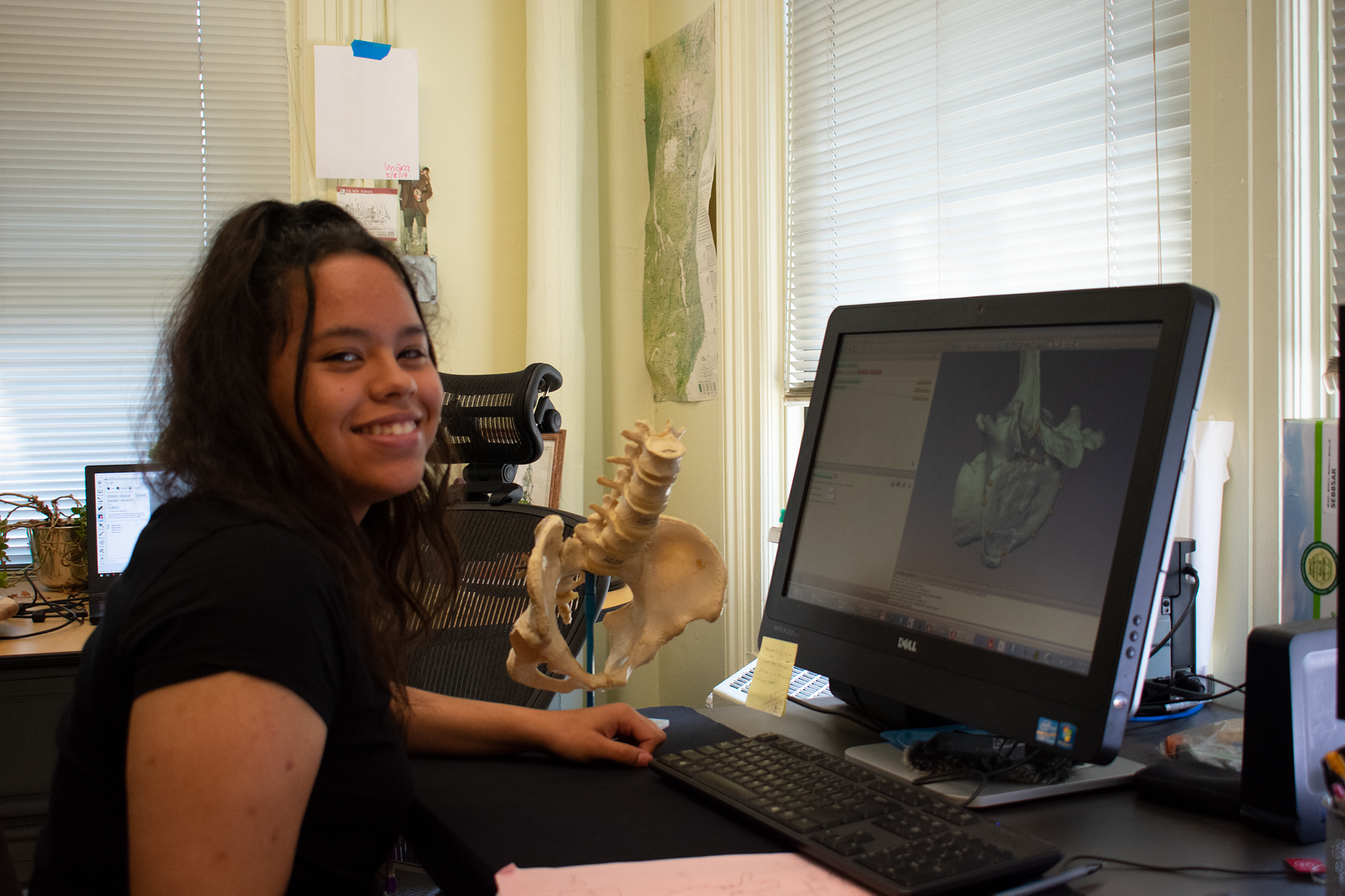
- Lab: Hominin Skeletal Morphology Lab
- Faculty: Prof. Williams, Scott A.
- Mentor: Prang, Thomas Cody
Abstract:
The evolution of upright posture is a key transition that occurred in hominoid (ape and human) evolution, one that set the stage for the evolution of bipedal locomotion in hominins (members of the human lineage). The vertebral column, and especially the lumbar vertebrae, experience loads from the upper body and transmit weight to the pelvis during upright posture. Human lumbar vertebrae clearly demonstrate numerous weight-bearing features related to bipedalism, and those of great and lesser apes varyingly possess a more limited set of features related to weight-bearing during upright posture. Several fossil apes from the Miocene epoch are thought to be adapted to upright posture, but perhaps not to the same degree as living apes. Using 3D models generated from an optic scanner, we measure cross-sectional features of lumbar vertebrae and quantify their 3D shape in hominoids, Old World monkeys, and New World monkeys to generate a framework in which to compare and interpret lumbar vertebrae of three Miocene hominoids, Ekembo, Morotopithecus, and Pierolapithecus. Our comparative study will allow us to test the degree to which these species engaged in upright locomotor behaviors and perhaps shed light on when and how many times upright posture evolved in hominoid primates.
Holy He
- Lab: Hominin Skeletal Morphology Lab
- Faculty: Prof. Scott Williams
- Mentor: Cody Prang
Abstract:
Bipedalism is one of the key adaptations that distinguish humans from other animals. Whether humans evolved from an ape-like quadrupedal knuckle-walking ancestor or a more generalized arboreal monkey-like one remains under considerable debate. African apes (chimpanzees, bonobos, and gorillas) share numerous morphologies of the distal radius (lower forearm) purported to reflect their unique knuckle-walking adaptation, but it is unclear whether these traits could be equally explained by other aspects of their locomotor repertoire such as vertical climbing and suspension. The purpose of this project is to test the hypothesis that the distal radius of African apes reflects an adaptation to terrestrial knuckle-walking. To test this hypothesis, we will collect shape data from digital three-dimensional models of the distal radius in multiple species of monkeys and apes that engage in varying forms of arboreal and terrestrial locomotion, climbing, and suspension. Our hypothesis would be falsified if any of the individual African ape species clusters with non-knuckle-walking species. We will then reevaluate the distal radius morphology of fossil hominins (e.g., ‘Lucy’) to make inferences about the locomotor behavior that preceded bipedalism. The results of this study will have implications for better understanding the evolution of human bipedalism and form-function relationships in living anthropoid primates.
Aziza Kurbonova
- Lab: Molecular Anthropology Lab
- Faculty: Prof. Todd Disotell
- Mentor: Dr. Andrew Burrell and Amber Trujillo
Abstract:
All organisms shed DNA into the environment they inhabit. DNA persists over time in soil, water, and even the air. This “environmental” DNA, or eDNA, can be extracted from environmental samples and sequenced, allowing us to identify what organisms are present in a habitat. We will be experimenting with several different methods of extracting eDNA and generating 16s rRNA sequences to identify all organisms present in a sample. Several bioinformatic approaches will be used to identify known organisms and to classify unknown sequences.
Biology
Lyla Rose, Marge Alarcon
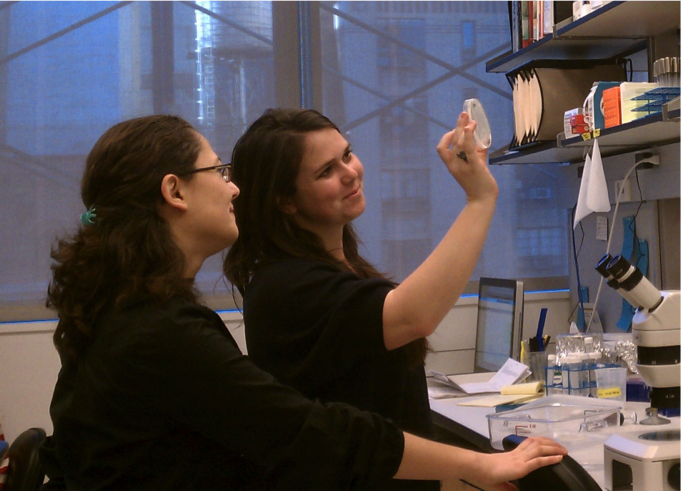
- Lab: Chromatin Genomics Lab
- Faculty: Prof. Sevinc Ercan
- Mentor: Michael Carrozza, Matthew Paul
Abstract:
In humans and other animals, chromosomes are organized and packaged inside a small nucleus. Proper packaging of DNA is required for normal gene expression, and is disrupted in disease. This project investigates how an evolutionarily conserved protein complex, called “condensin” binds to and compacts chromosomes. The students will perform molecular cloning and bacterially express small portions of condensin proteins that are capable of making physical interactions with basic chromosomal proteins. These recombinant proteins will be used to determine and test the function of structural features behind condensin interaction with chromosomes.
Yeji Lee, Tasneem Ibrahim

- Lab: Chromosome Inheritance Lab
- Faculty: Prof. Andreas Hochwagen
- Mentor: Viji Subramanian
Abstract:
Meiosis, a process central to sexual reproduction, allows organisms to pass their genome (DNA) to the next generation. Mistakes in meiosis are the leading cause of infertility, spontaneous fetal loss and birth defects. Controlled DNA breakage and repair are integral to completion of meiosis and for preventing mistakes during this process. Our research aims to uncover novel mutations that affect DNA repair during meiosis using baker’s yeast as a model organism. These studies take advantage of the fast growth and comparatively simple genome of yeast. Because meiosis is conserved from yeast to humans, our research will provide a better understanding of meiosis in humans.
Sarah Kim
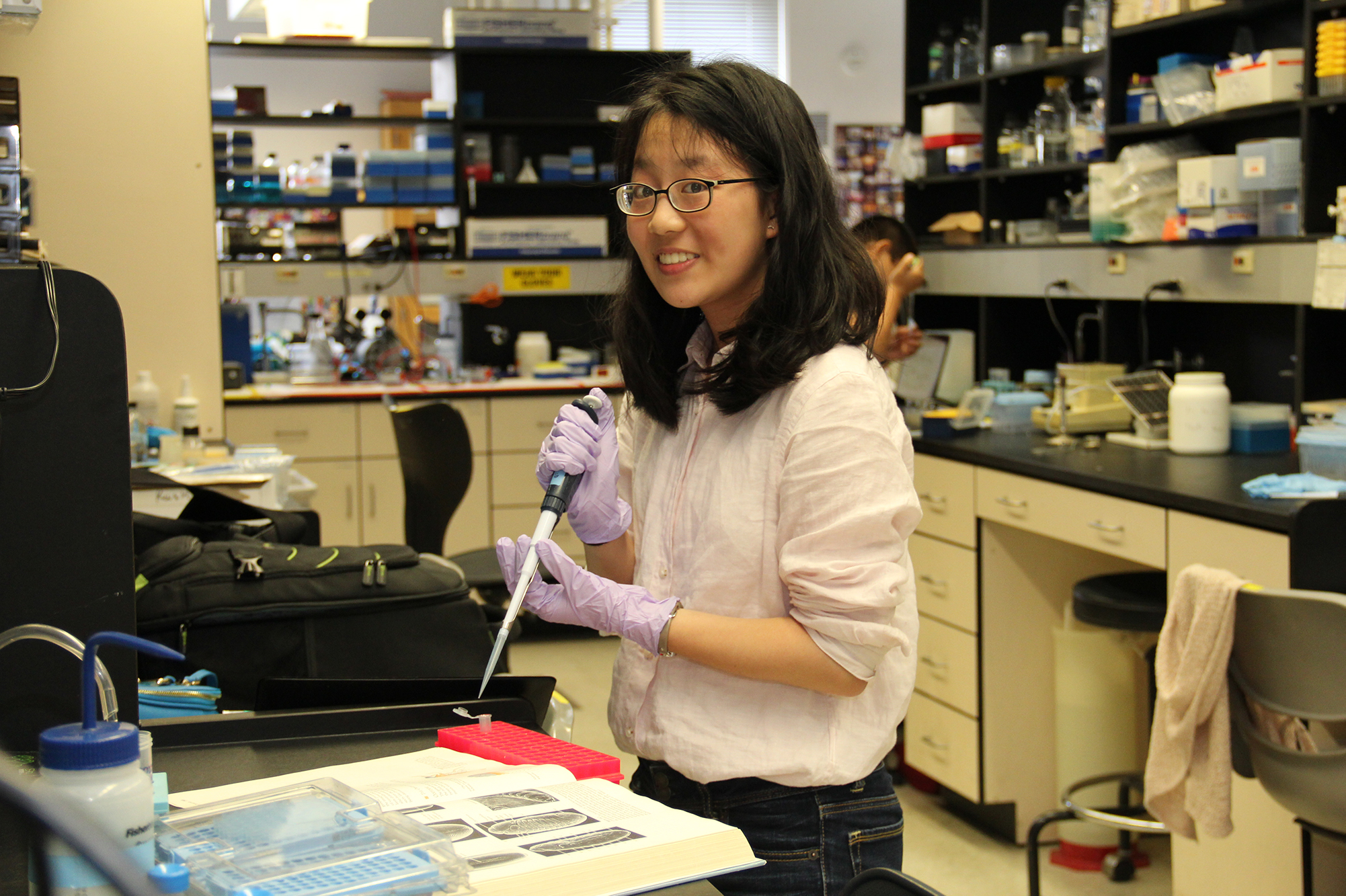
- Lab: Developmental Genomics Lab
- Faculty: Prof. Chris Rushlow
- Mentors: Shao-Kuei Huang & Patrice Delaney
Abstract:
Zelda (Zld) is a master transcription factor regulating gene expression during Drosophila embryogenesis. It has been shown that zld is also expressed in the larval imaginal discs and the brain and nervous system. To understand how zld gene transcription is controlled in different tissues, we chose several putative enhancer fragments to test their activity. Fly lines with a reporter gene driven by a single fragment were generated. Using probes against the reporter gene for in situ hybridization, we will reveal any expression pattern driven by these fragments. Reporter gene expression that matches any part of the zld pattern indicates that we have identified specific enhancers, which will be further examined to better understand the regulation of Zld throughout development.
Regina Lekumovich, Andy Wang

- Lab: The Systems Proteomics Lab
- Faculty: Christine Vogel
- Mentor: Shuvadeep Maity, Justin Rendleman
Abstract:
A cell cannot change its genetic composition in order to respond to an environmental stress, however it can change which genes are expressed during stress conditions. Messenger RNAs are the templates that dictate which proteins should be made; while the coding sequence of a messenger RNA determines the amino acid composition of a protein, the 5’ untranslated region holds important regulatory information that can control when, where, and how much a protein is synthesized. Importantly, the 5’ untranslated region can act as a sensor for different stresses in order to turn genes on and off when needed. To identify new features that control the expression of stress response genes, we will utilize a dual luciferase assay to test the functional relevance of potential regulatory elements within the 5’ untranslated region. Once established, this assay will be applicable to assess numerous genes across a wide range of conditions.
Ye Cheng Zheng

- Lab: Developmental Genomics Lab
- Faculty: Prof. Chris Rushlow
- Mentors: Patrice Delane, Shawn Huang
Abstract:
Transcription factors can activate target genes by binding to specific binding sites in their regulatory elements. Zelda is a key transcription factor that is distributed uniformly throughout the embryo and binds to CAGGTAG motifs to activate downstream target genes. Zelda is referred to as the zygotic genome activator because it activates many of the genes transcribed in the early embryo. There are two types of Zelda target genes. Class I genes are transcribed uniformly throughout the embryo like Zelda. Class II genes are transcribed in specific spatial domains established by the patterning morphogens. In this study we will characterize a set of putative Class I genes. Previous work has established that they are highly down-regulated in the absence of Zelda, however, the timing of expression – when they are turned on and when they are turned off – has not yet been characterized. Using in situ hybridization techniques, we will analyze when and where they are expressed in early embryos. In addition, using genome-wide data of RNA Pol II binding and chromatin accessibility we will compare genomic features of Class I and II genes to better understand these different types of Zelda target genes, which will lead to a greater understanding of how Zelda, and other genome activators, function in early development.
Biomedical Engineering
Joya Debi
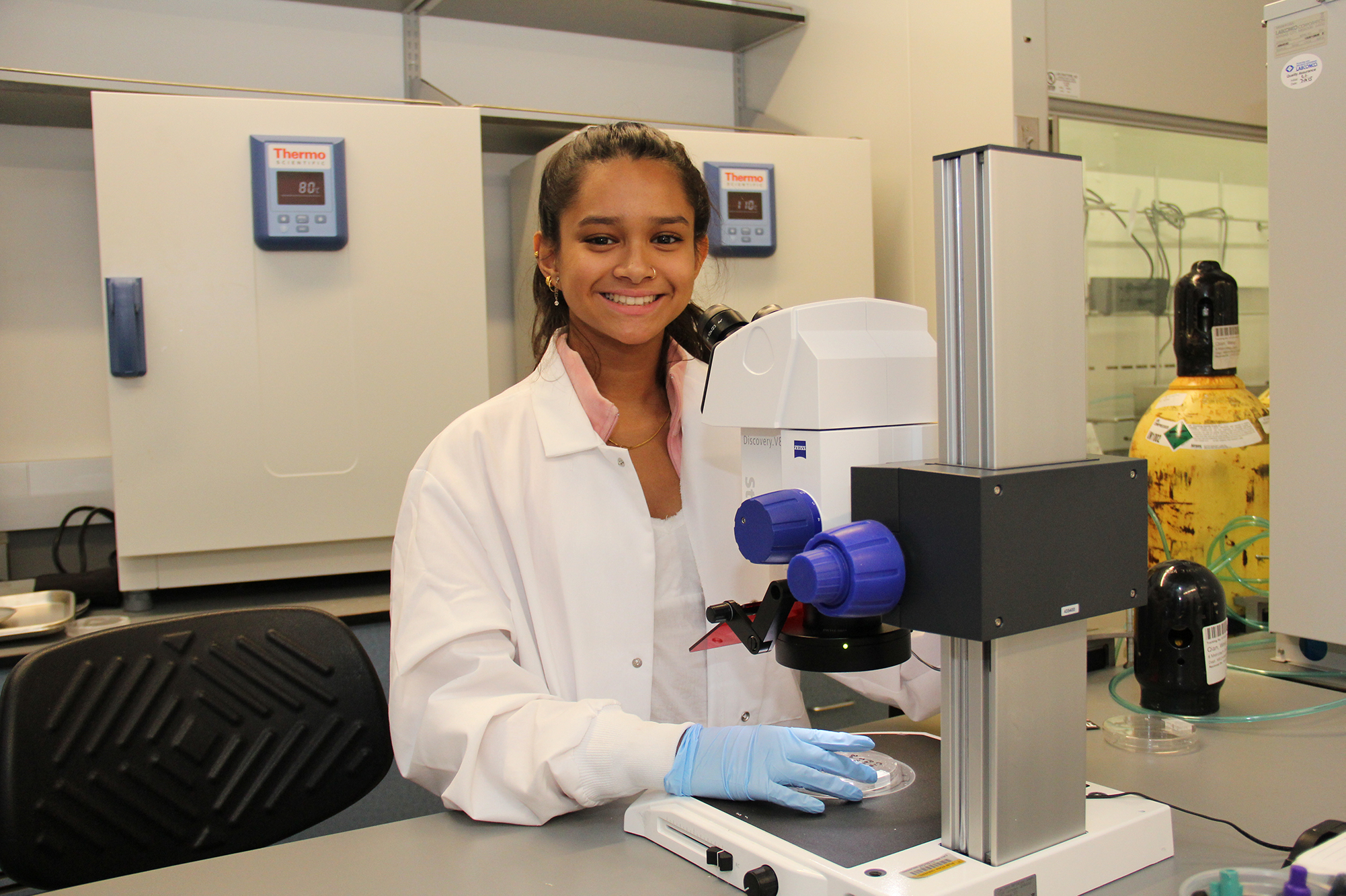
- Lab: Applied Micro-Bioengineering Lab
- Faculty: Weiqiang Chen
- Mentor: Renee-Tyler, Tan Morales
Abstract:
Glioblastoma Multiforme (GBM) is an aggressive, refractory brain tumor, characterized by abnormal angiogenesis and potent immunosuppression. Like other solid tumors, angiogenesis, the formation of new blood vessels from pre-existing blood vessels, is a survival mechanism for GBM growth. In addition, GBM engages continuously with infiltrating immune cells, which can disturb drug efficacy of anti-angiogenic therapy. The connection between immunosuppression and tumor angiogenesis points to combinatorial immunotherapy and anti-angiogenic therapy. However, there is currently no reliable methodology to screen the effectiveness of these therapies. Therefore, we have engineered a biomimetic 3D vascularized GBM tumor microenvironment platform, integrating all the heterogeneous cell-cell interactions, controllable cell-matrix interactions (like promoting cell-ECM adhesion), tunable matrix properties (like altering ECM stiffness) to screen our proposed drugs.
Annie Rozenblyum
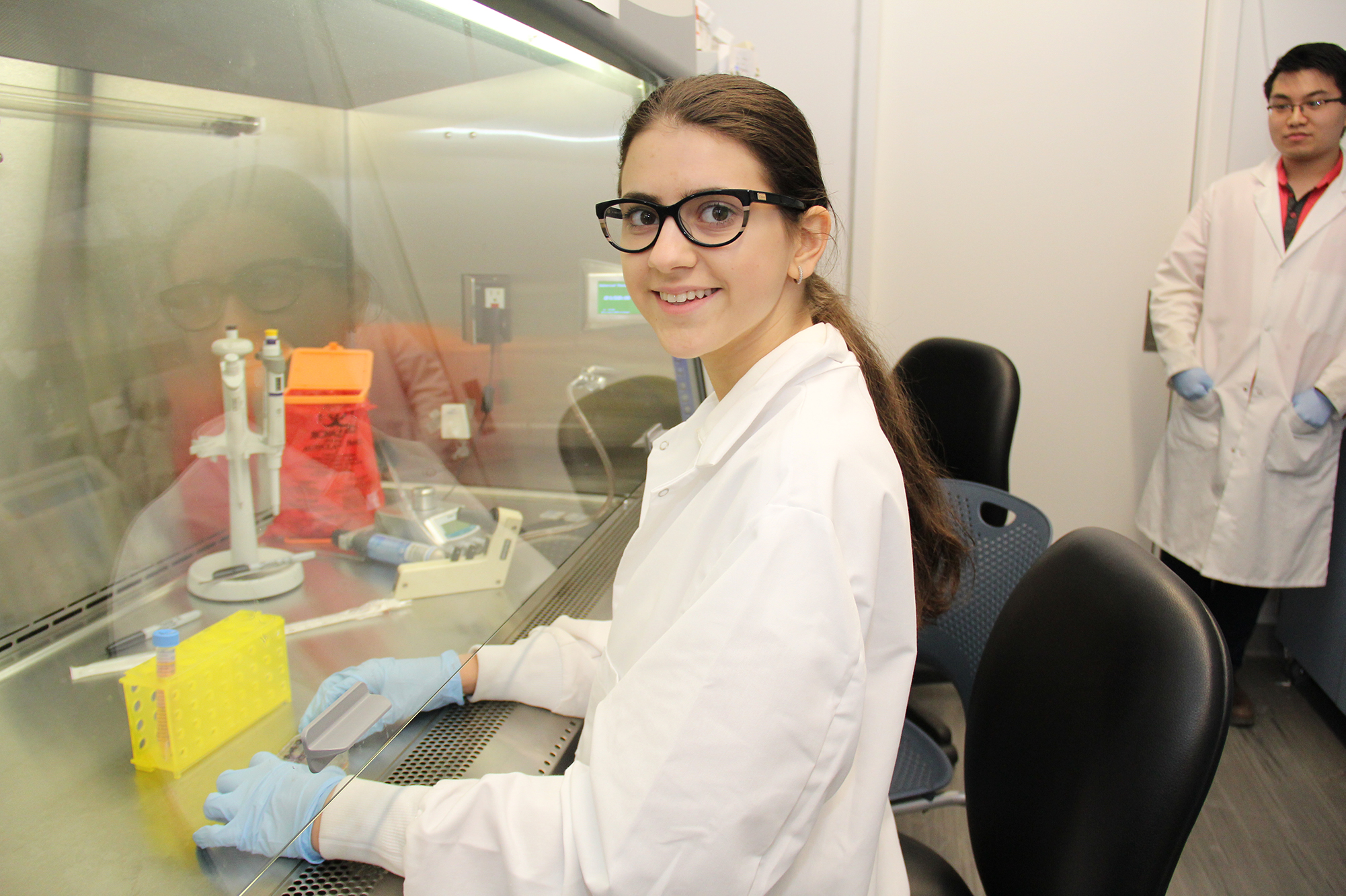
- Lab: Applied Micro-Bioengineering Lab
- Faculty: Prof. Weiqiang Chen
- Mentors: Weiyi Qian
Abstract:
Inflammatory breast cancer (IBC) is the most aggressive and lethal form of breast cancer. Advances in the adjuvant treatment of breast cancer have not had a favorable effect on IBC patient survival rates because the underlying mechanisms which allow IBC to be so aggressively metastatic are still under study. Evidence indicates that cancer cells with stem cell-like properties, termed ‘cancer stem cells’ (CSCs), play a major role in the aggression of IBC. In vivo, CSCs reside in a distinct microenvironment, the “CSC niche”, in which a diverse array of mechanical/biophysical environmental factors contributes to the overall control of CSC phenotypes. Hence, this research examines how the distinct adaptive biomechanical attributes of IBC-CSCs, the so-called “mechanophenotype”, such as cell stiffness, actin cytoskeleton (CSK) structure, and force contribute to the CSCs’ tendencies toward tumorigeneses and metastases. Furthermore, our proposed research will specifically explore the role of the mechanotransductive regulatory networks involving Rho GTPase, actomyosin CSK and nuclear Hippo/YAP signaling in regulating the IBC to CSC. Understanding the unique role of the CSC mechanophenotype in IBC progression will enable the engineering of novel mechano-regulation platforms that would encode specific biomechanical cues to control IBC’s stiffness, morphology, actomyosin CSK structures, and tensions. This added control will, in turn, modulate IBC’s aggressiveness via its CSC subpopulation. Such a research is urgently needed for future therapeutic approaches to IBC.
Chemical and Biomolecular Engineering
Ego Wong, Han Teng Li
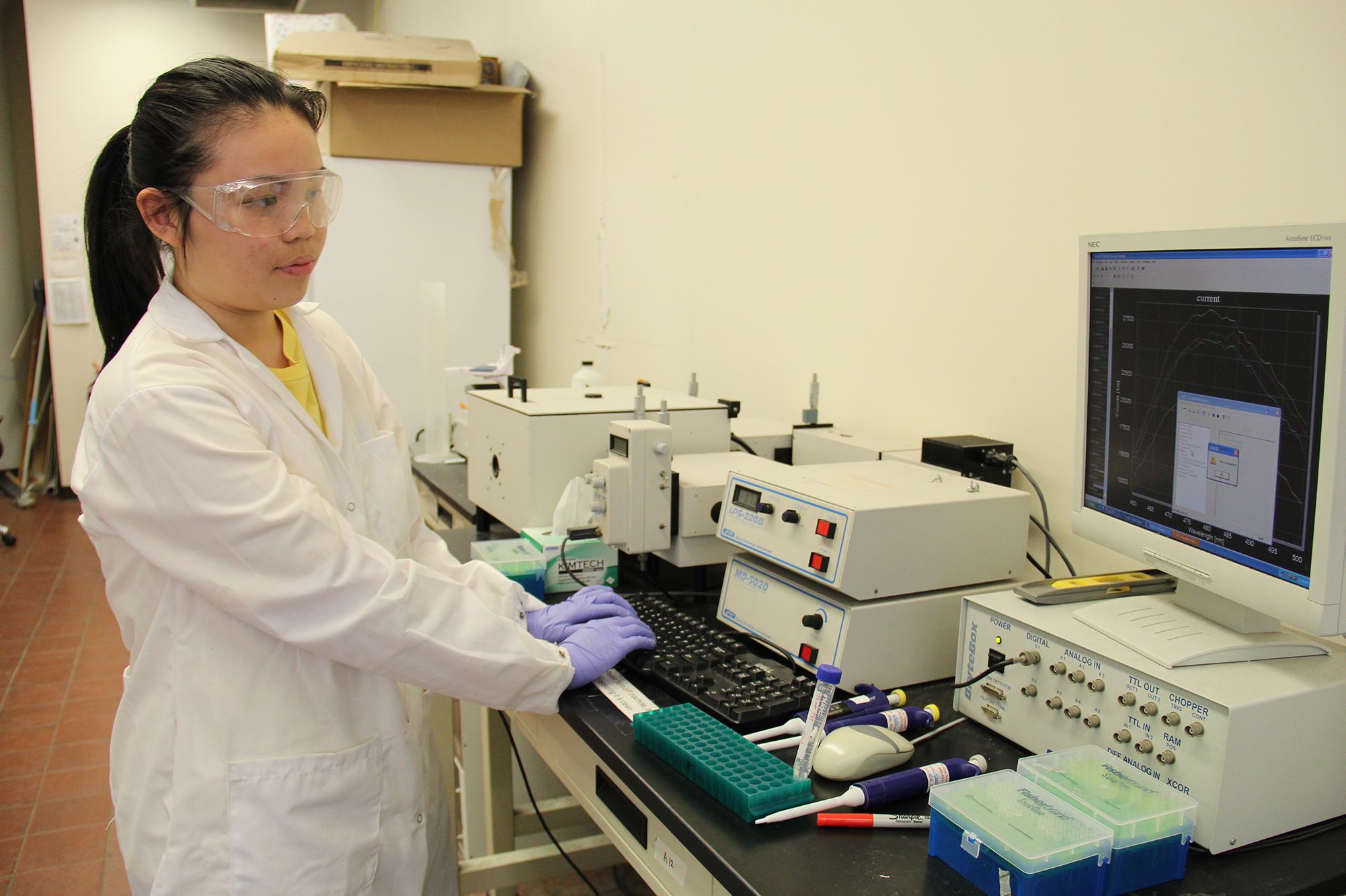
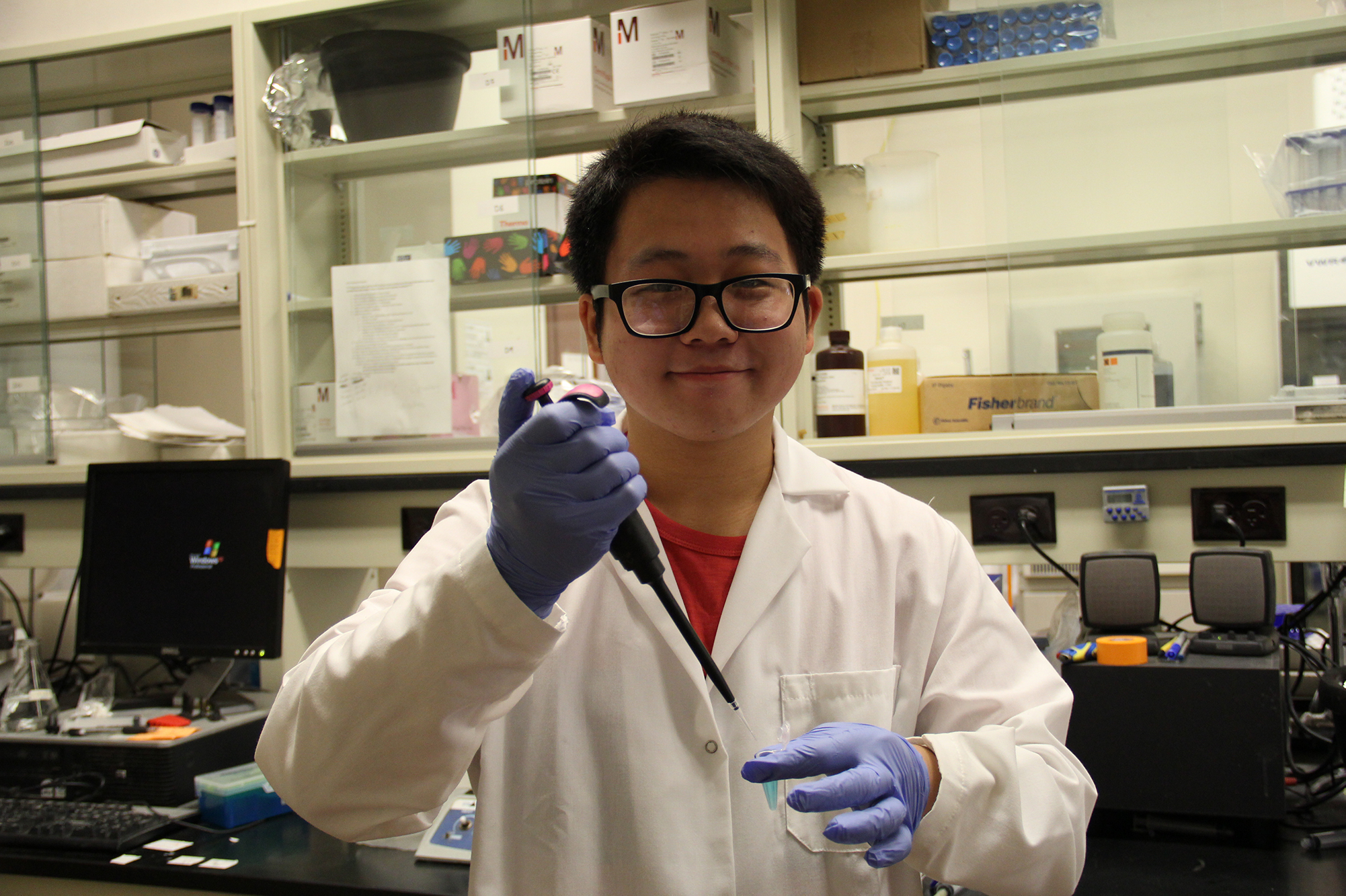
- Lab: Biomolecular Engineering Lab
- Faculty: Jin Ryoun Kim
- Mentor: Jason Candreva, Edward Chau
Abstract:
The mis-folding and aggregation of amyloidogenic proteins have been linked to several neurodegenerative diseases (i.e. Alzheimer’s and Parkinson’s Disease). Amyloids typically follow an aggregation pathway where unstructured monomeric units mis-fold and self-assemble to form neurotoxic oligomeric and fibrillar structures. We are investigating chemical compounds which may disrupt and modulate these amyloidogenic aggregation pathways. Results from the study can contribute towards uncovering the mechanisms behind amyloid protein aggregation, leading to possible therapeutic treatments and the discovery of new diagnostic tools.
Xue Ye Lin, Jason Mei

- Lab: Multifunctional Material Systems Lab
- Faculty: Prof. Miguel Modestino
- Mentor: Adlai Katzenberg, Daniela Blanco
Abstract:
Nylon is one of the most prevalent textiles used in the world. Its uses range from the clothing to kitchen cookware. However, the production of nylon requires an immense amount of energy obtained from fossil fuels, and thus, harmful to the environment. The project involves the modification of solar cells in order to obtain the necessary energy for the chemical reaction that produces a component of nylon to take place. To achieve maximum efficiency, clean cuts of the solar cells are crucial because they allow for the most surface area per cut. Each solar cell is then placed in a combination of series and parallel circuits in order to provide the necessary voltage and current for the desired chemical reaction
Lamiha Rahman
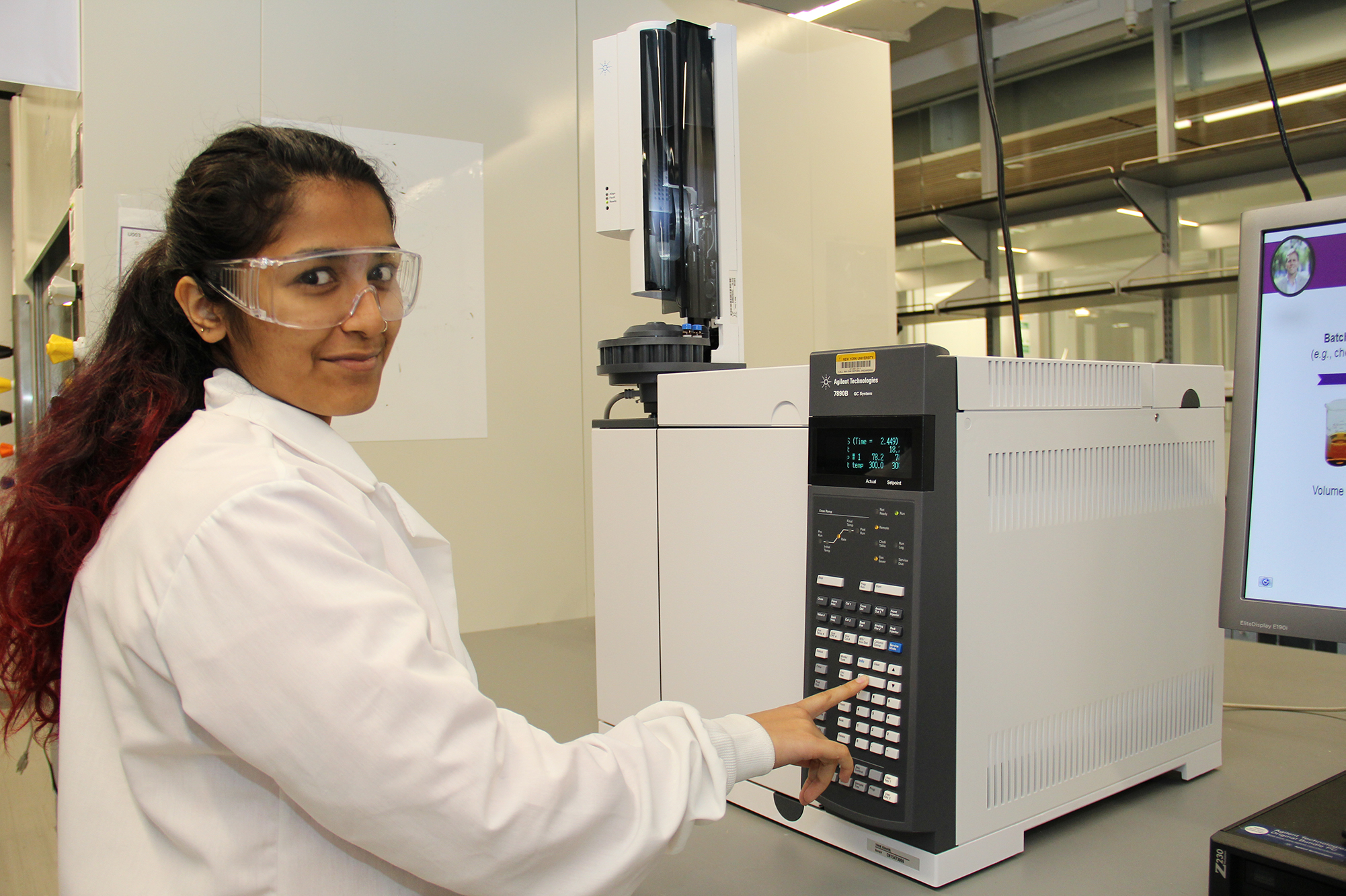
- Lab: Flow Chemistry
- Faculty: Prof. Ryan Hartman
- Mentor: Tianyi Hua
Abstract:
DNA origamis are nanoparticles of DNA self-assembly structures. DNA origamis of varying size and complexity are constructed and studied in literature. This new approach of building nanostructures of various functional properties exhibits a wealth of promising applications. The unique selectivity of DNA base pairs is the key to the robustness and accuracy of this process. This project investigates the DNA origami structure with the help of computer-aided design and drafting software as well as 3D printing technology. 3D printed DNA origami brings us a new site of view to study this fine structure, leading to a better understanding of the DNA folding mechanism.
Juan Prieto, Divya Shah
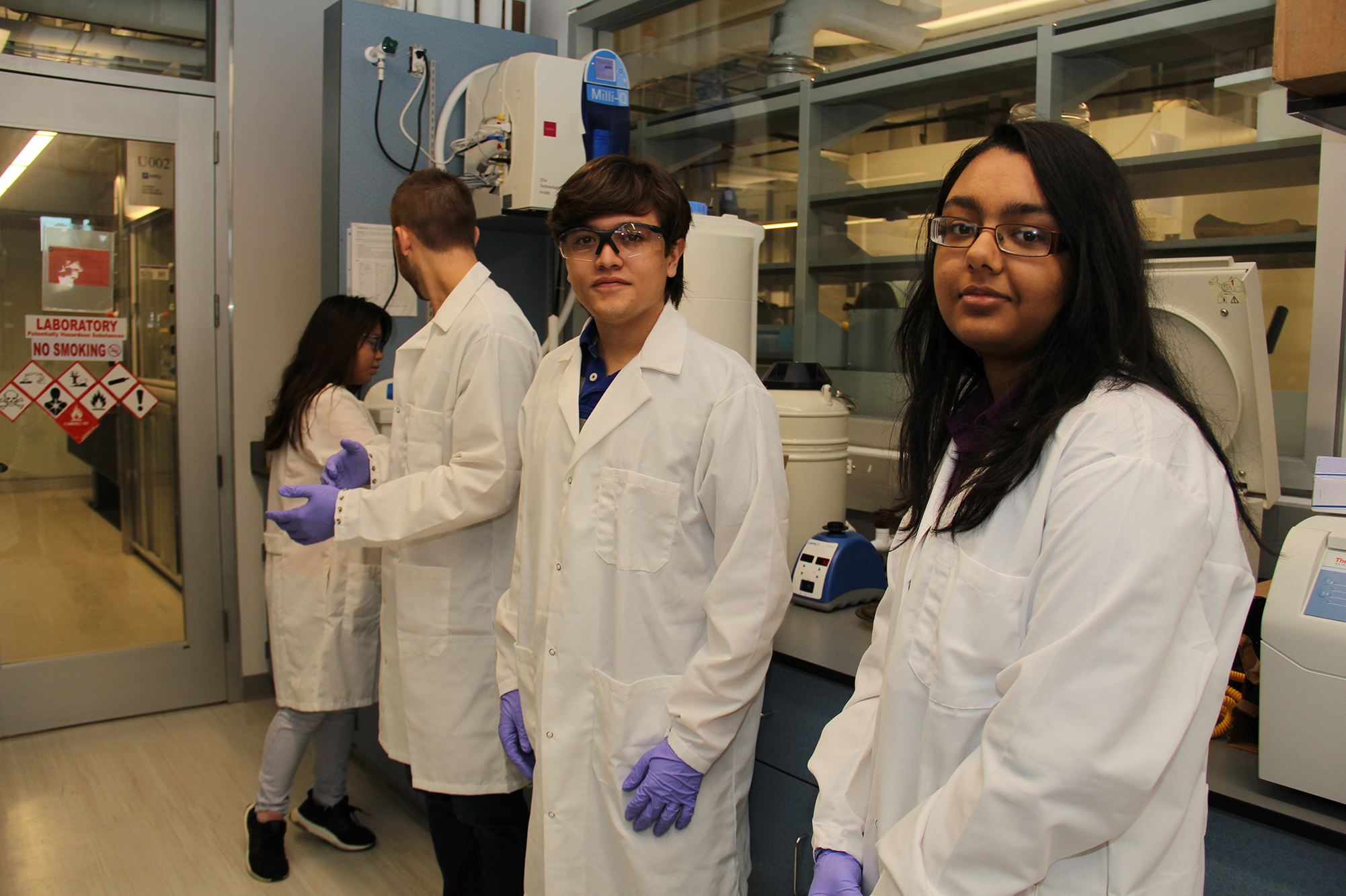
- Lab: Nanostructured Hybrid Materials
- Faculty: Dr. Ayaskanta Sahu
- Mentor: Ingrid J. Paredes, Michael Scimeca
Abstract:
Sustainable energy is one of the most pressing issues that society faces today. With traditional materials reaching their performance limits, the development of new materials will lead us to meet the global demand for energy in a clean and sustainable fashion. Hybrid materials are an emerging class of compounds that combine inorganic and organic components to produce materials with performance greater than the sum of their parts. Our lab seeks to gain fundamental understanding of the electronic and thermal properties of these hybrid systems. We will do this via the synthesis and characterization of hybrid materials, looking at the effect of composition, size, and shape on thermal and electronic properties. Once reliable methodologies for synthesis have been developed, we will implement our materials into devices including light emitting diodes, solar cells, and thermoelectric coolers.
Tonni Sherard
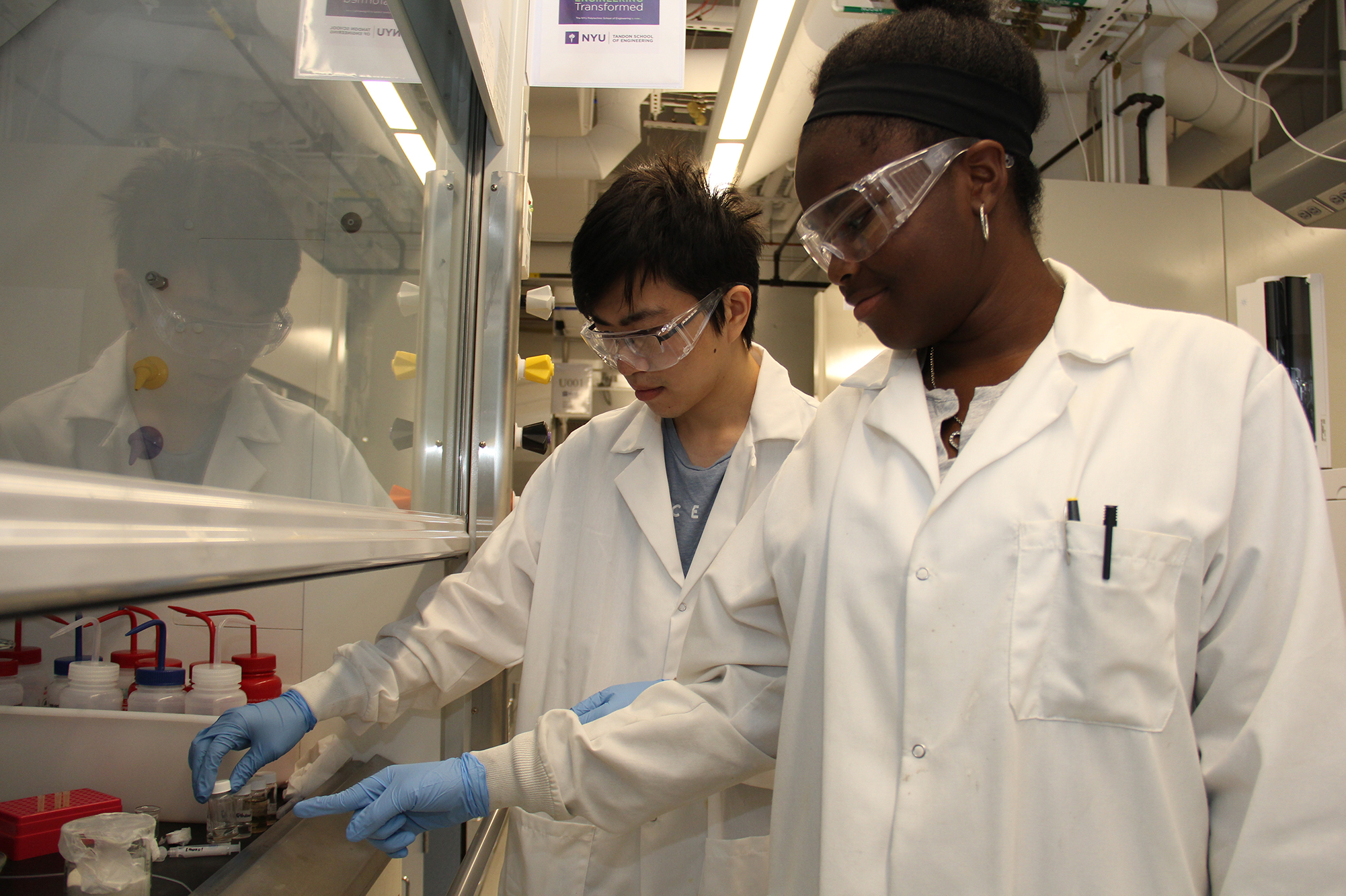
- Lab: Flow Chemistry with Microsystems Laboratory
- Faculty: Prof .Ryan Hartman
- Mentor: Tianyi Hua
Abstract:
Flow reactors, especially microreactors, surpass traditional batch systems, for example a flask, due to its advantage of fast kinetics information acquisition and precise control over the reaction condition. However, the fast heat transfer property of a flow reactor also makes it difficult establishing a temperature gradient across the reactor. Temperature annealing technique is widely used in chemical synthesis, especially important for the synthesis of nanoparticles. This project focuses on the designing and modeling of a flow reactor which is capable of changing temperature gradually, which will make temperature annealing process accessible in a flow reactor. Fast fabrication of the reactor using 3D printing technology will significantly reduce the testing cycle. The result of this project will broaden the horizon of the flow reactor application.
Arpita Nag, Duha Syaar


- Lab: Bio Inferfacial Engineering and Diagnostics Group
- Faculty: Prof. Rastislav Levicky
- Mentor: Eshan Treasurer
Abstract:
Synthetic nucleic acid mimics provide opportunity for redesigning the specificity and affinity of hybridization with natural DNA or RNA. Such redesign is of great interest for diagnostic applications where it can enhance the desired signal against a background of competing interactions. The current project intends to study the thermodynamics of RNA binding with morpholino, an uncharged nucleic acid mimic, in order to determine if it can be described by a two-state process. The study aids the further determination of thermodynamic characteristics of the system which can lead to more convenient and predictive models for RNA-morpholino hybridization.
Radhika Goyal, Kilala Vincent

- Lab: Protein Engineering & Molecular Design
- Faculty: Prof. Jin Montclare
- Mentor: Andrew Olsen
Abstract:
Organophosphates (OPs) are a class of compounds that comprise many commercial pesticides and military-grade nerve gas agents. OPs inactivate acetylcholinesterase, an enzyme in the nervous system, by binding to their active sites, which leads to accumulation of acetylcholine and subsequent hyper-stimulation of nerve synapses. It has been demonstrated that phosphotriesterase (PTE) enzymes are capable of neutralizing these chemicals. In this project we will synthesize and characterize new PTE enzymes that can protect human bodies and the environment from OPs.
Civil and Urban Engineering
Connie Tsang, Jason Cheung
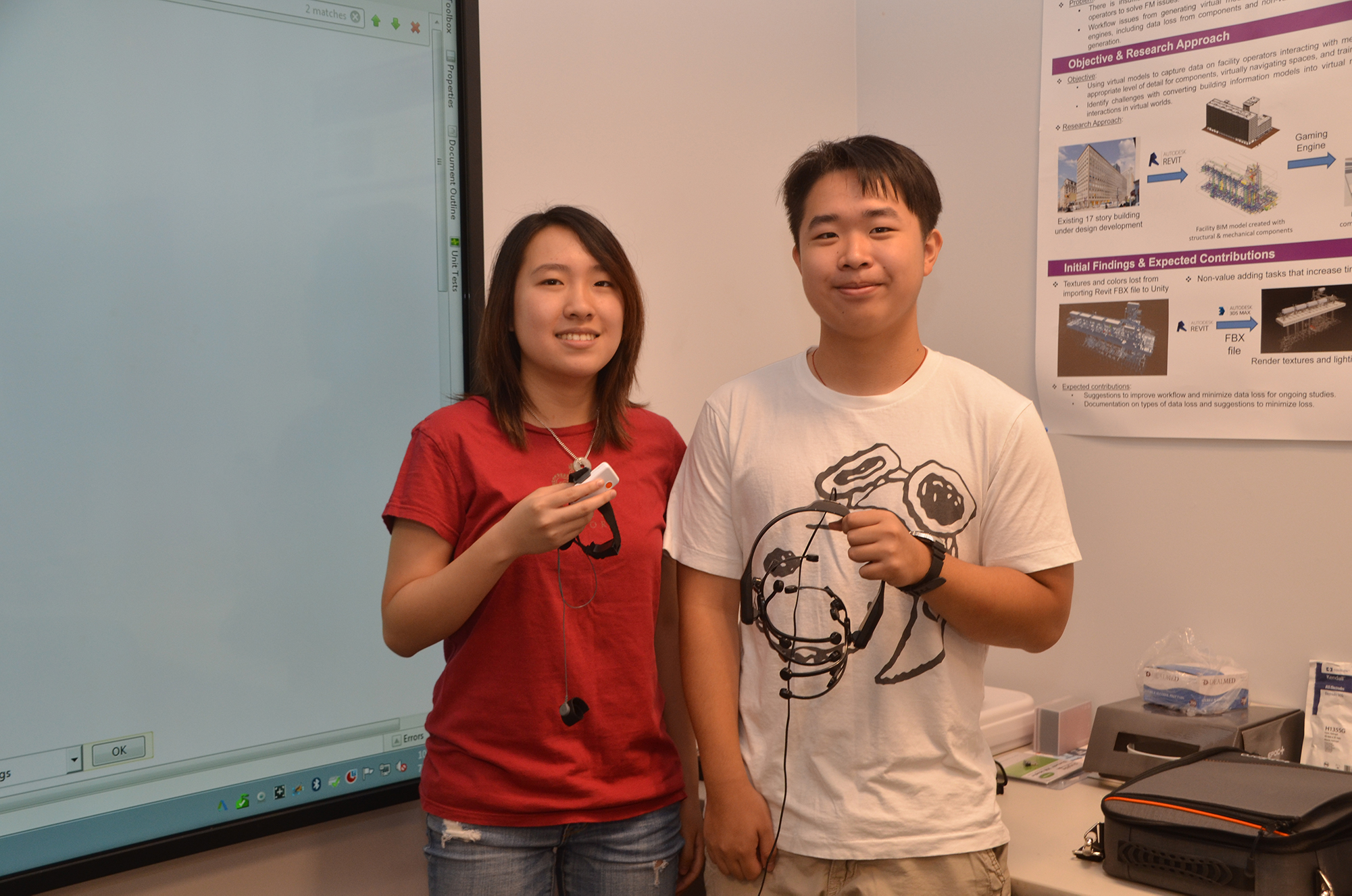
- Lab: Future Building Informatics and Visualization Lab (biLAB)
- Faculty: Prof. Semiha Ergan
- Mentors: Ahmed Radwan, Zhengbo Zhu
Abstract:
Effects of the indoor environment on neuroscience has been known but not well understood. Previous works investigating the effects of the indoor environment on neuroscience has found a correlation between architectural design features and human responses. However, these studies have primarily been conducted via subjective surveys. Quantifying these responses can lead to improved design of indoor environments that maximize human performance and wellness. Conclusions from previous research allowed the identification of four main sensations and their corresponding architectural features. Sensations with influence on psychological states are restorativeness, sense of stress and anxiety, sense of aesthetics/pleasure, and approach motivation. Respectively, examples of architectural features include the presence of windows, lighting level, symmetry of objects, and interior color coding. The goal of this research is to objectively determine the effects of design features on these sensations. Two contrasting models have been designed for each sensation to contain either all positive or all negative features. Body area sensor networks were developed to capture physical changes in subjects that reflect the tested sensation. Electroencephalogram headsets (EEGs), electrocardiograms (ECGs), electromyography units (EMGs), facial expression emotion recognition technology, and eye tracking technology are used to quantitatively measure conditions such as skin conductivity, rapid eye movement, and blood pressure. Human subjects are introduced to the virtual environments for a sensation in a random order and instructed to complete tasks in both positive and negative environments. The measured data between the positive and negative environments are then compared to understand the effects from the architectural features.
Fiedlis Izekor, Marko Henien
- Lab: Soil Mechanics
- Faculty: Prof. Magued Iskander
- Mentors: Abdelaziz, Linzhu Li
Abstract:
Existing piles require an unsustainable increment in size to support the loads imposed by of present day structures. New piles called smart Thriving Friction by Extruding Gear (TFEG) can curb the size required using fins attached to the ends of the piles. They are installed using a unique technique; first, they are driven into the ground like regular piles, however unlike modern piles hydraulic fluid is sent through the smart TFEG. The hydraulic fluid forces the fins out and locks the pile into place. The fins are believed to increase the capacity of the piles. The purpose of this study is to investigate how the fins function and locate the ideal arrangement of fins. The soil used in this project is transparent soil formed by using mineral oil having a refractive index matched with the fused quartz refractive index. The mineral oil is a blend 68% puretol-7 and 32% Krystol-50 to reach to require refractive index, which equal to 1.4585. The fused quartz dispersing into the oil from a small distance of approximately 25 mm to decrease the air bubbles within the sample. Prior studies demonstrate that the transparent soil is very similar to the soil the piles would be inserted in. However, unlike to regular soil it is not opaque and we can in this manner watch the piles behavior once implanted in the transparent soil. As a pullout force is applied, to reproduce this present reality stresses, we will observe the diverse piles reactions. Image of soil movements as the pile movement will captured. After a computer analysis, we will better have the capacity to measure the conduct of the smart TFEG. We will likewise have decided the best pile in opposing the upward force. With this data, the smart TFEG innovation could be completely used in the development of new and potentially existing structures.
Harpreet Kaur
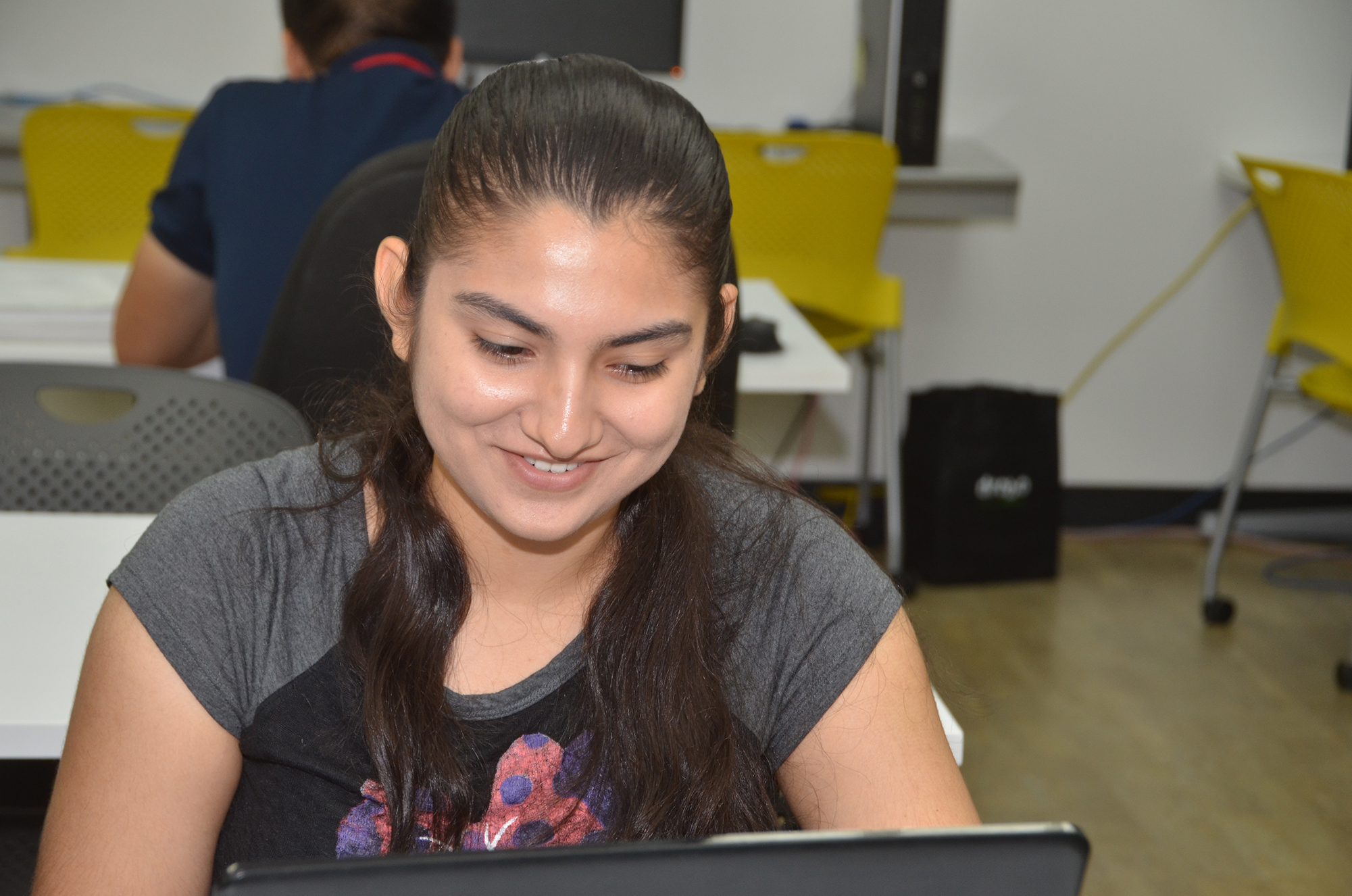
- Lab: Center for Urban Intelligent Transportation Systems Lab (CUITS)
- Faculty: Joseph Chow
- Mentor: Susan Jia Xu
Abstract:
Although New York is filled with myriad means of transportation including the MTA, Uber, Lyft, and Yellow Cabs, the use of the Citi Bike is rapidly increasing as a more efficient alternative. However, with the ever growing use of shared bikes comes the problem of rebalancing to provide customers bikes at all stations. For example, the bike station on 8th avenue and west 31st street always faces lack of bikes. To improve their services, the Citi Bike has added a Valet Service program on 12 of the most problematic stations in their system. As the Citi Bike wishes to expand and have 12,000 bikes by the end of 2017, it is crucial to investigate the factors responsible for those 12 stations being problematic so that future stations won’t have the same issues. A study of the relationship of fares, bike lanes, and accessibility to surrounding MTA services will be designed to explore the cause of the high population and demand of bikes in the 12 stations. Through research and analysis, the Citi Bike’s current methodology will be investigated to see if it will prove to be a successful rebalancing solution.
Alexander Leon
- Lab: CUITS Center for Urban Intelligent Transportation Systems
- Faculty: Prof. Joseph Chow
- Mentors: Diego Estuardo Correa, Gisselle Diana Barrera
Abstract:
This study aims to investigate the impact of the emerging app-based for-hire vehicles on the taxi industry through quantitative analyses of Uber and taxi demands in New York City (NYC), investigating trends among one of the largest transportation systems in the world. Though there are new modes of transportation, taxis, managed by the NYC Taxi & Limousine Commission (TLC), remain a critical player for commuters to get around the city. With the rapid growth of app-based car services like Uber and Lyft, the for-hire vehicle industry is changing dramatically. This research will aim to address some interesting questions like what motivates people to use certain modes of transportation over others, what factors impact the decision to use ride-sharing. Additional analyses include if Uber is being used for first-mile/last-mile problems in the outer boroughs or if pickups/drop-offs are clustered near subway stations?
Computer Science and Engineering
Tyrone Davis

- Lab: OSIRIS Offensive Security, Incident Response and Internet Security
- Faculty: Prof .Nasir Memon
- Mentor: Toan Nguyen
Abstract:
Traditional authentication methods such as typing text passwords are problematic on smartphones due to their small screen and the lack of a physical keyboard. In this work, we will develop new, secure and convenient user authentication methods for smartphones. Our approach is to authenticate users based on their behavioral biometric models built from rich sensor data on smartphones. We will conduct user studies to evaluate the security, reliability and usability of our proposed methods.
Ashley Diaz
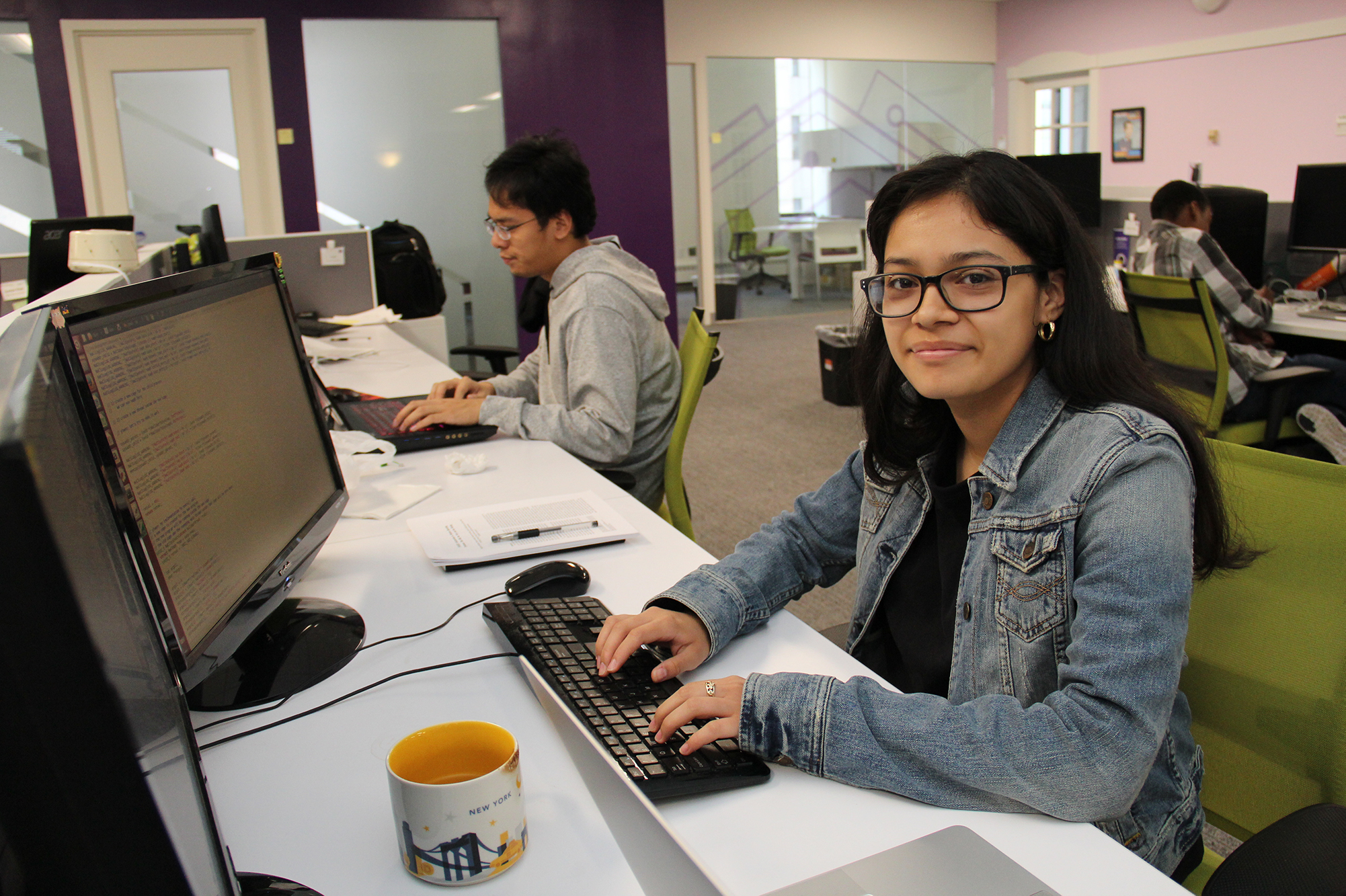
- Lab: OSIRIS Offensive Security, Incident Response and Internet Security
- Faculty: Prof. Nasir Memon
- Mentor: Kevin Gallagher
Abstract:
The introduction of mobile computers has revolutionized the availability of evidence in investigations. The prevalence of smart devices with digital cameras has granted the average citizen the ability to capture evidence of important events, such as criminal activity or police misconduct, with the click of a button, benefiting police, journalists, and other investigators. In this project, we begin the development of the eWitness evidence capture application, an application for android phones that allows individuals to take authenticated photographs. That is, each photograph taken by the eWitness application cannot be edited without being detection, making it tamper evident. In addition, photos taken by the eWitness application will have their spatio-temporal aspects attested for. In other words, the date and location that a photo was taken cannot be forged by an adversary.
Electrical and Computer Engineering
Nana Bonsu
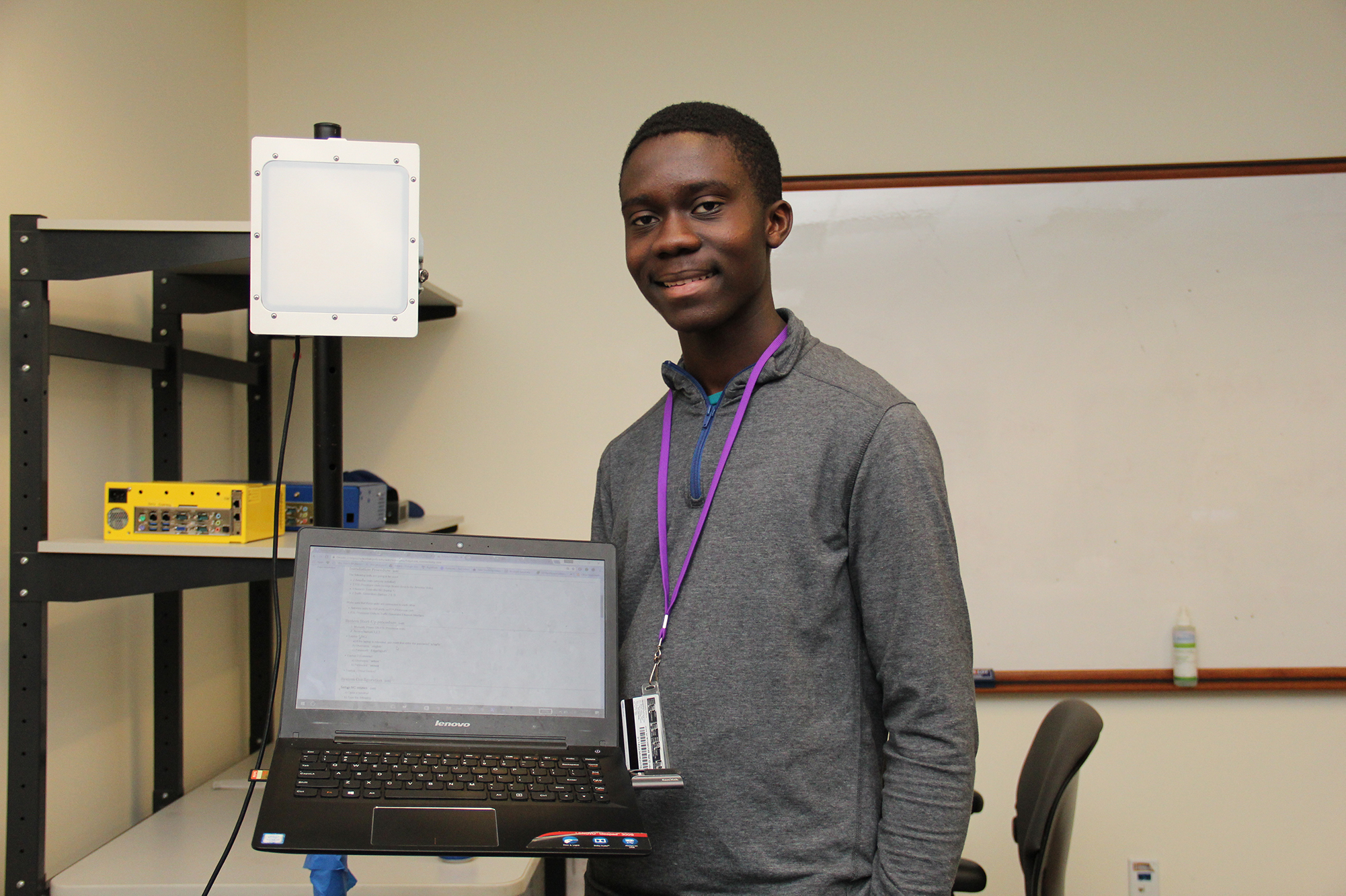
- Lab: (CATT) Center for Advanced Technology in Telecommunications & Distributed Information Systems
- Faculty: Prof. Shivendra Panwar
- Mentor: Fraida Fund, Thanos Koutsaftis
Abstract:
Wireless networks have transformed the way we interact with technology, and applications that rely on wireless connectivity permeate every aspect of life. However, as the next generation of wireless networks is still under development, novel applications that take advantage of their new features aren’t being developed, since the network infrastructure to support them is not yet widely available. In this project, we implement an application that runs on and takes advantage of the capabilities of 802.11ad, a future iteration of WiFi operating at 60 GHz frequencies and with much higher data rates and lower latency than current networks. It is our belief that this will encourage further development of applications that use advanced network technologies.
Ariadna Paltis, Naomi Horsford
Lab: MARL Music and Audio Research Lab
Faculty: Prof. Juan Pablo Bello
Mentors: Charles Mydlarz, Mark Cartwright
Abstract:
Noise pollution is a major issue for urban residents since 90% of them are exposed to excessive noise levels that exceed Environmental Protection Agencies (EPA) guidelines. Therefore, the Music Audio Research Lab (MARL) has endeavored upon this huge urban noise monitoring initiative. MARL is attacking this issue through The Sounds of New York City or SONYC Project that includes the development and deployment of advanced, low cost acoustic sensors and web apps to connect to citizens in order to aid the identification of sounds throughout the New York City area. In terms of the the great amount of processing power these advanced sensors, this sets SONYC apart from other solutions. In terms of these sensors being cost effective, the lost cost of each sensor makes the network scalable to large developments. These sensors will soon be equipped to identify and report the types of sounds heard in their environment. This data is then processed through a cyber-infrastructure that can aggregate and visualize the information gathered. Data visualization helps scientists and key city agencies such as the Department of Environmental Protection (DEP) to determine the best pathway to tackling the noise pollution dilemma in New York. By identifying locations that produce the most noise, city officials and other private corporations would instate regulations to minimize the amount of noise and the effects of it. In the near future the hope of living a more peaceful life in the city could become a reality.
Jazmin Zamora
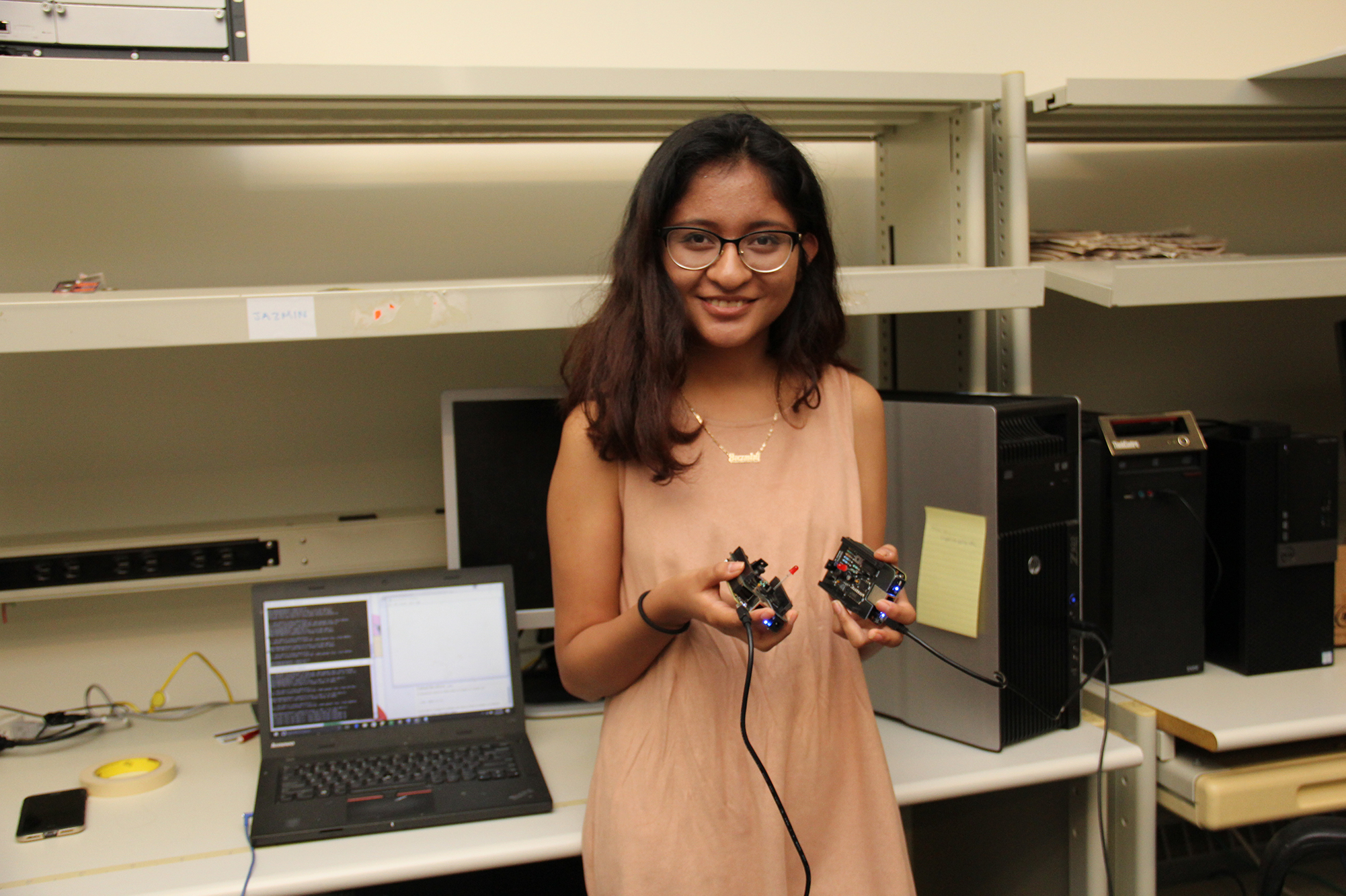
- Lab: (CATT) Center for Advanced Technology in Telecommunications & Distributed Information Systems
- Faculty: Shivendra Panwar
- Mentor: Fraida Fund, Thanos Koutsaftis
Abstract:
Visible light communication (VLC) is an emerging wireless communication technology that transmits data using any device that produces lights, including light bulbs, small LEDs, or smartphone screens. However, while there is a lot of research being conducted involving VLC, researchers don’t have widespread access to a common VLC platform (e.g. a standard device, or a shared facility for conducting experiments). In this project, we integrate VLC devices into an open-access wireless research testbed. We hope that with access to this open facility for VLC experiments, researchers will be able to conduct VLC experiments more easily, reproduce published results and draw direct comparisons with new results, and build on other researchers’ work.
Mechanical and Aerospace Engineering
Sam Forman
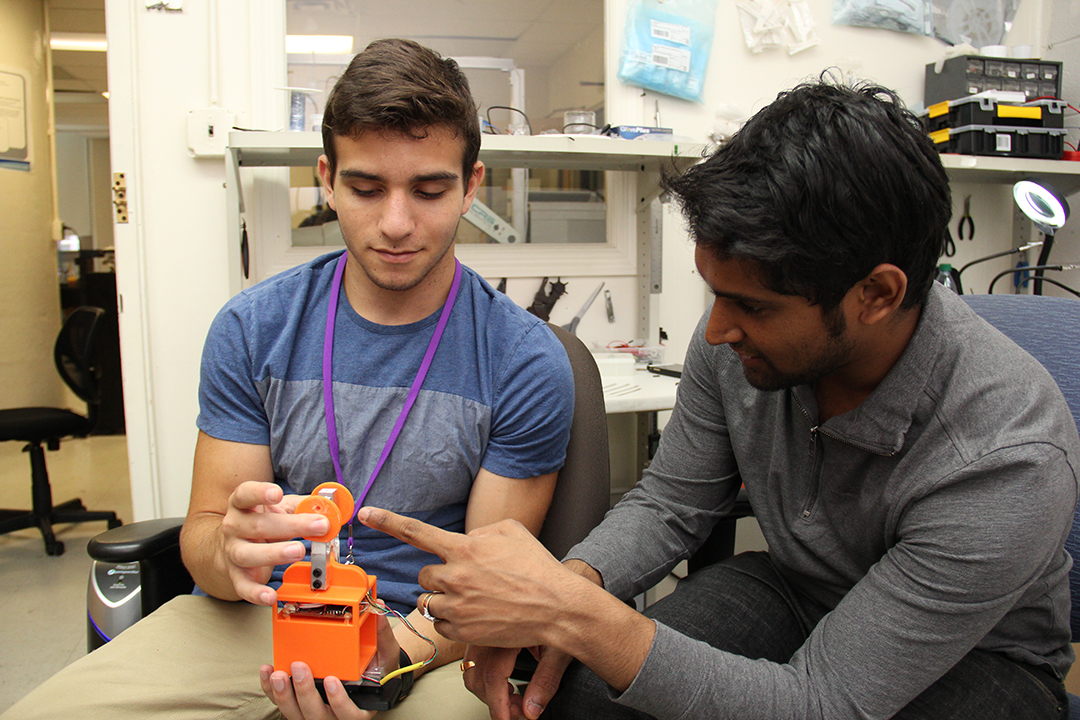
- Lab: Mechatronics lab
- Faculty: Prof. Vikram Kapila
- Mentor: Ashwin Rhashkumae
Abstract:
Strokes are the leading cause of adult disability worldwide affecting over 800,000 individuals a year in the US. Even though recent trends have shown a decline in the number of deaths, there has been an alarming increase in the number of young stroke patients. These patients often suffer from hemiparesis, which is characterized by weakness of the affected hand, making activities of daily living (ADL) exceedingly difficult. Rehabilitation is necessary to prevent chronic effects of hemiparesis. Current practices include physiotherapists performing physical and occupational therapy where the therapist manually guides the patient’s hand motion to increase mobility. While it is effective, the high costs and time consuming nature discourages patient’s involvement and prevents complete recovery. We are developing a novel, low-cost, and portable hand rehab technology, which enables patients to practice therapy at home to facilitate complete recovery. This work will document the design, prototyping, and usability study of the hand rehabilitation device.
Alexandra Shea Formanes
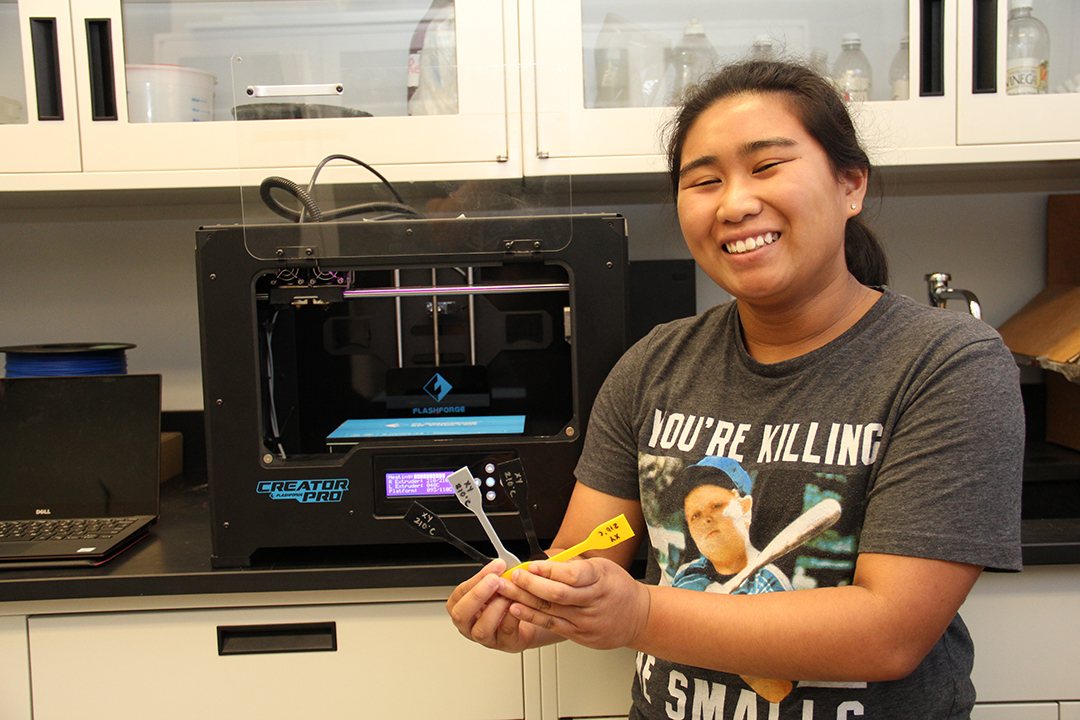
- Lab: Composite Materials and Mechanics Lab (CMML)
- Faculty: Nikhil Gupta
- Mentor: Fei Chen
Abstract:
3D printing produces physical objects from digital files and has been favored by many industries from aerospace, architecture, and automotive to biomedical and dental for advantages such as low tooling or assembly costs, and high customization as well as geometrical complexity. In this project, we will use FDM (Fused Deposition modelling) which is one of the widely used 3D printing technologies to fabricate 3D physical objects from CAD models. The project will include learning the principal of 3D modeling, toolpath generation software, 3D printing prototypes and product quality assessment. Specifically, the CAD models designed with predetermined feature will be processed and printed under different angles and extrusion temperature in a 3D printer to understand how processing parameters affect printed parts quality with the existence of predetermined feature. By collecting these results, the predetermined feature can be selected as a candidate for further complex designs and product security development. In general, the student gains more knowledge about this latest advanced manufacturing technology in this project to understand the limits and capabilities of using 3D printing technology to produce high quality parts.
Richard Guang
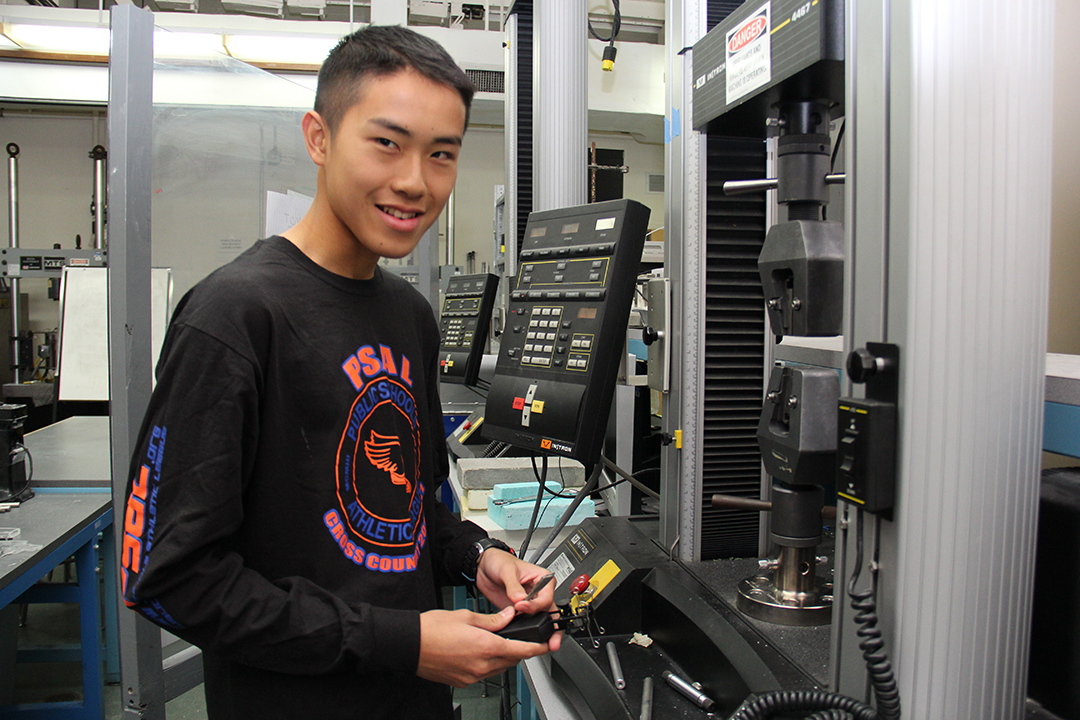
- Lab: Composite Materials and Mechanics Lab (CMML)
- Faculty: Prof. Nikhil Gupta
- Mentors: Ashish Kumar Singh
Abstract:
Light weight syntactic foams are materials with hollow particles dispersed in them. They exhibit high strength to weight ratios and offer weight saving potentials in many applications. Using 3D printing to manufacture parts made out of polymer based syntactic foams instead of the conventional polymers is drawing much attention. But the cost and material recyclability of syntactic foams is no fully understood. In this project, the recyclability of HDPE and fly-ash syntactic foam will be studied by extruding the foam three times through a filament extruder and measuring the breakage of hollow particles.
Lakshta Kundal
Lab: Dynamical Systems Lab
Faculty: Prof. Maurizio Porfiri
Mentors: Tommaso Ruberto, Daniele Neri, Rana El Khoury
Abstract:
In behavioral studies, automated tracking systems increase efficiency and accuracy; however, occlusions may bias the tracking. Occlusions are a phenomenon that occurs when multiple targets are located relatively close to each other such that the software cannot distinguish between the unique identity for each fish. To overcome occlusions, tagging experimental subjects with colorful implants is a viable solution. In this project, we will investigate the impacts of tagging on the social behavior of zebrafish, an important animal model for studying behavior. We propose the development of a uniquely-defined tracking algorithm to calculate the average intensities of each fish to develop a distinct identity for each fish that is tracked, as well as the development of a color-based tracking toolbox, which will therefore maintain their identities throughout the experiments.
Luis Loja
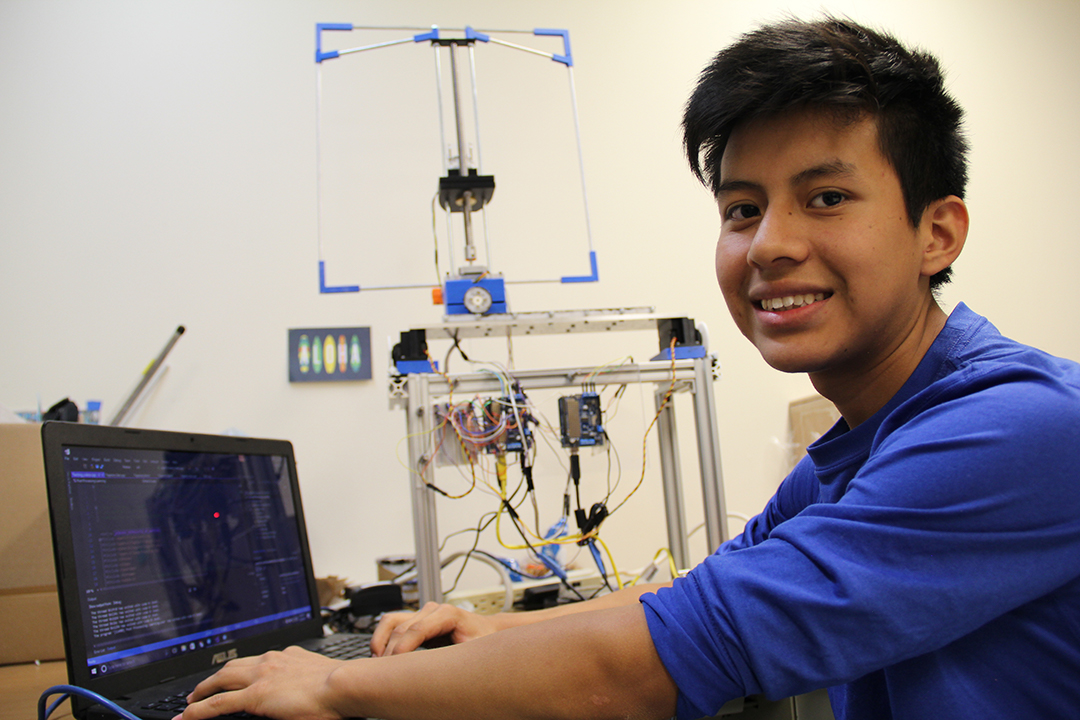
- Lab: Dynamical Systems Lab
- Faculty: Prof. Maurizio Porfiri
- Mentor: Rana El Khoury, Tommaso Ruberto, Daniele Neri
Abstract:
Just as zebrafish are attaining an important role in behavioral neuroscience, they are becoming particularly prominent in the study of fear and anxiety. Here, we will characterize fear-related response in zebrafish using a robotic predator employing a closed-loop control system. Closed-loop systems show promise in simulating a two-way interaction between stimuli and focal subjects. Our robotic platform will allow the actuation in three-dimensional space of a biologically-inspired replica of a red tiger oscar fish, an allopatric predator of the zebrafish. The platform will simulate real-time behavior of the predator in response to the zebrafish during experiments in a water tank.
Ebonie Reavis
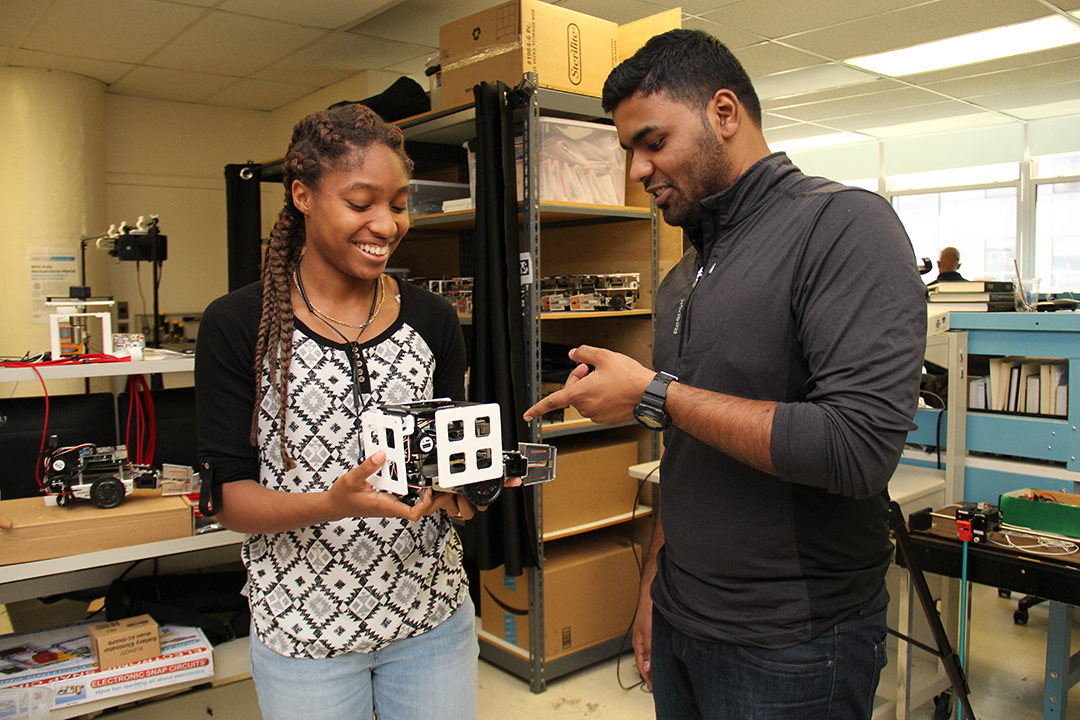
- Lab: Mechatronics lab
- Faculty: Prof. Vikram Kapila
- Mentor: Sai Prasanth Krishnamoorthy, Ashwin Raj Kumar
Abstract:
Traditionally, robots are controlled by one master computer to perform specific task(s). However, communication through a network of linked robots to perform specific tasks collectively is an underdeveloped area of research. This communication between robots can reduce the amount of time that a certain task–such as picking up an item–might take. Linking the robot’s databases could allow the robots to communicate with other robots to perform the tasks without direct communication between the master computer and each of the robots. In this experiment, our goal is to use one code from a master computer to control a network of robots. This will involve robotic interaction so that robots notify each other to efficiently run a task. For example, if one robot is commanded to pick up a soda can 5 ft away from it, it will notify any robots that are closer to the soda can to perform the task. This “teamwork” objective is not only time-saving but a step further to Artificial intelligence.
Rana Mohamed, Caitlin Schroeder
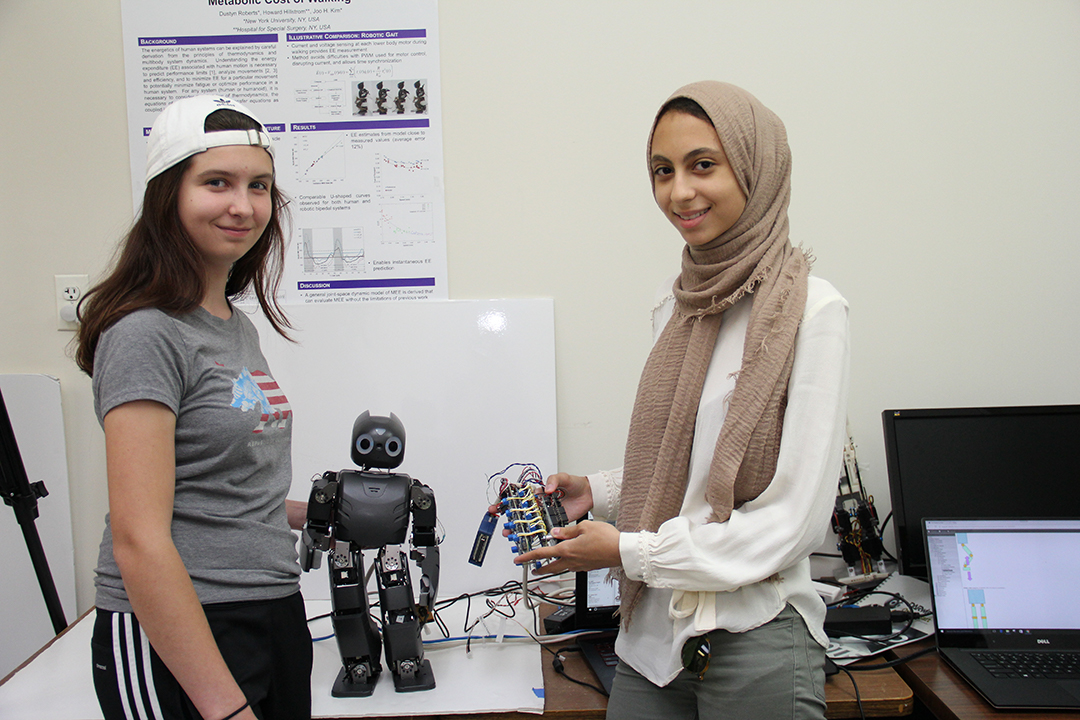
- Lab: Applied Dynamics & Optimization Lab
- Faculty: Prof. Joo H. Kim
- Mentor: William Peng, Carlos Gonzalez
Abstract:
The technology behind robotic systems is advancing each and every day as robotic systems continue to become more popular. However, robots become less useful when batteries are used inefficiently. This issue can be combatted by the implementation of better motion planning, which requires no change in battery design. Our method of motion planning is based on State of Charge (SoC) estimation using real time Kalman Filtering. We will conduct experiments with a two degree of freedom robotic arm and the DARwIn-OP humanoid robot, both powered by rechargeable lithium-ion polymer batteries. Our research involves using arm bending trials with the robotic arm and walking trials with DARwIn-OP. The results of these experiments can lead to more energy efficient design in future exoskeletons, extending their battery life to benefit paraplegics and other users who rely on such devices to restore mobility.
2016
Anthropology
Lillian Fok
- Lab: Hominin Skeletal Morphology Lab
- Faculty: Prof. Scott Williams
- Mentor: Jennifer Eyre
Abstract:
Living hominoids (apes and humans) are adapted to upright posture, reflected in a suite of changes to the thorax, upper limb, lower back, and pelvis that together contribute to a distinct body plan compared to other primates and mammals. The purpose of this project is to revisit the hypothesis that tail loss, arguably the only derived trait shared by all hominoids, occurred to accommodate the evolution of upright posture. To test this hypothesis, we will collect cross-sectional data from 3D laser scans of monkey, ape, and human lumbar vertebrae, which are known to reflect weight transmission in upright posture. Casts of fossil apes that lack tails but are thought to retain primitive, monkey-like body plans (i.e., do not appear to be adapted to upright posture) will also be included and interpreted in light of results of living primates. If the fossil apes are found to share adaptations to upright posture with hominoids to the exclusion of non-hominoid primates, the hypothesis that tail loss and upright posture coevolved will be supported; if they do not, it will be rejected in favor of the alternative hypothesis that tail loss and the evolution of upright posture are not causally related.
Christie Oreste
- Lab: Hominin Skeletal Morphology Lab
- Faculty: Prof. Scott Williams
- Mentor: Jennifer Eyre
Abstract:
Modern humans have a difficult time giving birth because the neonate’s head is as large as the mother’s birth canal. Why hasn’t selection favored a more capacious birth canal to make birth less dangerous? This conundrum is termed the “obstetrical dilemma”. Several hypotheses have been proposed, such as that a wider pelvis increases the cost of locomotion, or that a wider pelvis is antagonistic to effective thermoregulation in hot climates. These hypotheses rely upon the relationship between hip width and dimensions of the birth canal. While it has been shown that hip width corresponds to the transverse dimensions of the birth canal, it is not clear whether narrow hips lead to an overall constricted birth canal and thus a harder time giving birth. This project will test the relationship between hip width (bi-iliac breadth) and the capacity of the birth canal at the inlet, midplane and outlet. Three-dimensional laser scans of pelves from the Point Hope Collection and the Medical Collection at the American Museum of Natural History will be processed and measured to determine if there is a correlation between bi-iliac breadth and birth canal constriction.
Omowunmi Awelewa, Ilana Schachter
- Lab: Molecular Anthropology Lab
- Faculty: Prof. Todd Disotell
- Mentors: Andrew Burrell, Laura Matthews
Abstract:
Every organism sheds DNA into the environment it inhabits. As DNA is a relatively hardy molecule, it persists over time in soil, water, and even the air. This “environmental” DNA, or eDNA, can be extracted from environmental samples and sequenced, allowing us to identify what organisms are present in specific habitats and in what numbers. ARISE students will join the Molecular Anthropology Laboratory at NYU and help us design projects such as using eDNA to track the expansion of invasive species like the emerald ash borer. Students will learn about eDNA, help obtain environmental samples, extract DNA from them, and help analyze the resulting DNA sequence data.
Biology
Doruntina Fida
- Lab: Molecular and Cellular Biology Lab
- Faculty: Prof. Fei Lei
- Mentor: Zhongxuan Chi
Abstract:
It is widely known that errors in centromere formation lead to chromosome mis-segregation and aneuploidy, which further cause genetic disorders and tumorigenesis. The aim of this project is to determine the regulation of centromere formation in S. pombe. Identified by genome-wide screening for CENP-Acnp mis-localization in S. pombe, two mutant strains show significant abnormalities of centromere structures. The methods will include phenotypic characterization of mutant strains by visual screening, phenotypic determination of centromere de-cluster or multiple foci formation and biochemical characterization of novel proteins involved in centromere regulation.
Nina Gu, Anthony Hohn
- Lab: Chromosome Inheritance Lab
- Faculty: Prof. Andreas Hochwagen
- Mentor: Viji Subramanian
Abstract:
Meiosis is a process that enables sexually reproducing organisms to pass their genome (DNA) on to the next generation. Errors in meiosis are a leading cause of infertility, spontaneous fetal loss and birth defects. DNA breakage and repair are integral to proper completion of meiosis and genome integrity. The research aims to discover novel genetic interactions for maintaining genome integrity during meiosis. This research is performed in the single-celled baker’s yeast to take advantage of the fast growth and comparatively simple genome organization of this organism but will provide a better understanding of meiosis in humans.
Camellia Huang
- Lab: Developmental Genomics Lab
- Faculty: Prof. Christine A Rushlow
- Mentor: Nikolai Kirov
Abstract:
Zelda (Zld) is a master transcription factor regulating gene expression during Drosophila embryogenesis. Zld has six zinc finger domains; four zinc fingers are known to be important for DNA binding. Two more zinc fingers have not yet been studied very well. We will test the zinc finger function by using a genetic rescue essay with embryos carrying mutated proteins and test gene expression of several Zld targets to determine whether those fingers are required for proper function of Zld in early embryogenesis.
Jamie Monroy Rojas
- Lab: Molecular and Cellular Biology Lab
- Faculty: Prof. Fei Lei
- Mentor: Zhongxuan Chi
Abstract:
Proper chromosome segregation is essential to maintain genomic stability and cell viability. The centromere is the point of attachment of the chromosomes to the spindle skeleton during mitosis so it function is fundamental for chromosome segregation. Most of the organisms have monocentric chromosomes i.e. they have a single centromere per chromosome, whereas some species have evolved holocentric chromosomes, so they have multiple points of attachment along their chromosomes. In monocentric chromosomes, the centromere is epigenetically defined by the presence of the histone protein CENP-A. However, little is known about the function and determination of centromeres in species with holocentric chromosomes. The goal of this study is to genetically engineer fission yeast, which has monocentric chromosomes, to express a CENP-A protein coming from an organism with holocentric chromosomes (the nematode C. elegans). This would help us to understand how mono and holo-centromeres are established, the role of CENP-A and the consequences for cell division.
Shukai Zhong, Chrislie Roselin
- Lab: Systems Proteomics Lab
- Faculty: Prof. Christine Vogel
- Mentor: Shuvadeep Maity and Songhee Back
Abstract:
Intracellular organelles, such as mitochondria or the endoplasmic reticulum (ER), have highly dynamic structures and interact with each other in response to intrinsic and extrinsic signals. Thus, they are an integral part of the cellular physiology, and the contact sites between the mitochondrion and the ER is a hub of molecular exchange. If this interaction is perturbed, cellular function is severely affected, which eventually might underlie diseases such as those of the neuronal system. To study the interaction dynamics between the mitochondria and the ER, we will design different fluorescent reporter protein based constructs to visualize the dynamics between the organelles. We will develop the reporter based neuronal cell line to measure the changes in abundance under different conditions.
Julieth Sanchez
- Lab: Developmental Genomics Lab
- Faculty: Prof. Christine A Rushlow
- Mentor: Nikolai Kirov
Abstract:
Zelda (Zld) is an important transcription factors and regulates the expression of hundreds of target genes during embryogenesis. It has been shown that zld is also expressed in the larval stages,especially in the imaginal discs, which will develop into adult structures such as the eyes. zld is specifically expressed in the undifferentiated cells in the eye disc. We will remove zld transcripts in that domain and test several genes that are important for eye disc development. These experiments will determine the function of Zld in the larval stage.
Biomedical Engineering
Lillian Baker
- Lab: Applied Micro-Bioengineering Lab
- Faculty: Prof. Weiqiang Chen
- Mentor: Weiyi Qian
Abstract:
The “mechanophenotype” provides insight into cell’s properties except that from the biochemical properties. It is important to develop an understanding of the biomechanical attributes of cell to their function and response to stimuli. Cell stiffness is one of the most important biomechanical properties of cells that are essential to many mechanisms by which cells sense mechanical stimuli and transduce them into chemical signals that induce corresponding cellular response. To investigate intrinsic mechanosensitive properties of cells, we use a micropost array membrane (mPAM) with adjustable stiffness as substrate to explore cell’s response by culturing them on substrates with different stiffness. A robust computation scheme was developed and implemented for subcellular quantifications of cell stiffness.
Paul Spezza
- Lab: Applied Micro-Bioengineering Lab
- Faculty: Prof .Weiqiang Chen
- Mentor: Xin Cui
Abstract:
Bone is highly vascularized for vital processes such as bone growth and remodeling. An essential process in bone repair is angiogenesis, the sprouting of endothelial cells, such that pre-existing blood vessels extend and invade into their microenvironment to form new blood vessels.To investigate bone repair under angiogenetic conditions, we have designed a bilayer microfluidic platform of 2 parallel 3-D channels in a well, derived from Collagen I rat-tail, to mimic in-vivo bone vasculature and the bone microenvironment. The aim is to elucidate the effects of these biochemical gradients on bone-related angiogenesis of bone repair.
Chemical and Biomolecular Engineering
Nina Chen
- Lab: Protein Engineering and Molecular Design Lab
- Faculty: Prof. Jin Kim Montclare
- Mentor: Andrew Olsen
Abstract:
Organophosphates (OPs) are a class of compounds that comprise many commercial pesticides and military-grade nerve gas agents. OPs inactivate acetylcholinesterase, an enzyme in the nervous system, by binding to their active sites, which leads to accumulation of acetylcholine and subsequent hyper-stimulation of nerve synapses. It has been demonstrated that phosphotriesterase (PTE) enzymes are capable of neutralizing these chemicals. In this project we will synthesize and characterize new PTE enzymes that can protect human bodies and the environment from OPs.
Cassandra Fleurelus
- Lab: Protein Engineering & Molecular Design Lab
- Faculty: Prof. Jin Kim Montclare
- Mentor: Andrew Olsen
Abstract:
Drug resistance in cancer remains a formidable hurdle to successful chemotherapy treatments and can unfortunately result in fatal consequences. Specific genes within the cancer genome are responsible for this drug resistance and therefore these genes have become therapeutic targets. Our research is focused on engineering proteins capable of delivering both short interfering RNA (siRNA) that silence the genes responsible for drug resistance and chemotherapeutic drugs that effectively kill cancer cells. Presently, we are characterizing a library of engineered proteins for their effective siRNA and drug binding ability for eventual testing in cancer cells.
Rahma Ibrahim
- Lab: Biomolecular Engineering Lab
- Faculty: Prof. Jin Ryoun Kim
- Mentor: Jason Candreva
Abstract:
The aggregation of proteins in the brain is the direct cause of many neurodegenerative diseases, such as Alzheimer’s disease. Specifically, the project focuses on modulation of beta-amyloid aggregation, which is implicated in this disease. We look to investigate chemicals that affect the rate of this aggregation. Results from these experiments can uncover mechanisms behind amyloid protein aggregation, leading to possible therapeutic treatments, as well as the discovery of new diagnostic tools.
Waseer Mohamed
- Lab: Flow Chemistry with Microsystems Lab
- Faculty: Prof. Ryan Hartman
- Mentor: Weiqi Chen
Abstract:
In underdeveloped countries, the diagnosis of diseases is difficult due to the lack of medical professionals and efficient ways to obtain samples from the patients. The innovation of new technology that combines mobile networks with diagnosis tools could help to overcome geographic limitations. However, understanding is needed in order to transform how we remotely diagnose patients. This research work, a collaboration with Alexapath, Inc. in the NYU Incubator Program, will help to design and optimize an appropriate way to integrate mobile devices with microscopy. We anticipate the outcomes of this project will help society by controlling epidemic disease via rapid diagnosis.
Janice Wang, Oishee Rahman
- Lab: Biointerfacial Engineering Lab
- Faculty: Prof. Rastislav Levicky
- Mentor: Ursula Koniges
Abstract:
Morpholinos are molecular analogues of deoxyribonucleic acid (DNA). Morpholinos have promising applications in the development of genetic diagnostic tools, such as microarrays and electrochemical assays. Measurement of the concentration of morpholinos is commonly accomplished by determination of the amount of 260 nm light absorbed through a sample. An example of a device designed for such absorbance measurements is the NanoDrop, which requires manual pipetting of sample to device. Transfer of sample to the NanoDrop device can influence concentration measurements through adsorption losses on the pipette tip itself, thus lowering measured concentrations. The 2016 Levicky Lab ARISE students will investigate how pipette tip material and pipetting technique influence concentration measurements of morpholino oligonucleotides using the NanoDrop device.
Allison Lee
- Lab: Biomolecular Engineering Lab
- Faculty: Prof. Jin Ryoun Kim
- Mentor: Edward Chau
Abstract:
An increasing number of neurodegenerative diseases have been linked to the misfolding and aggregation of proteins. Parkinson’s Disease is a neurodegenerative diseases implicated by the aggregation of an amyloid protein known as alpha-synuclein. The project investigates chemical compounds that may modulate the rate of amyloid aggregation. Results from these experiments can uncover mechanisms behind amyloid protein aggregation, leading to possible therapeutic treatments, as well as the discovery of new diagnostic tools.
Civil and Urban Engineering
Malaq Alzoubeir
- Lab: Center for Urban Intelligent Transportation Systems Lab
- Faculty: Prof. Joseph Chow
- Mentor: Susan Jia Xu
Abstract:
In many transit systems around the world (including the NYC MTA), there is no tracking system for the paths that people take. For example, a person entering the Jay St. Metro Tech station and emerging at Times Square could have gone via a number of different paths. As a result, there is problem of real time assessment of ridership levels on different trains in the system at any given time. Some studies have used automated fare payment data from smart cards to infer such information; the London Tube is one example. As the NYC MTA prepares to upgrade its fare payment system to smart cards and mobile devices over the next three years, such an information system will be necessary. A study of the inference methodology and initial proof of concept for NYC MTA will be designed.
Dankevin Ynoa, Christina Deng
- Lab: Soil Mechanics Lab
- Faculty: Prof. Magued Iskander
- Mentor: Matteo Casacci
Abstract:
One of the challenges of experimental work in geotechnical engineering is to accurately simulate subsurface conditions in a controlled environment in the lab. The Geotechnology Research Group at the Department of Civil & Urban Engineering, lead by Dr. Magued Iskander, has designed and constructed a plane strain calibration chamber that can be used to perform pile jacking and driving in order to study and compare the soil particle kinematics during the installation processes. ARISE students will get hands-on experience and learn from all steps involved in this experiment, from sample preparation to post-experiment computational analysis.
Sze Ting Lau
- Lab: Center for Urban Intelligent Transportation Systems Lab
- Faculty: Prof. Joseph Chow
- Mentor: Susan Jia Xu
Abstract:
With increasing urbanization, megaregion growth, and emergence of privately operated transport services like Lyft and Uber, there is increasing need for strategic planning and collaboration between multiple operators and agencies. One recent example is the Uber partnership with the Paratransit service in Boston. Inter-operational strategic planning, however, is hampered by lack of tools to make system operating data easily available to decision-makers across the table. A new geographical information system (GIS) visualization tool will be studied to explore the potential for sharing route information in a privacy-preserving manner.
Computer Science and Engineering
Naomi Ferguson
- Lab: The Offensive Security, Incident Response and Internet Security Lab
- Faculty: Prof. Nasir Memon
- Mentors: Jay Koven , Kevin Gallagher
Abstract:
Finding connections in large communication datasets is a difficult challenge that requires an enormous amount of time and resources. Criminal investigators often have to navigate through hundreds of thousands of emails, text messages, posts and tens of thousands of unique users. In this project, we create a dynamic visual analytic tool to assist in these investigative efforts. The tool will focus on the content of the communications as well as the social network created but the senders and receivers.
Ajani Stewart
- Lab: The Offensive Security, Incident Response and Internet Security Lab
- Faculty: Prof. Nasir Memon
- Mentor: Hossein Siadati
Abstract:
Messaging applications provide point-to-point encryption for users. One of the challenges that users face is the task of comparing the exchanged cryptographic key to make sure that the two parties are using the same key, and no Man-in-the-Middle attack has happened during the key exchange phase. Telegram uses a visualization of the encryption key to make the work of comparison easier for users. However, it turned out that this is not easy for users to do the comparison in an accurate and timely manner due to the limitations of human visual perception. To understand this better, (1) we will implement a variation of key visualization in use by Telegram application, and (2) design and run an experiment to evaluate the users’ performance in distinguishing the differences of visualized key.
Electrical and Computer Engineering
Amaya Munoz
- Lab: Center for Advanced Technology in Telecommunications Lab
- Faculty: Prof. Shivendra Panwar
- Mentor: Fraida Fund
Abstract:
Many US households do not have high-speed Internet connections, especially in rural areas (that are not densely populated enough to attract investments from Internet service providers) and low-income areas (that lack affordable choices). Community networks – self-organized and decentralized networks, built and operated by its users for the users, often for free – are a potential solution. However, community networks grow organically from the “bottom up” as new participants connect themselves to the network, and so they may not have the speed and stability of traditional networks. In this work, we propose to gain a better understanding of community networks by developing a network topology for GENI, a nationwide suite of infrastructure used for “at scale” research in computer networks, that is representative of a community network. Our topology will draw on real data from active community networks, and will allow us and other researchers to study the performance of community networks in a controlled environment, potentially leading to insights that can improve the quality of service offered by these networks.
Caleb Smith-Salzberg
- Lab: Center for Advanced Technology in Telecommunications Lab
- Faculty: Prof. Shivendra Panwar
- Mentor: Fraida Fund
Abstract:
Compared to other similarly economically developed countries, US households lag behind in speed and affordability of home broadband Internet service. Furthermore, a “digital divide” exists between the tens of millions of people in the US who lack access to affordable high-quality broadband service, and those developing new Internet services and protocols, who typically have fast Internet connections. As a result, many Internet services do not work as intended for a significant portion of the US population, because they have not been tested on a wide range of representative Internet connections. In this work, we will develop a tool for researchers to use when creating new Internet services and protocols on GENI, a nationwide suite of infrastructure used for “at scale” research in computer networks. Given a price range for Internet service, our tool will sample real measurements collected by the FCC of home broadband service, and provision research networks whose characteristics are representative of actual US households for that price range. Our work has the potential to help bridge the disconnect between developers and users of Internet services and protocols and thereby improve the experience of Internet users in the United States.
Mechanical and Aerospace Engineering
Cameron Jacobson
- Lab: Dynamical Systems Lab
- Faculty: Prof. Maurizio Porfiri
- Mentor: Mohammad Jalalisendi
Abstract:
Marine vessels should endure impact loads from water-ice mixtures in arctic environments. Global warming is posing new scientific challenges on the mechanics of marine structures by rapidly changing the polar landscape such that this area of research is becoming more important. The aim of this project is to establish an experimental scheme to study ice-induced loading during water entry of marine vessels. Specifically, to obtain a fundamental understanding of the physics of the problem experiments are performed by releasing neutrally buoyant solid bodies in the fluid to be able to comprehend the effect of a solid phase during water entry.
Fengyi Guan
- Lab: Composite Materials and Mechanics Lab
- Faculty: Prof. Nikhil Gupta
- Mentor: Chongchen Xiang
Abstract:
Lightweight magnesium alloys are excellent candidates for several structural applications in the aerospace industries. Using magnesium alloys, it is possible to design lighter structural components such as seat frames, which give rise to improved fuel efficiency of vehicles and airplanes and reduced greenhouse gas emission. In this study, we will study a magnesium alloy named WE43. Microstructure of the as-cast and heat treated WE43 will be evaluated. The project will include optical microscopy, grain size measurement, and corrosion test to understand the effect of heat treatment. From the results, the corrosion behavior under different aging and temperatures can be understood.
Bolutiwi Kilanko
- Lab: Composite Materials and Mechanics Lab
- Faculty: Prof. Nikhil Gupta
- Mentor: Fei Chen
Abstract:
3D printing, is one the most fast growing sectors among many industries from aerospace, architecture, and automotive to biomedical and dental. It has been transformed from being merely a prototyping tool to producing end-use parts. In this project, we will use FDM (Fused Deposition modelling), which is one of the most popular and common 3D printing techniques. The project will include 3D modeling, software package learning, printing prototypes and product analysis to understand the contributing parameters and their significance to each step and to the final product. By studying the 3D printing process, the student can gain more insight and details about this latest technology and development of complex objects to understand the limits and capabilities of this method to print high quality parts.
Elizaveta Atalig, Michael Klamkin
- Lab: Applied Dynamics and Optimization Lab
- Faculty: Prof. Joo Hyun Kim
- Mentors: Bryan Beider, Wenjie Chen
Abstract:
Knowing the State of Charge (SoC) of a battery at a given time is crucial to achieving optimal efficiency of dynamic robotic systems. To accurately estimate the SOC, among other states and battery cell parameters, the Kalman Filter can be applied in real time, using total current draw as the input and terminal voltage as the output, to smooth the incoming data by reducing the inherent noise in the system. By using a theoretical circuit, designed through multiple charge and discharge experiments to closely model internal lithium polymer cell chemistry, it is possible to calculate the voltage across various theoretical resistors and capacitors to determine the SoC and remaining states. Subsequently, Kalman filters can be applied to these voltage values against their corresponding predicted values to further smooth the data stream with little uncertainty. Battery state data in combination with equations that model various systems on the robot can factor into decision-making to determine what actions the robot should perform to reach peak efficiency.
Hartek Sabharwal
- Lab: Dynamical Systems Lab
- Faculty: Dr. Maurizio Porfiri
- Mentor: David Diner
Abstract:
Citizen science projects allow ordinary citizens to contribute to professional research projects by collecting and analyzing data. However, typical citizen science applications do not enable volunteers to directly coordinate with each other. A novel application has been developed to enable groups of volunteers to collaborate to monitor the environmental health of the Gowanus Canal by identifying objects in pictures taken from the surface of the canal. This research seeks to determine the influence of direct collaboration by identifying emergent leader-follower dynamics using information theoretic tools.
Maeve Farrell, Wenhuang Zeng
- Lab: Mechatronics Lab
- Faculty: Prof. Vikram Kapila
- Mentor: Sai Prasanth Krishnamoorthy
Abstract:
We will leverage mechatronics, engineering, and mathematics concepts for developing cost-effective and portable solutions for stroke rehabilitation. We will be developing smartphone applications that communicate with rehabilitative devices enabling data logging, visualization, and tele-rehabilitation. Our integral portion in the development of these devices will be focused on implementing secure network protocols for remote data access and tele-rehabilitation. We are excited to work on developing these devices which prospectively will improve the quality of life (QoL) of several stroke victims globally by reducing their dependency.
2015
Biology
Sonia Epstein
- Lab: Developmental Genomics Lab
- Faculty: Dr. Christine Rushlow
- Mentor: Dr. S. Huang
Abstract:
Zelda is a gene that plays a key role in Drosophila development. It is expressed in early embryos and activates several genes crucial for early development. Without zelda embryos die within the first few hours. Zelda is also expressed in the nervous system of older embryos, and in neural stem cells in the larval and adult brain. To understand how zelda comes to be expressed at these times across different developmental stages, we are testing genomic DNA around the zelda gene for the ability to enhance the transcription of genes. Eight putative “enhancer” regions will be tested. To test these regions, DNA located upstream of the transcription start site and in introns, where enhancers typically reside, were fused to the yellow reporter gene and inserted into the Drosophila genome by injection (previously prepared). Embryos from each transgenic line will be assayed for reporter transcription by in situ hybridization. We will compare the expression patterns to zelda endogenous expression to determine whether the lines have enhancer activity.
Suvin Jeon
- Lab: Developmental Genomics Lab
- Faculty: Dr. Christine Rushlow
- Mentor: Hsiao-Yun Liu
Abstract:
Transcription factors can activate different target genes by binding to specific binding sites in regulatory elements. Transcription factors can also activate the same target genes in different tissues or activate new sets of genes. Zelda is a transcription factor in Drosophila that activates target genes by binding to TAG motif related sites and acts as a major hub in the expression network in the early embryo. At the larval stage, the Zelda transcript, zld, is expressed in the neural stem cells in the larval brain and maintains them. We will analyze genes expressed in neural stem cells in the brain, and verify whether those genes are regulated by zld.
Rory McGriskin, Ariel Makower
- Lab: Chromosome Inheritance Lab
- Faculty: Dr. Andreas Hochwagen
- Mentor: Dr. Viji Subramanian
Abstract:
Proper levels of chromosome recombination are crucial for efficient chromosome inheritance during the formation of egg and sperm (meiosis) in humans. Consequently, errors in recombination are a significant cause of infertility, spontaneous abortions and birth defects like Down syndrome. We are continuing a mutagenesis screen to identify novel genes/mutations that influence chromosome recombination using budding yeast as a model organism. As many meiotic factors have conserved roles in yeast and humans, mutations isolated in this screen will directly impact our understanding of recombination, chromosome inheritance and infertility in humans.
Kenneth Martinez
- Lab: Molecular and Cellular Biology Lab
- Faculty: Dr. Fei Li
- Mentor: Dr. Haijin He
Abstract:
In fission yeast, DNA repeats are present in the heterochromatin regions flanking centromeres. We recently discovered that those repeats, although quite similar in sequence, behave differently based on their individual positions: we are initiating a large scale screening for mutants that affect this using a deletion library containing thousands of single gene deletions. This project will involve construction of required fission yeast strains, small scale crossing of strains, and data analysis.
Josephine Soddano
- Lab: Molecular and Cellular Biology Lab
- Faculty: Dr. Fei Li
- Mentor: Dr. Jinpu Yang
Abstract:
The centromere is the anchor point for kinetochore attachment in a cell. It is essential for proper chromosome segregation during mitosis and meiosis, however the mechanisms specifying centromere identity are largely unclear. The structure of the Fission Yeast centromere is highly conserved, so is similar to that in human cells. Fission Yeast has a regional centromere that is epigenetically defined by histone variant CENPA. This study utilizes Fission Yeast as a model system to uncover novel factors regulating centromere identity.
Mykhal Young
- Lab: Developmental Genomics Lab
- Faculty: Dr. Christine Rushlow
- Mentor: Dr. Nikolai Kirov
Abstract:
Studies of the role of individual zinc fingers in the Drosophila transcription factor Zelda: Zinc finger (ZF) containing proteins are the most abundant transcriptional regulators in metazoans. ZF proteins recognize specific sequences in DNA through a small peptide motif of about 30 amino acids – “zinc finger”. Each ZF recognizes specifically 3-4 adjacent nucleotides in double-stranded DNA, but in many proteins containing multiple ZFs, not all ZFs are involved in DNA recognition. Zelda is a transcriptional activator of the early zygotic genome in Drosophila. It is a large protein of 1609 amino acids that contains six ZFs. Zelda recognizes and binds to a consensus 7 base pairs (bp) sequence called the TAG-team site: 5’C/TAGGC/TAG/A 3’. Theoretically, two ZFs should be sufficient for recognition of the TAG-team site, therefore important questions about the mechanism of Zelda binding to DNA are: which ZFs are involved in recognition of DNA and could different combinations of ZFs recognize different binding sites. To address these questions, this project will use a DNA-protein interaction assay. The assay will compare binding to DNA of recombinant Zelda proteins with mutagenized ZFs and wild type Zelda protein. The strength of binding will be determined from the affinity binding constants of the interactions. The project is a part of a broad study with an aim to understand mechanistically Zelda function and in general the role of multiple ZFs in transcription.
Gabriella Rutherford, Sophia Zhang
- Lab: Systems Proteomics Lab
- Faculty: Dr. Christine Vogel
- Mentor: Dr. Gustavo Monteiro Silva, Wei Wei
Abstract:
Deoxyribonucleic acid (DNA) is the biological molecule that carries genetic information, but proteins are molecules responsible for performing the majority of cellular functions. Inside cells, many proteins can be modified to change their course; protein ubiquitination is a widespread modification involved in regulating protein degradation, protein synthesis, DNA repair, and more. Using a variety of biochemical and genetic approaches, this project investigates the relationship between protein ubiquitination and the control of cell division, which is an essential feature in understanding tumor development.
Biomedical Engineering
Malik Bolden
- Lab: Applied Micro-Bioengineering Lab
- Faculty: Dr. Weiqiang Chen
- Mentor: Weiyi Qian
Abstract:
Circulating tumor cells (CTCs) are those cells that escape from primary or metastatic lesions and enter into circulation, carrying significant information of cancer progression and metastasis. Capture of CTCs from a patient’s peripheral bloodstream and accessing characterization of these cells hold great significance for the detection, characterization and treatment of cancers. This project involves the capture of CTCs from blood using a microfluidc chip by taking advantage of the immunoaffinity of cells.
Wuraola Omotosho, Menjin Kuk
- Lab: Applied Micro-Bioengineering Lab
- Faculty: Dr. Weiqiang Chen
- Mentor: Xiaoyu Xu, Caroline Kopfler
Abstract:
Understanding mechanotransduction (the conversion of a mechanical stimulus into electro-chemical activity) at the cellular level gives insight to the mechanisms involved in initiating and controlling the molecular signaling pathways. Periosteal cells are osteoprogenitor cells from the periosteum that differentiate into osteoblasts, giving rise to bone tissue and will have great application in bone grafts, osseo-integration of prosthetics, and treatment of osteoporosis, etc. This project examines the mechanical responsivity and sensitivity of primary periosteal cells and how mechanical stimulation promotes periosteal differentiation toward osteoblasts by using acoustic tweezers for cell regulation.
Chemical and Biomolecular Engineering
Raisa Alam
- Lab: Biomolecular Engineering Lab
- Faculty: Dr. Jin Ryoun Kim
- Mentor: Jason Candreva
Abstract:
The aggregation of proteins in the brain is the direct cause of many neurodegenerative diseases, such as Alzheimer’s and Parkinson’s disease. Specifically, the project focuses on modulation of protein aggregation, which is implicated in these diseases. We look to investigate chemicals that affect the rate of this aggregation. Results from these experiments can uncover mechanisms behind amyloid protein aggregation, leading to possible therapeutic treatments, as well as the discovery of new diagnostic tools.
Mariya Tasnim, Kiana Jackson
- Lab: Protein Engineering and Molecular Design Lab
- Faculty: Dr. Jin Montclare
- Mentor: Andrew Olsen
Abstract:
Organophosphates (OPs) are a class of compounds that comprise many commercial pesticides and military-grade nerve gas agents. OPs inactivate acetylcholinesterase, an enzyme in the nervous system, by binding to their active sites, which leads to accumulation of acetylcholine and subsequent hyper-stimulation of nerve synapses. It has been demonstrated that phosphotriesterase (PTE) enzymes are capable of neutralizing these chemicals. In this project we will synthesize and characterize new PTE enzymes that can protect human bodies from OPs.
Kendra Mahabir
- Lab: Biomolecular Engineering Lab
- Faculty: Dr. Jin Ryoun Kim
- Mentor: Vandan Shah
Abstract:
Bio-catalytic proteins, enzymes, have many potential industrial applications. Unfortunately, successful applications of enzymes are frequently limited by their instability and tendency to aggregate. The objective of this research is to explore candidate small molecules to increase the stability of enzymes. The effects of these small molecules on enzyme stability will be carefully evaluated using various experimental means. The study will help us to design protein solutions for increased stability or reduced aggregation.
Michele-lane Detouche, Samantha Paucar
- Lab: Bio-Interfacial Engineering and Diagnostics Group
- Faculty: Dr. Rastislav Levicky
- Mentor: Ursula Koniges
Abstract:
Short sequences of single stranded DNA & RNA, known as oligonucleotides, are important to biomedical diagnostics and therapeutic applications. Oligonucleotide concentrations in solution are commonly measured by the absorbance of light at 260 nanometers. When using the NanoDrop—a device that records the amount of 260 nm light absorbed through a sample—unusual absorbance patterns that seem dependent on pipette tip material & pipetting protocol have been observed. This summer, the ARISE students in the Biointerfacial Engineering Lab will investigate how pipette tip material and pipetting technique influence concentration measurements of oligonucleotides through the NanoDrop device.
Civil and Urban Engineering
Ayinde Eustache
- Lab: Soil Mechanics Lab
- Faculty: Dr. Magued Iskander
- Mentor: Camilo Daza
Abstract:
This project studies the stress-strain response of Fiber Reinforced Plastic (FRP) as a suitable option for replacing piles made of conventional construction materials. Conventional materials such as concrete, timber and steel, can be significantly deteriorated when they are in contact with water or with other aggressive environments. To achieve this objective, FRP pile samples will be subjected to a comprehensive set of quasi-static and high strain rate (HSR) compression tests. The effect of the spatial distribution of the samples in the mechanical response of the core FRP material will be also investigated to account for the isotropy of the pile.
Vicente Gomez
- Lab: Soil Mechanics
- Faculty: Dr. Magued Iskander
- Mentor: Zhibo (Chris) Chen, Sophia Mercurio
Abstract:
This research studies some of the subsurface phenomena that occur when foundations are constructed, such as particle movement on the macro-, meso-, and micro-scales. These effects of pile installation methods can vary based on surrounding soils and structures. Therefore, this research compares the effects that occur during two installation methods, driving and jacking, as well as in different soil profiles.
Computer Science and Engineering
Manuel Gomez
- Lab: Information Systems & Internet Security Lab
- Faculty: Dr. Nasir Memon
- Mentor: Jay Koven, Kevin Gallagher, Thanos Papadopoulos
Abstract:
Source camera attribution is a useful tool in digital forensics, however, it raises many privacy concerns. For example, an oppressive government with access to a collection of digital photographs from various cameras may be able to identify confidential informants to journalists. In order to defend against this, one can use seam carving to anonymize the source of the photos. Our team will develop a web service that allows users to anonymize their photos by using the seam carving approach, while simultaneously learning how to seam carve better.
Dehaan Rehman
- Lab: Information Systems & Internet Security Lab
- Faculty: Dr. Nasir Memon
- Mentor: Thanos Papadopoulos
Abstract:
In today’s world our lives depend on technology; this is obvious from the amount and the importance of the information that we store in our smartphones, laptops and more. Our goals are first to identify the real everyday life security needs in our society, and then to propose and evaluate a graphical password scheme that could cover these needs.
Melanie Watson
- Lab: Information Systems and Internet Security Lab
- Faculty: Dr. Nasir Memon
- Mentor: Jay Koven, Kevin Gallagher, Thanos Papadopoulos
Abstract:
The forensic analysis of email and other unstructured data poses many challenges to an investigator. Many pieces of the puzzle are not clearly visible when reading text of the email body. One such piece of information is contained in the IP addresses found in emails and other computer files. Our team will develop a visual analytic presentation of global IP address information that will help the forensic investigators understand the locations found and the dataset and the flow of emails between the locations.
Mechanical Engineering
Anthony Rosario, Ivanna Elkik
- Lab: Composite Materials and Mechanics Lab (CMML)
- Faculty: Dr. Dzung Luong, Dr. Nikhil Gupta
- Mentor: Dr. Dzung Luong
Abstract:
Polymer syntactic foams are light-weight porous composites that are widely used in marine and aerospace applications. In this project, the polymer syntactic foams are fabricated by dispersing glass microballoons in an epoxy matrix material. These syntactic foams will be used as core materials in fabricating sandwich composites, which will be tested for impact properties using a drop weight impact tester. The damage profile in the specimens will be developed using ultrasonic imaging. The damage will be correlated with the impact energy.
Dhvanil Shah, Shantanu Jha, Roy Finkelberg
- Lab: Mechatronics Lab
- Faculty: Dr. Vikram Kapila
- Mentor: Ashwin Raj Kumar
Abstract:
Through the combined use of mobile phones, microcontrollers, inertial measurement unit (IMU) sensors, and more, we will fully process and map natural human arm motion. We aim to provide stroke patients suffering hemiparesis an interactive and engaging way to provide doctors data, which we will visualize and present through our software. Our project consists of three main components: Data collection, data visualization, and device communication. Data collection encompasses the mechanical development of our hand sensor system which will help collect the more fine movements of the patient’s hands, and the larger movement of the patient’s full arm. Data visualization includes the software (game/app) which the patients will interact with in order to provide the necessary data, and the translation of the patient’s real world movements into the digital world. Device communication is the reading and streaming of data from our various sensors. We will compare the patient’s healthy and affected arms, in order to provide a comparison that will elaborate on the severity and effects of the hemiparesis. We will work to create an integrated and modular system which can be easily used and beneficial to the rehabilitation of stroke patients with hemiparesis.
Pranav Garg
- Lab: Dynamical Systems Lab
- Faculty: Dr. Maurizio Porfiri
- Mentor: Mohammad Jalalisendi
Abstract:
Understanding the fluid-structure interaction during water entry of solid bodies is an important design scenario in naval hydrodynamics. Often, several complicating factors arise in water entry, such as air cushioning, cavitation, hydroelasticity, and asymmetric or oblique impacts. In particular, air cushioning is responsible for the reduction of the hydrodynamic loading on a blunt body impacting into a calm water surface. In an effort to better understand this phenomenon, experiments are performed on blunt bodies such as flat-bottom body and cylinder. The impact velocity is varied and high speed imaging is utilized to quantify the air entrapment during water entry. Specifically, an in-house digital image processing technique is leveraged to identify the regions of air trapped inside the fluid. In addition, particle image velocimetry is used to understand the effect of air cushioning on the flow physics and hydrodynamic loading.
Amanda Zong, Jun Hui Lin
- Lab: Applied Dynamics and Optimization Lab
- Faculty: Dr. Joo H. Kim
- Mentor: Henry M. Clever, Carlotta Mummolo, William Peng
Abstract:
Human movement tends to maximize stability and energy efficiency. Similarly, robotic systems can be designed to decrease energy usage and increase performance. A 2 degree-of-freedom robotic arm has been developed to measure energy expenditure of various trajectories. Through Ohm’s law, we will calculate power from voltage and current and apply it to static and dynamic robotic arm testing. Using these data, we can solve for robotic energy expenditure constants using a least-squares algorithm and optimize robotic efficiency.
Jakub Ostrowski
- Lab: Composite Materials and Mechanics Lab (CMML)
- Faculty: Dr. Dzung Luong, Dr. Nikhil Gupta
- Mentor: Dr. Dzung Luong
Abstract:
Lightweight iron matrix composites: Iron and its alloys can be found in many engineering applications but their high density is a limitation. An innovative method of reducing density is to fill hollow particles in the iron matrix material. These composites called “syntactic foam” are promising as light-weight materials for use in the automotive sector. In this research, improving the strength of as-cast iron syntactic foam after heat treatment is investigated. The heat treated specimens will be tested for compressive properties. In addition, extensive microstructural evaluation will be conducted on the specimens.
Sofia Thompson
- Lab: Applied Dynamics and Optimization Lab
- Faculty: Dr. Joo H. Kim
- Mentor: Carlotta Mummolo
Abstract:
In order to understand how bipeds, such as humans and humanoids, balance, determining the center of mass position and velocity is fundamental. Our task is to develop an algorithm in MATLAB that, given basic inputs such as height, weight and foot size, can generate an approximation for the coordinates of the center of mass that is as accurate as possible. Eventually, we will implement this algorithm into a software for the X-Box Kinect and test it on human subjects based on data captured by the Kinect.
Pedro Velazquez
- Lab: Dynamical Systems Lab
- Faculty: Dr. Maurizio Porfiri
- Mentor: Filippo Cellini
Abstract:
Optical measurements for mechanical characterization of elastomers: Additive manufacturing and 3D printing are increasingly integrated in industrial manufacturing practice, as well as in academic research and education. The Dynamical System Laboratory (DSL) is currently developing a novel platform for 3D printing of elastomers, with the goal of integrating this technology in ongoing robotics research projects. This project will investigate the mechanical response of elastomeric materials using digital image correlation, a classical experimental technique for measuring deformations of a structure using a video camera. This study aims to contribute to the development of 3D printing technologies for elastomeric materials by enabling accurate analysis of the mechanical deformations of printed parts.
Daniel Yoon
- Lab: Mechatronics Lab
- Faculty: Dr. Vikram Kapila
- Mentor: Ashwin Raj Kumar
Abstract:
Mobile Application for Stroke Rehabilitation: An increasingly aging society and consequently rising number of patients with post stroke-related neurological dysfunctions are forcing the rehabilitation field to adapt to ever-growing demands. As a part of the Mechatronics Lab and Controls Laboratory, we will be developing a mobile application for Stroke Rehabilitation. This project utilizes sensors already embedded in mobile phones to sense arm motion. This application will enable haptic and auditory feedback at calculated intervals that will help patients rehabilitate faster. Future enhancements will involve streaming data over the internet to clinics for monitoring rehabilitation.
2014
Biology
Erica Flear
- Lab: Developmental Genomics
- Faculty: Dr. Christine A. Rushlow
- Mentor: Melody Foo
Abstract:
Zelda is a key protein that activates target genes in the early Drosophila embryo. This protein uses its zinc finger domains to bind to specific DNA sequences (for example, CAGGTAG) in target-gene regulatory regions, which then triggers transcriptional activation. Using molecular biology techniques, we will induce mutations in the zinc finger domains to inactivate them. We will then determine how DNA binding is affected and which zinc finger, or combination of zinc fingers, is essential for binding the DNA motifs in target gene regulatory regions.
Minci Liang
- Lab: Developmental Genomics
- Faculty: Dr. Christine A. Rushlow
- Mentor: Mavis Liu
Abstract:
Zelda is a key regulator that functions at many times in development to direct the formation of tissues and organs such as the brain. One of Zelda’s roles is to ensure the production of the correct number of neural stem cells so that the brain ends up with the right number of neurons. Zelda is a transcription factor that binds and activates target genes. We will verify some of those target genes in neural stem cells by testing whether they are expressed normally in Zelda mutants (when Zelda is absent). In this way we will begin to build the gene network that Zelda coordinates during brain development.
Sylvia Kohn-Levitt, Jason Serrano
- Lab: Chromosome Inheritance
- Faculty: Dr. Andreas Hochwagen
- Mentor: Viji Subramanian and Andreas Hochwagen
Abstract:
Proper levels of chromosome recombination are crucial for efficient chromosome inheritance during the formation of egg and sperm (meiosis) in humans. Consequently, errors in recombination are a significant cause of infertility, spontaneous abortions and birth defects like Down syndrome. We will perform a mutagenesis screen to identify novel genes/mutations that influence chromosome recombination using budding yeast as a model organism. As many meiotic factors have conserved roles in yeast and humans, mutations isolated in this screen will directly impact our understanding of recombination, chromosome inheritance and infertility in humans.
Omar Tavarez
- Lab: Developmental Genomics
- Faculty: Dr. Christine A. Rushlow
- Mentor: Hannah Crimmins
Abstract:
No matter how complex an animal is, each one starts from a single cell – the fertilized egg, and depends on the expression of role-specific sets of genes in their DNA to make the hundreds of cell types that together constitute the body. We study the transcription factors that give rise to the nervous system of the embryo. These factors control target gene activities by binding to specific DNA sequences in the gene regulatory region, and promoting transcription. We will use various genetic techniques to manipulate both the proteins and the DNA sequences they bind, in order to shed light on the gene network that makes the nervous system of the developing fly embryo.
Chemical and Biomolecular Engineering
Janil Lema, Jeffrey Wong
- Lab: Protein Engineering
- Faculty: Dr. Jin Montclare
- Mentors: Chingyao Yang and Andrew Olsen
Abstract:
Organophosphates (OPs) are a class of compounds that comprise many commercial pesticides as well as military-grade nerve gas agent. OPs inactivate acetylcholine by binding to their active sites, which leads to accumulation of acetylcholine and subsequent hyper-stimulation of nerve synapses. It has been demonstrated that phosphotriesterase (PTE) enzyme are capable of neutralizing these chemicals. During this summer, students will learn how to synthesize and characterize new PTE enzyme that protects human bodies from toxic chemicals (OPs) in the protein engineering lab.
Civil and Urban Engineering
Jemima Constanza
- Lab: Soil Mechanics
- Faculty: Dr. Magued Iskander
- Mentor: Eduardo Suescun-Florez
Abstract:
Studies on the role of the strain rate in sand have shown a gradual increase on mechanical parameters as the strain rate increases. Particle size and size distribution may play a significant role on the soil response subjected to strain rate. Therefore, this role on granular material subjected to different strain rate loading is to be investigated. The results will facilitate the understanding of soil-structure interaction problems including pile driving and jacking during installation, as well as static and dynamic compaction.
Tyler Logan, Jacalyn Goldzweig Panitz
- Lab: Soil Mechanics
- Faculty: Dr. Magued Iskander
- Mentors: Sophia Mercurio and Zhibo (Chris) Chen
Abstract:
This research studies some of the subsurface phenomena that occur when foundations are constructed, such as particle movement on the macro-, meso-, and micro-scales. These effects of pile installation methods can vary based on surrounding soils and structures. Therefore, this research compares the effects that occur during two different installation methods, driving and jacking, as well as in different granular soil sites.
Electrical Engineering
Jason Shin, Sharri Glloxhani
- Lab: CATT
- Faculty: Dr. Shivendra Panwar
- Mentor: Fraida Fund, George Kyriakou and Sanjay Goyal
Abstract:
A cognitive radio is an intelligent wireless system that is aware of its environment. It uses this knowledge to communicate reliably in a dynamic setting. Our ARISE students will program a software defined radio pair to implement a cognitive radio scenario related to ongoing research in CATT.
Mechanical Engineering
Brian Chen
- Lab: Composite Materials and Mechanics Lab
- Faculty and Mentor: Dr. Nikhil Gupta
Abstract:
Composite materials are widely used in marine and aerospace structures. Composites fabricated by dispersing microscopic hollow particles in a matrix are referred to as syntactic foams. A new type of high performance glass particles is now available, which will be used to fabricate syntactic foams. These particles will be used in epoxy resin matrix to fabricate syntactic foams. Testing will include measurement of density, compressive strength, and flexural strength.
Daniel Cohen
- Lab: Composite Materials and Mechanics Lab
- Faculty: Dr. Nikhil Gupta
- Mentor: Chongchen Xiang
Abstract:
Carbon fiber laminates have high rigidity coupled with low relative density. Their applications are geared towards wind turbine blades, automobile panels, and aircraft parts including helicopter blades and aircraft wings. Carbon fiber laminates are now extensively used in aircraft structures. The project will focus on understanding the effect of weathering (including moisture and high temperature) on the properties of carbon fiber reinforced laminates. A comparison of the difference between mechanical behavior of pre- and post- weathering specimens will help in understanding the residual mechanical properties and failure modes.
Edmond Loi
- Lab: Mechtronics
- Faculty: Dr. Vikram Kapila
- Mentor: Raghavender Goud Yadagiri
Abstract:
In this project we are developing a MATLAB and Simulink based Control Toolbox .This toolbox will enable users to design control algorithms for multi-core microcontrollers through a Graphical User Interface (GUI). Our approach illustrates partitioning of user interaction, sensing, and control tasks on different cores of the multi-core microcontroller. We contrast the experimental implementation of the digital controller on a multi-core versus a single core platform. The proposed multi-core approach can be beneficial for processing-intensive control algorithms that can be partitioned into and implemented as several discrete processes, each running in different cores. A commercially available Propeller multi-core microcontroller is used to demonstrate an experimental implementation of this approach.
Michael Nti
- Lab: Composite Materials and Mechanics Lab
- Faculty: Dr. Nikhil Gupta
- Mentor: Chongchen Xiang
Abstract:
Magnesium alloys are excellent candidates for several structural applications in the aerospace industries. Using magnesium alloys, it is possible to design lighter structural components such as seat frames, which give rise to improved fuel efficiency of vehicles and airplanes and reduced greenhouse gas emission. In this study, we will study a magnesium alloy named WE43. Microstructure of the as-casting and heat treated WE43 will be evaluated. The project will include optical microscopy, grain size measurement, and hardness measurement to understand the effect of heat treatment. From the results, the behavior under different aging and temperatures can be understood.
Jordan Olivier
- Lab: Mechatronics
- Faculty: Dr. Vikram Kapila
- Mentor: Yashraj Sahasrabudhe
Abstract:
Our research is based on autonomous path planning and path execution techniques for mobile robots, which can be commanded or tele-operated via a user interface on a mobile platform. We here at Mechatronics and Controls Lab are very focused in learning how the interaction between a human and a robot can be simplified through adjusting the autonomy of the robot. Our goal is also to make interaction with robots as seamless as possible so that these autonomous agents aid humans in daily activities.
Jelani Williams
- Lab: Mechatronics
- Faculty: Dr. Vikram Kapila
- Mentor: Aniket P. Sharma
Abstract:
Indoor robot navigation and localization is an interesting problem in the field of autonomous robots..Because the global positioning system (GPS) is not usually available in indoor environments, it is difficult to determine a robot location and plan a robot path without information about the surroundings. The simplest navigation approach is to rely on the equipped odometer. However, odometer-based navigation is not reliable due to mechanical problems such as slippery surfaces, inaccurate motors, and uncalibrated sensors. Accumulated navigation errors cause a mobile robot to be deviated from final destinations. Therefore, it is not trivial to achieve accurate robot navigation and localization in indoor environments. The other critical components of mapping an unknown environment are the robot’s ability to locate itself on a partially explored map.SLAM –Simultaneous Localization and Mapping provides a real time mapping technique which helps the robot map an unknown environment in which it is placed and find its position in the environment. The mobile platform we will use is the Pioneer 3DX from the mobile robotics, and the environment will be mapped using the data from a SICK laser sensor


